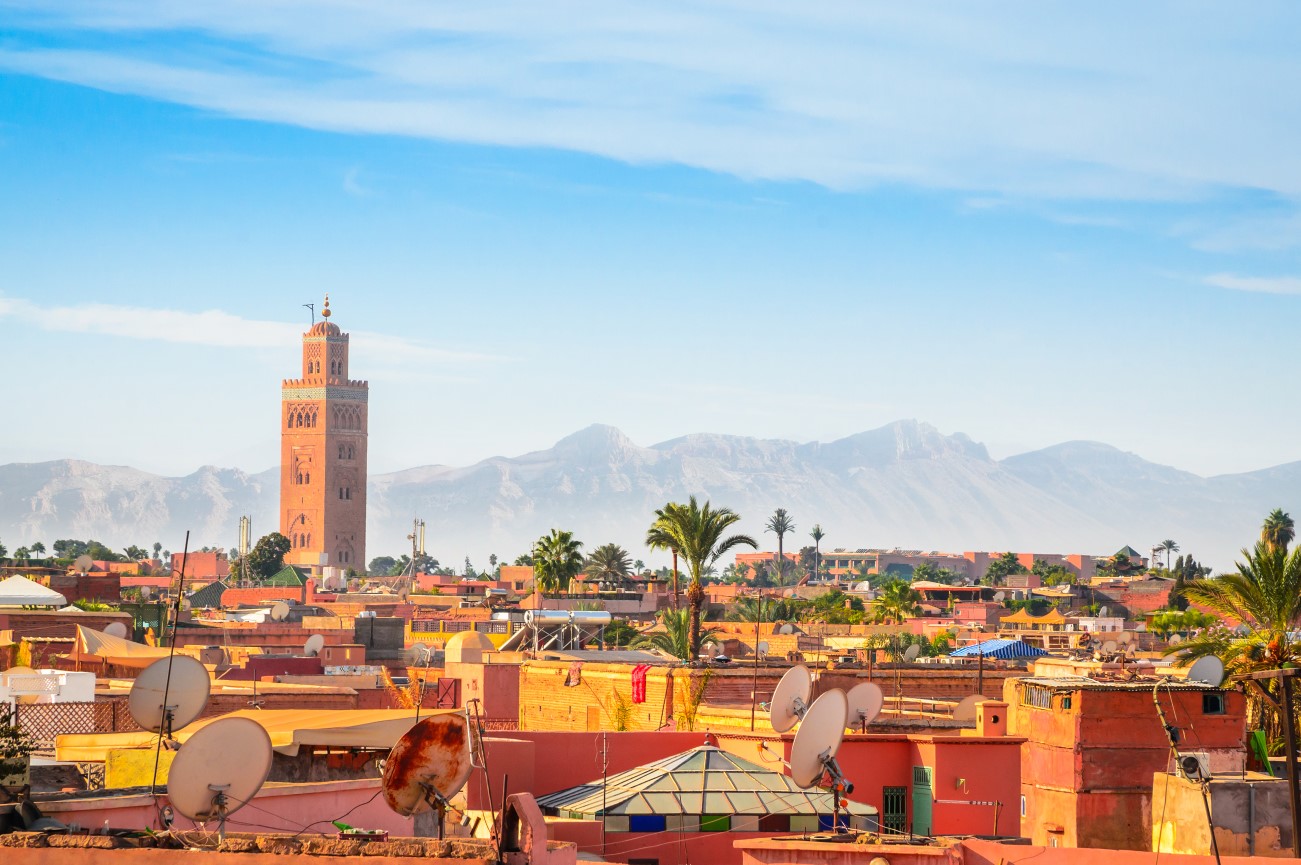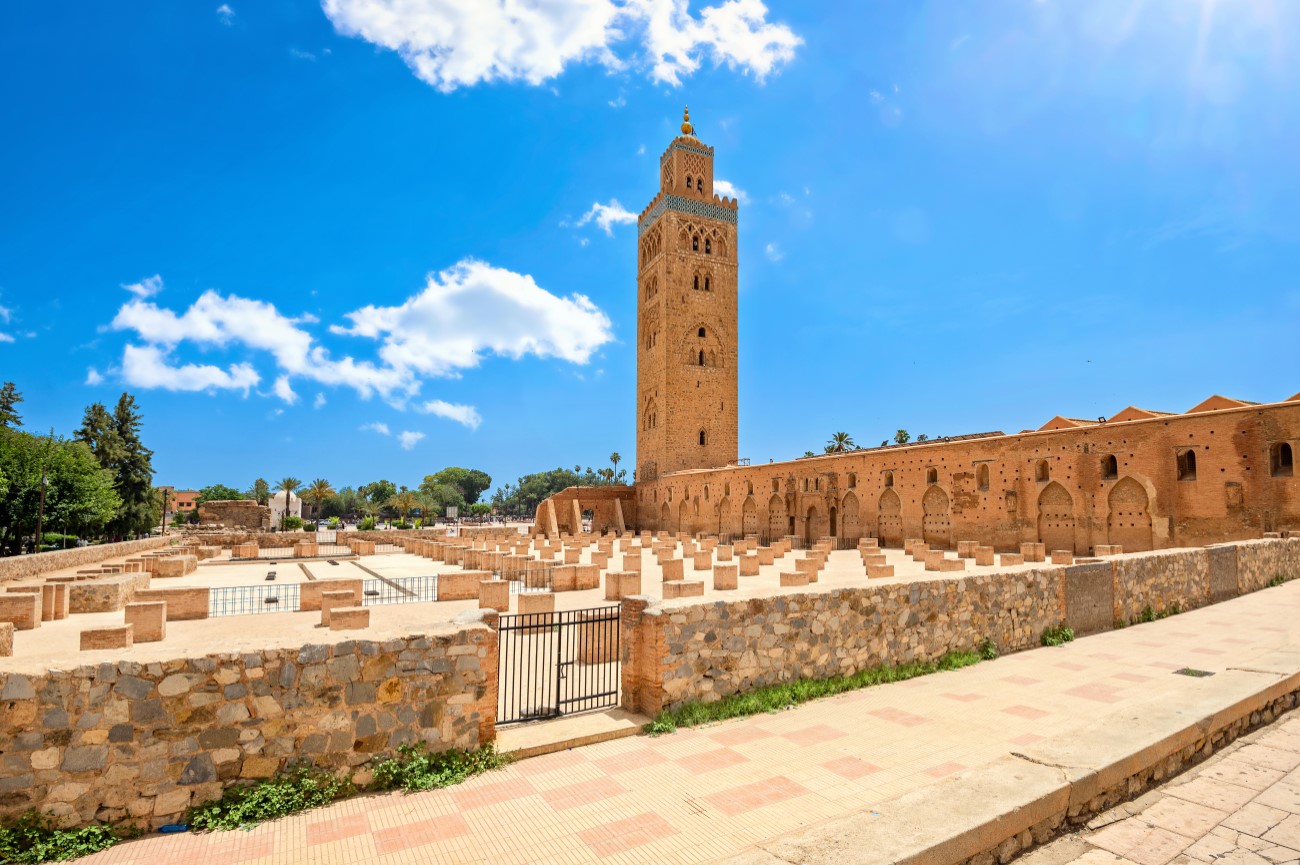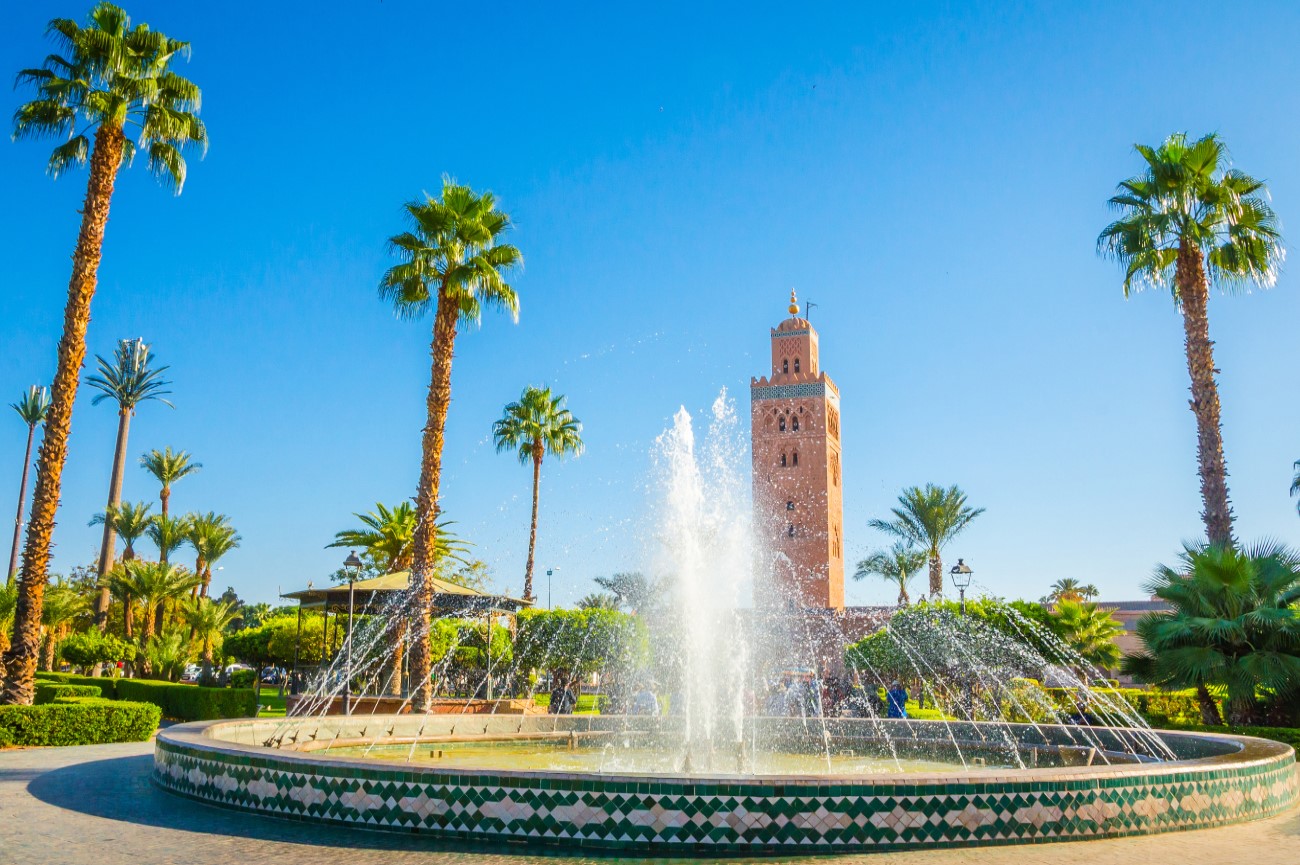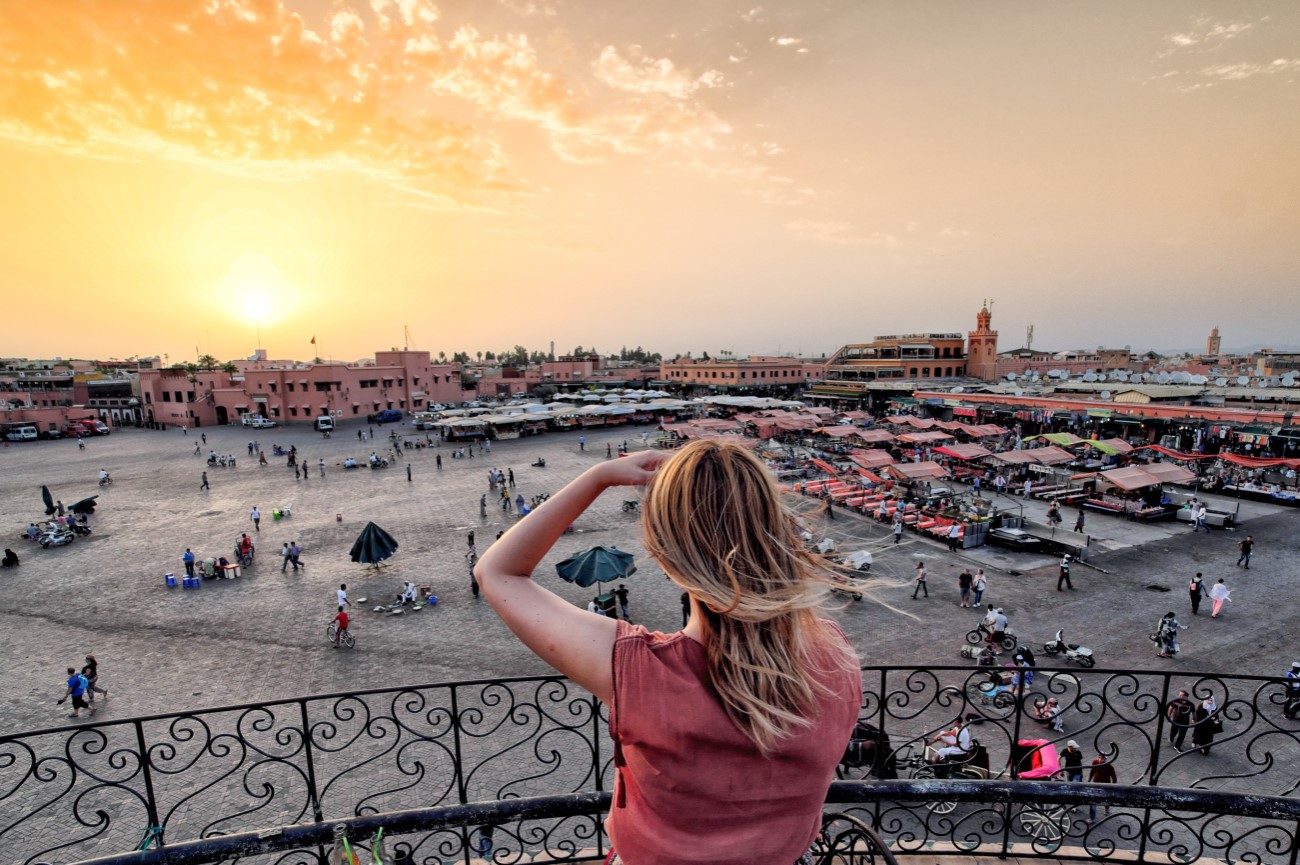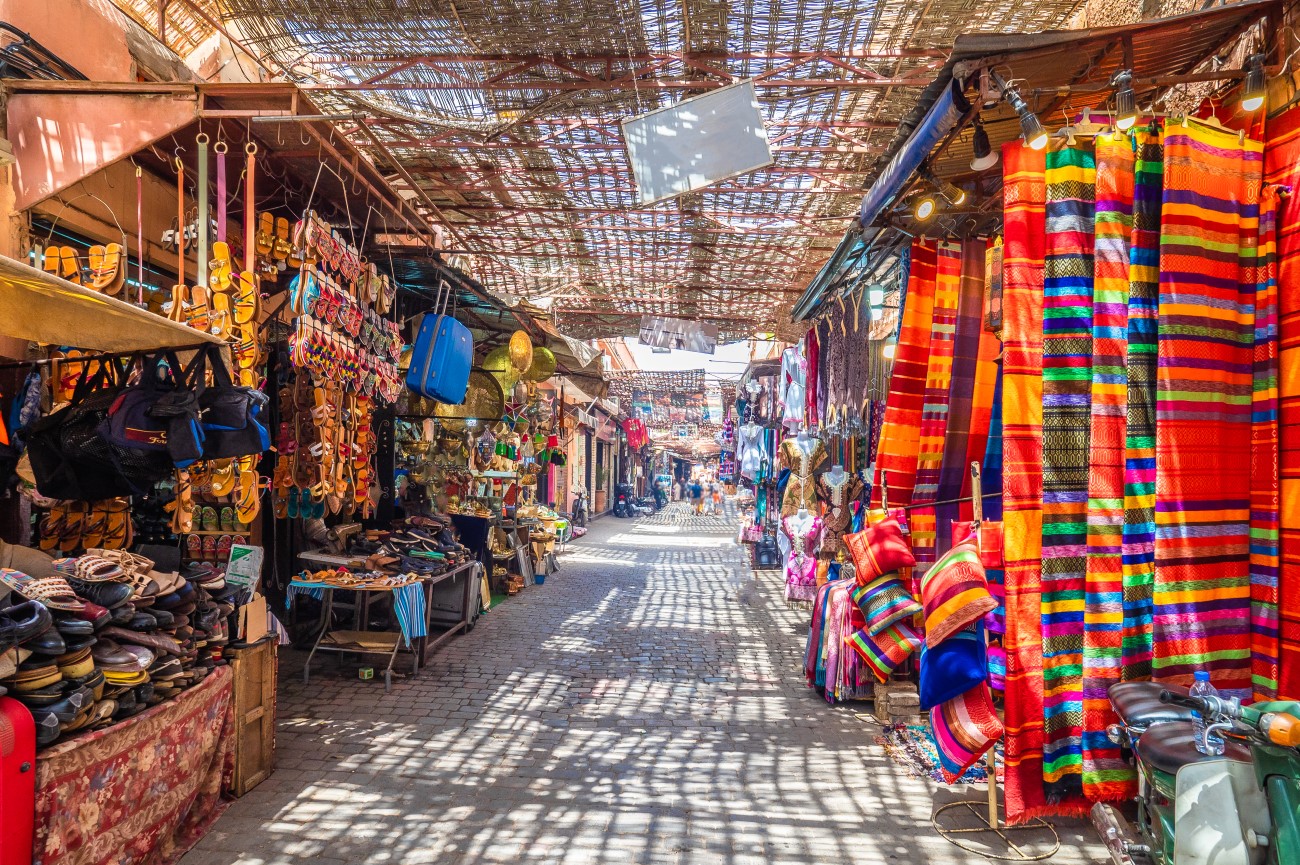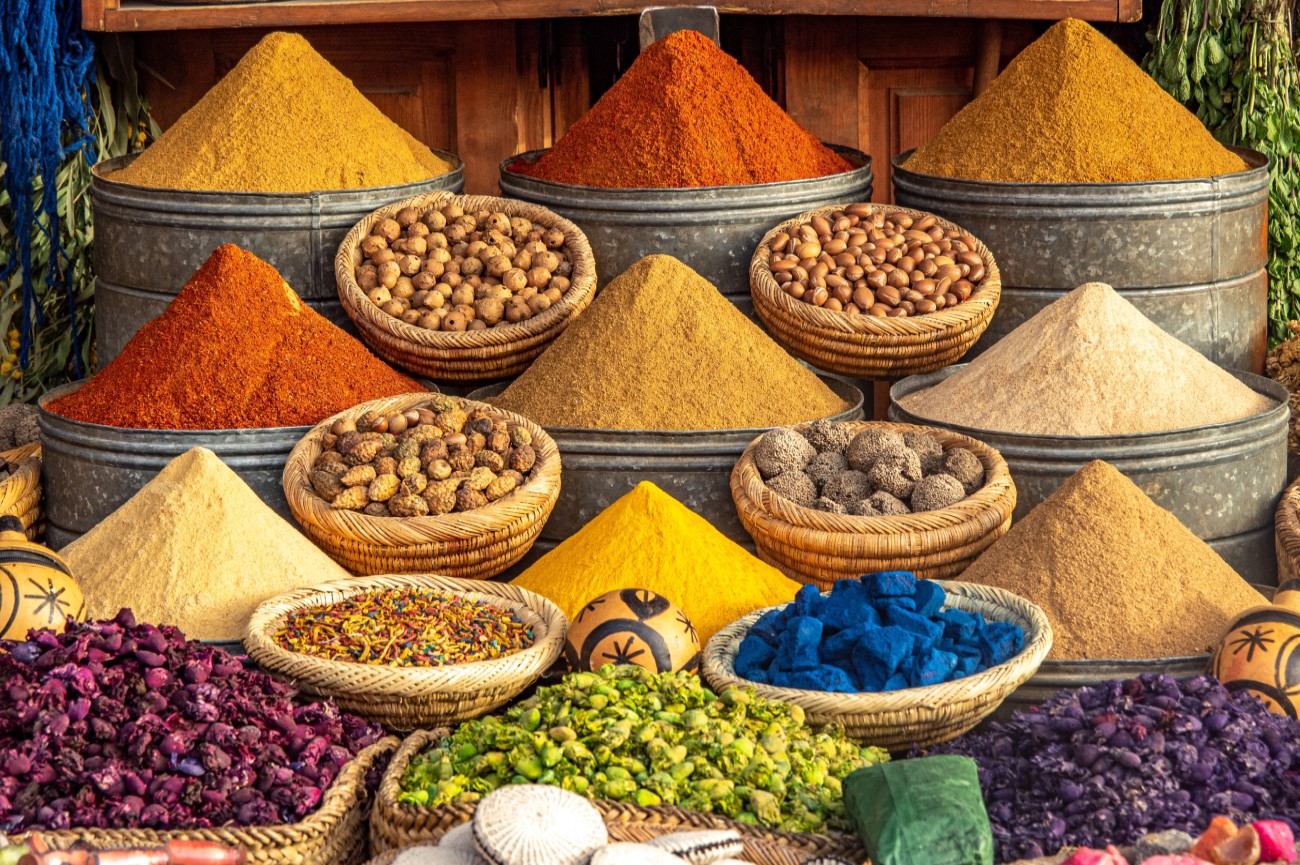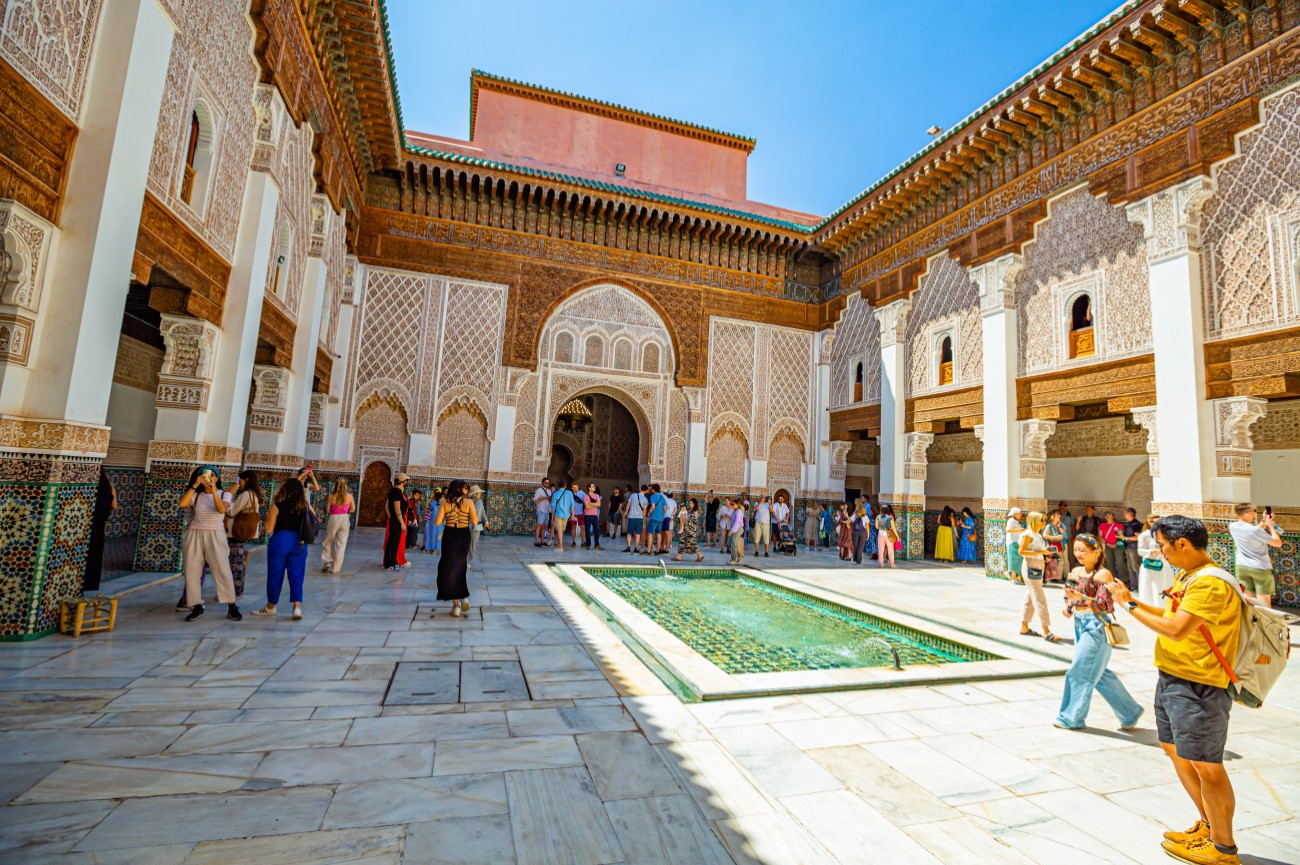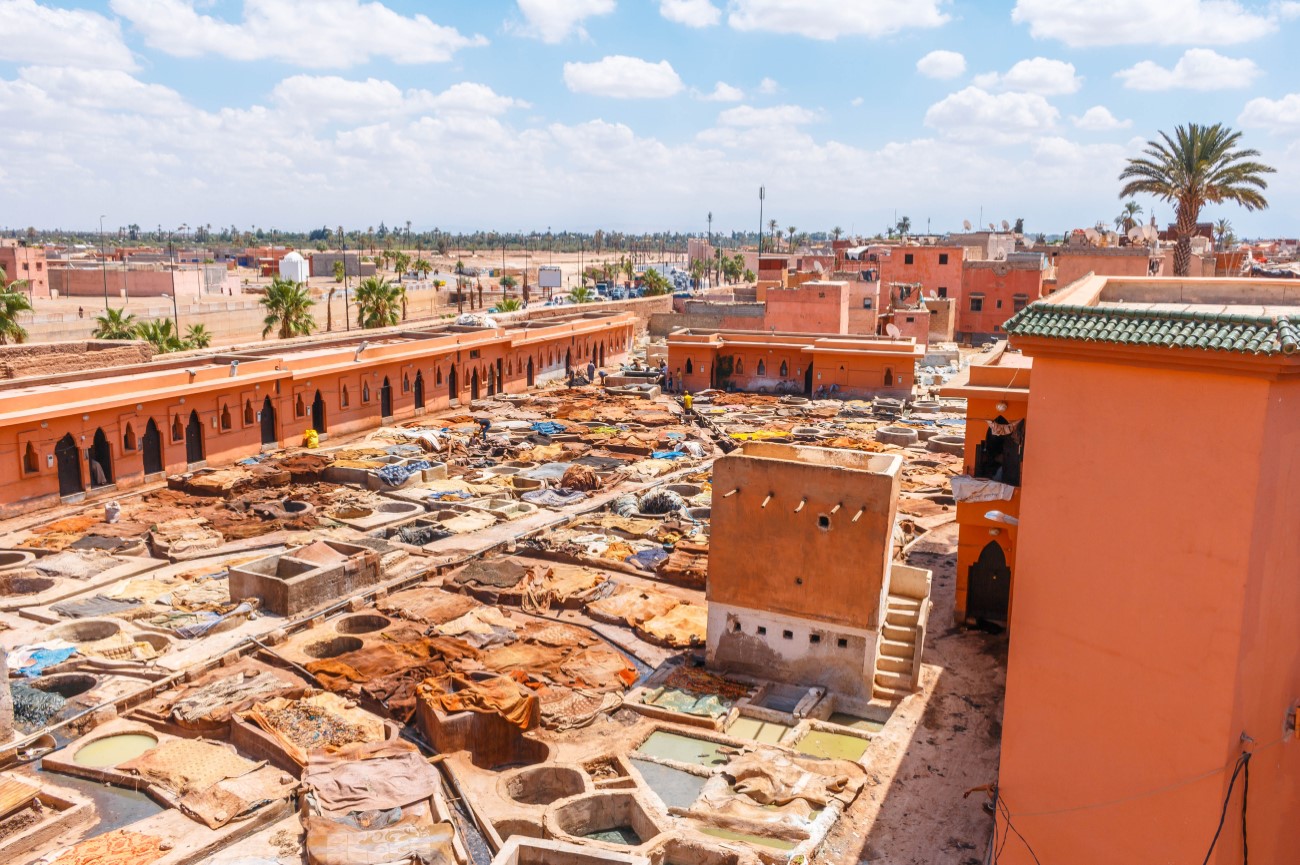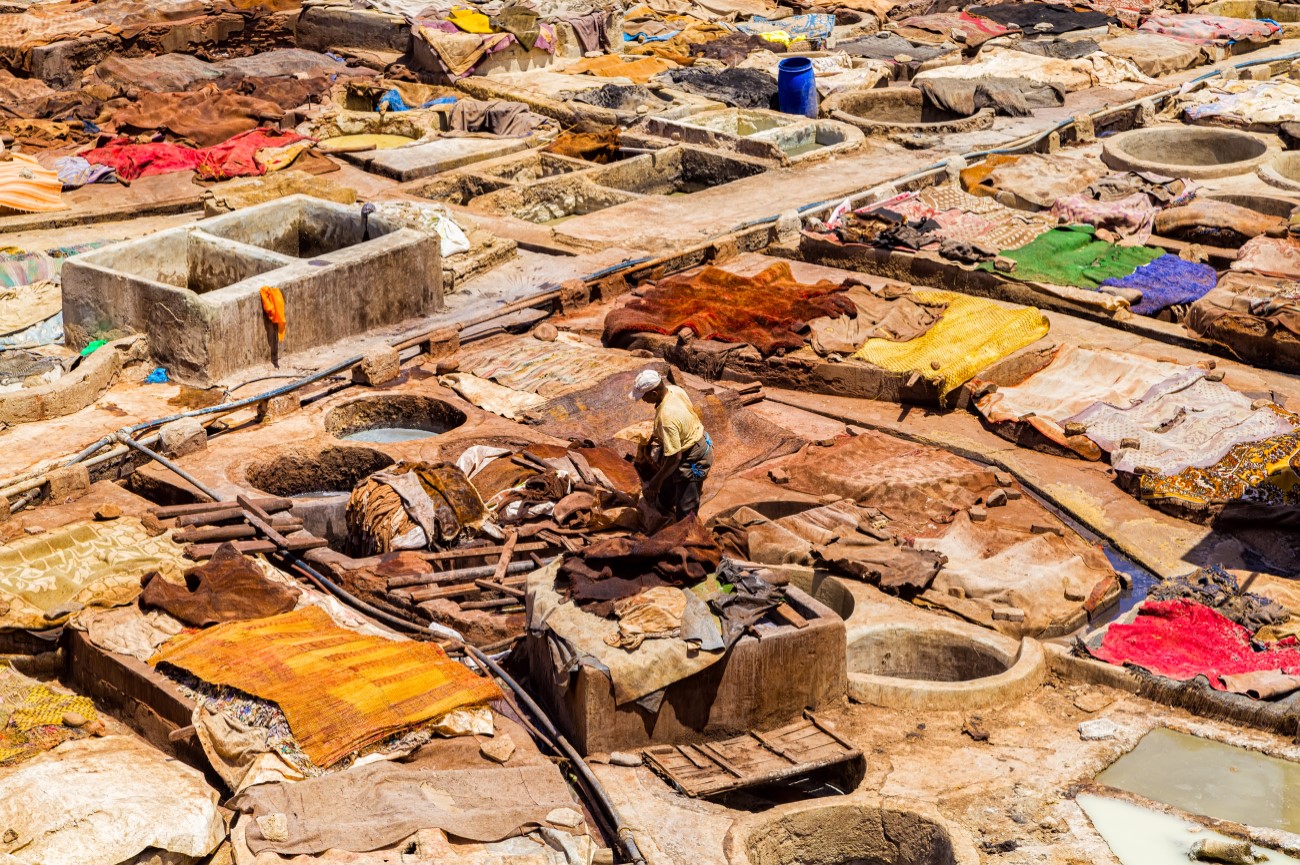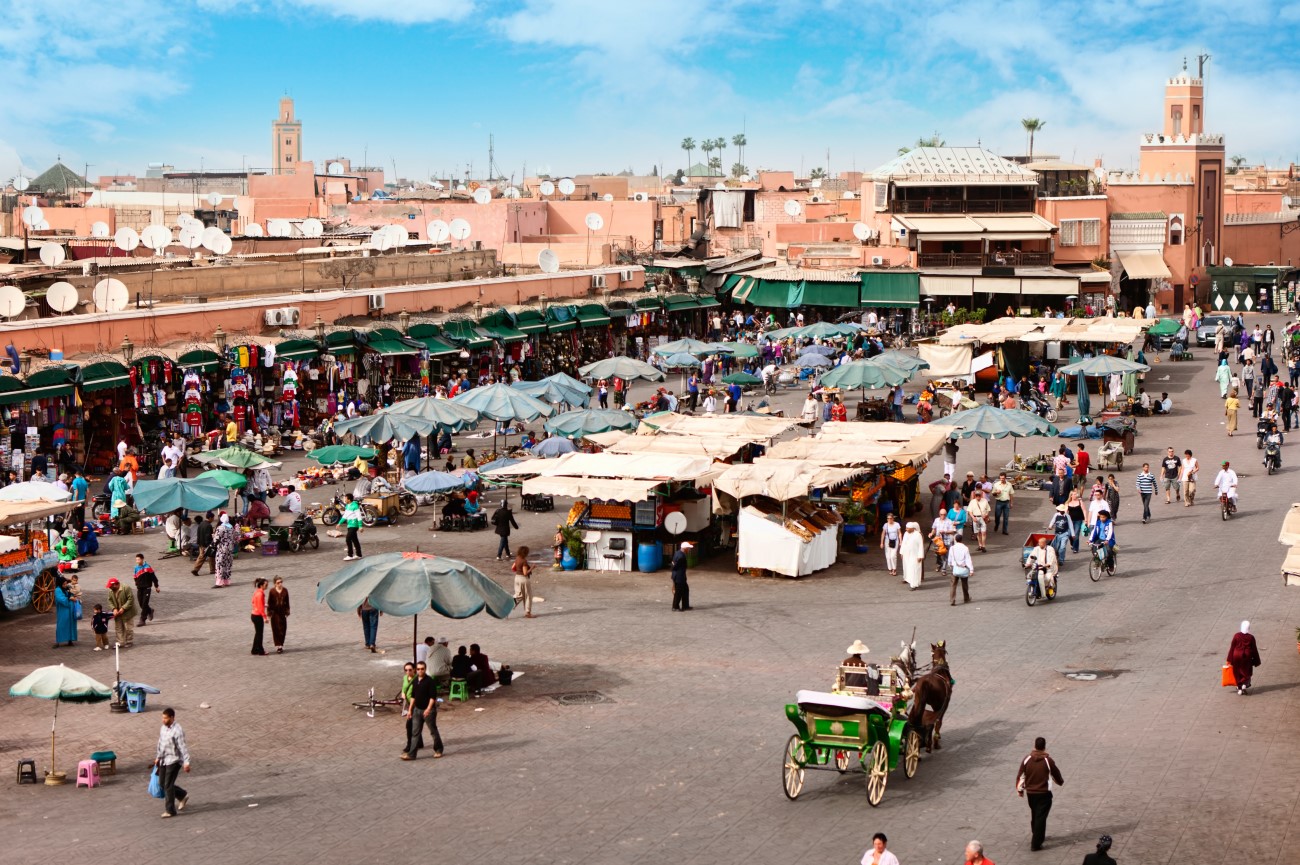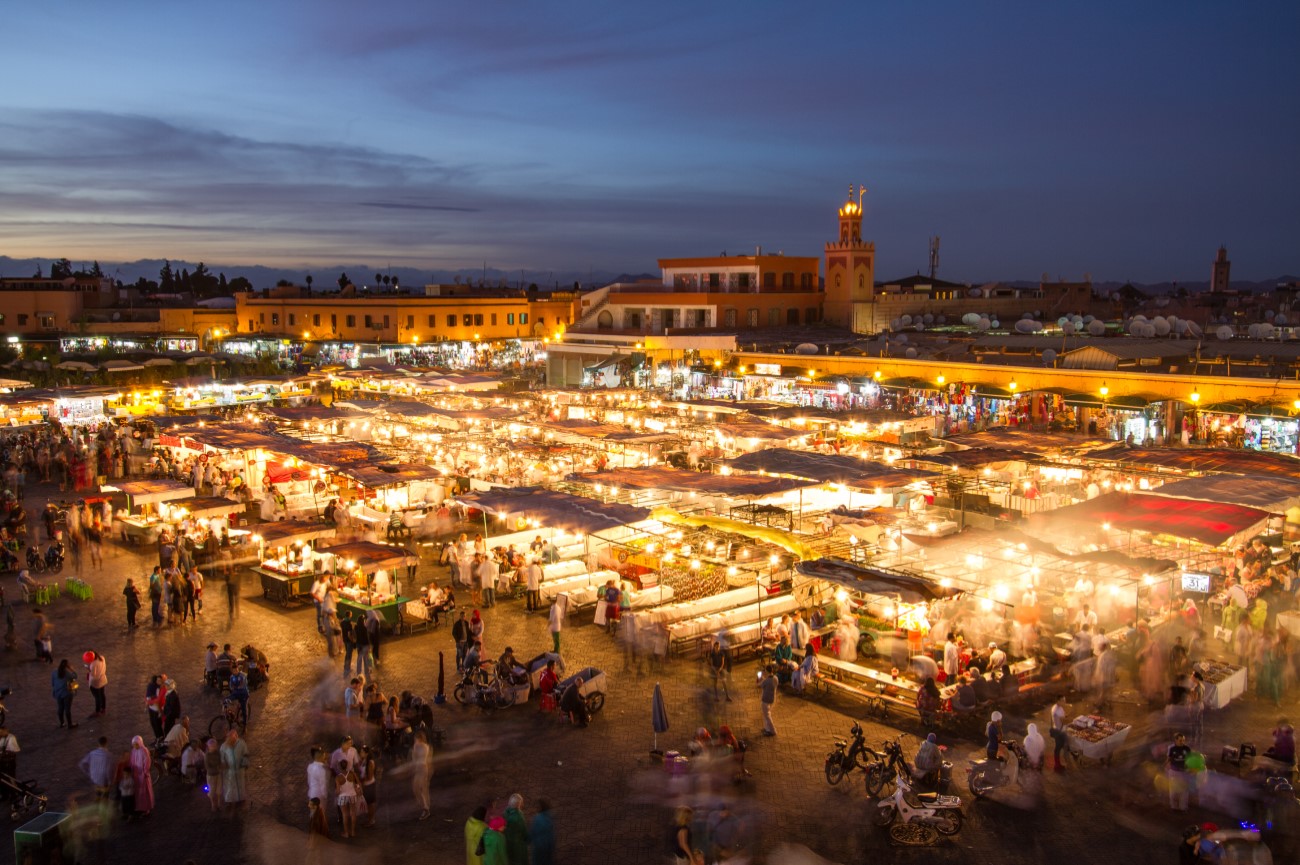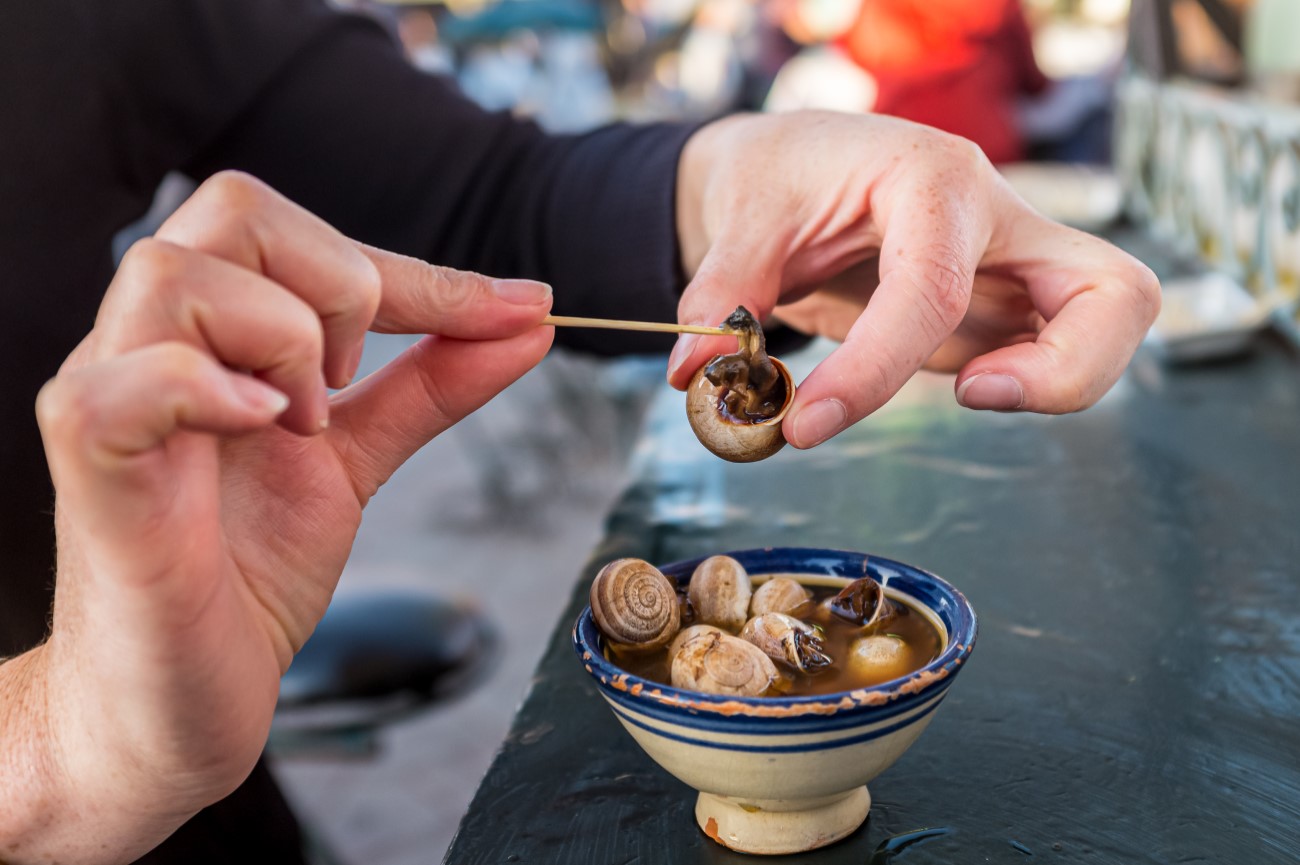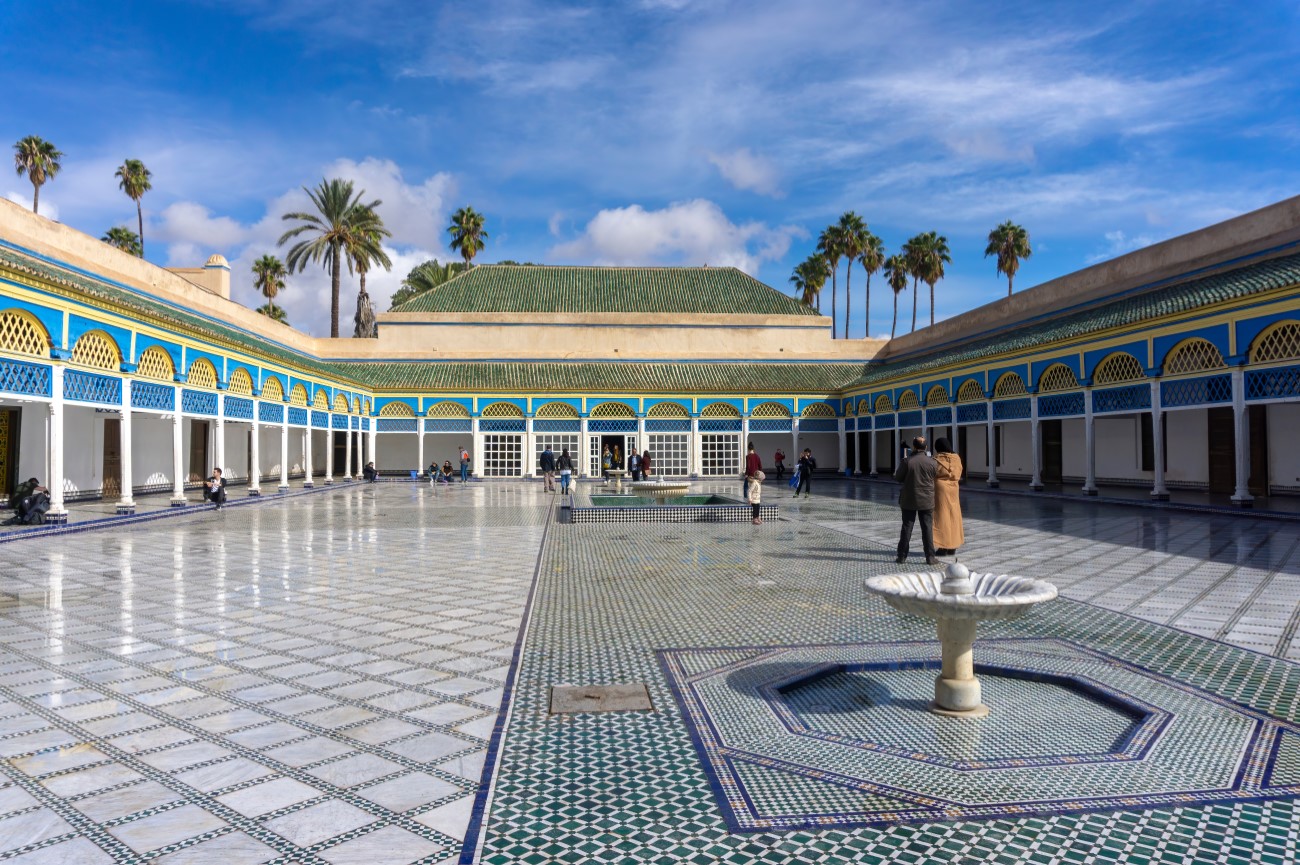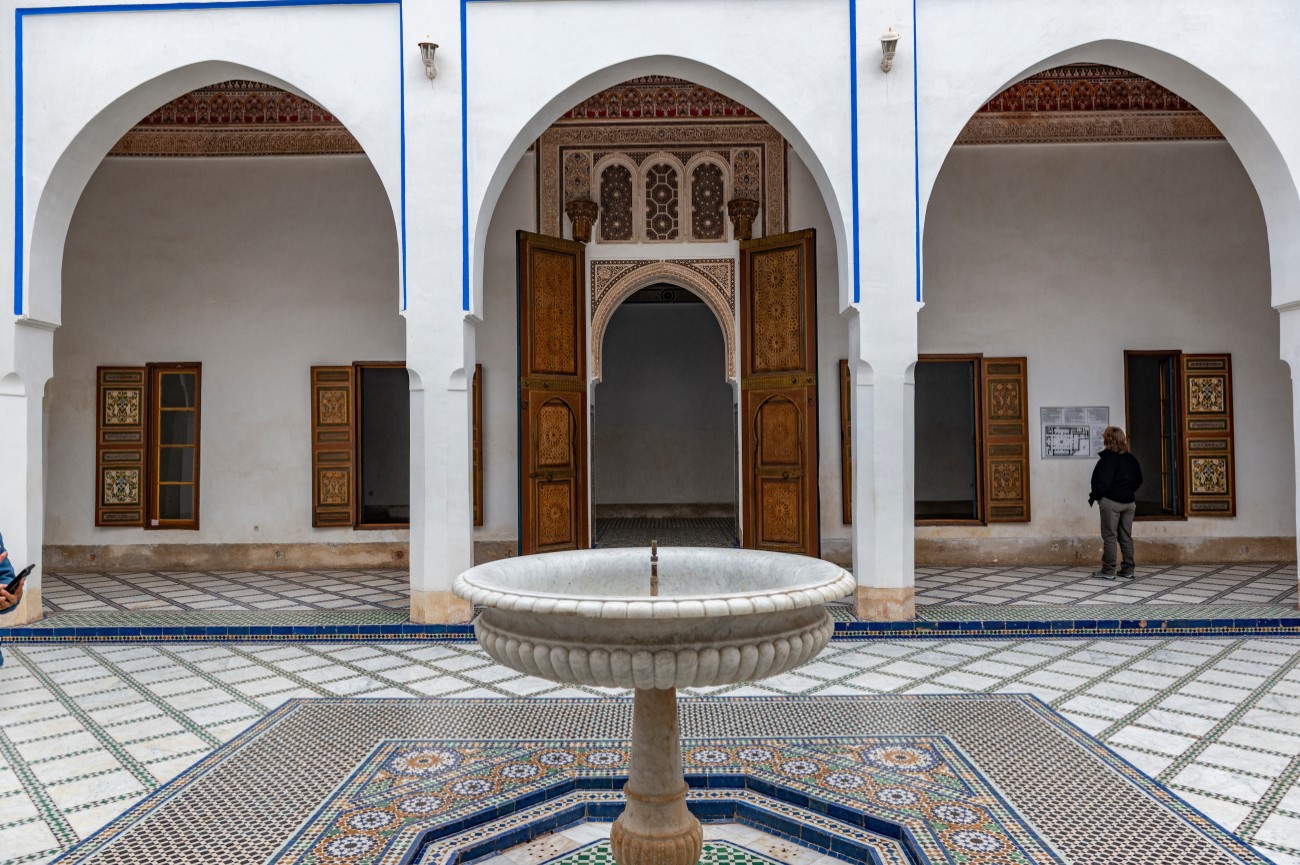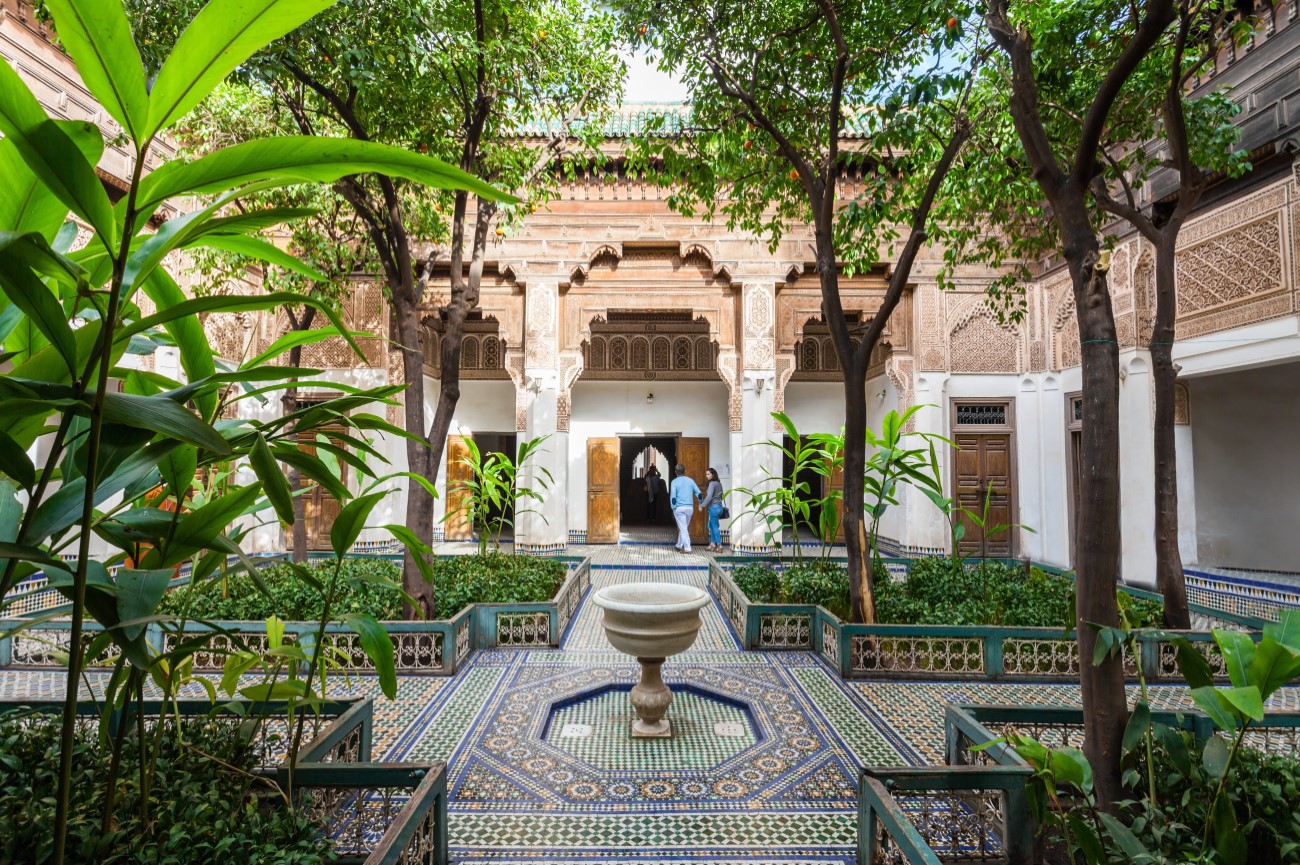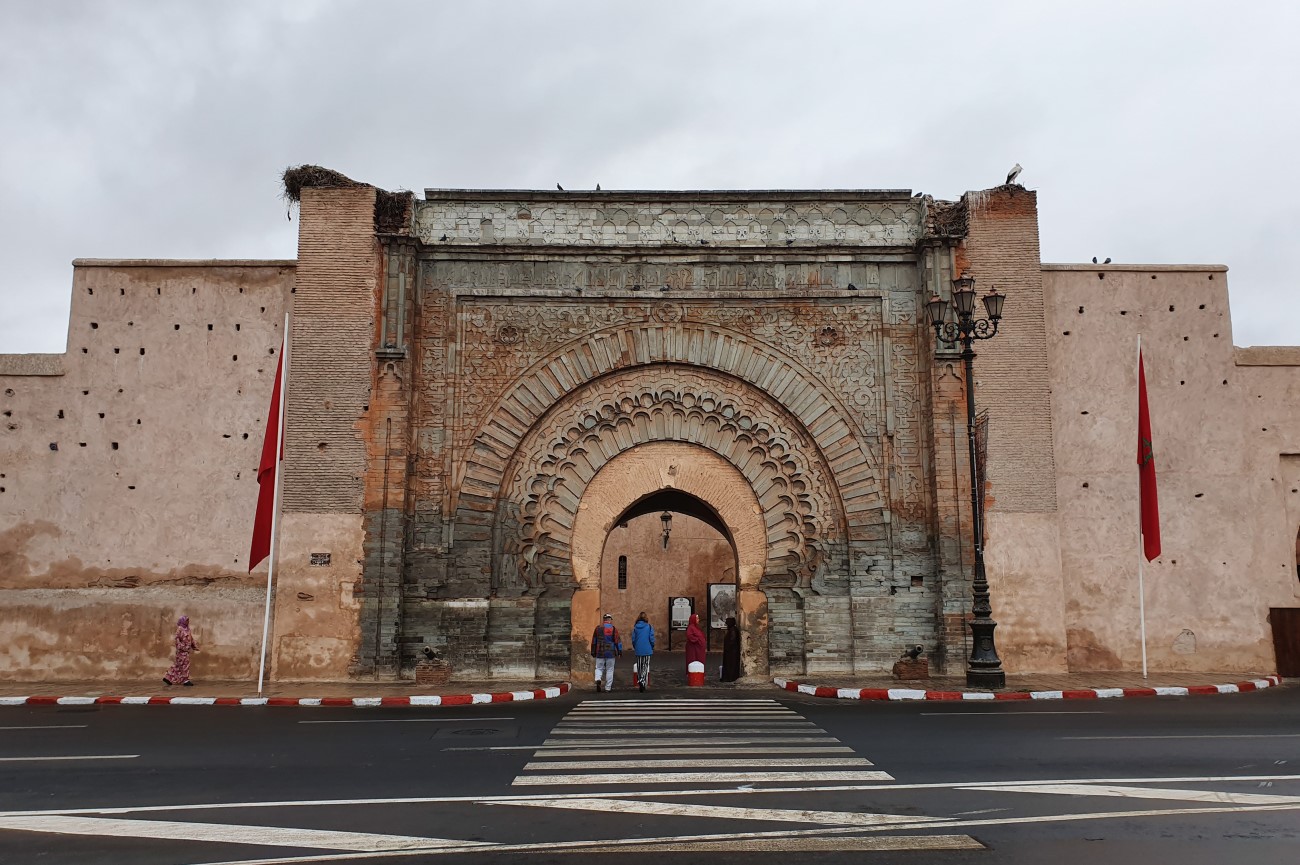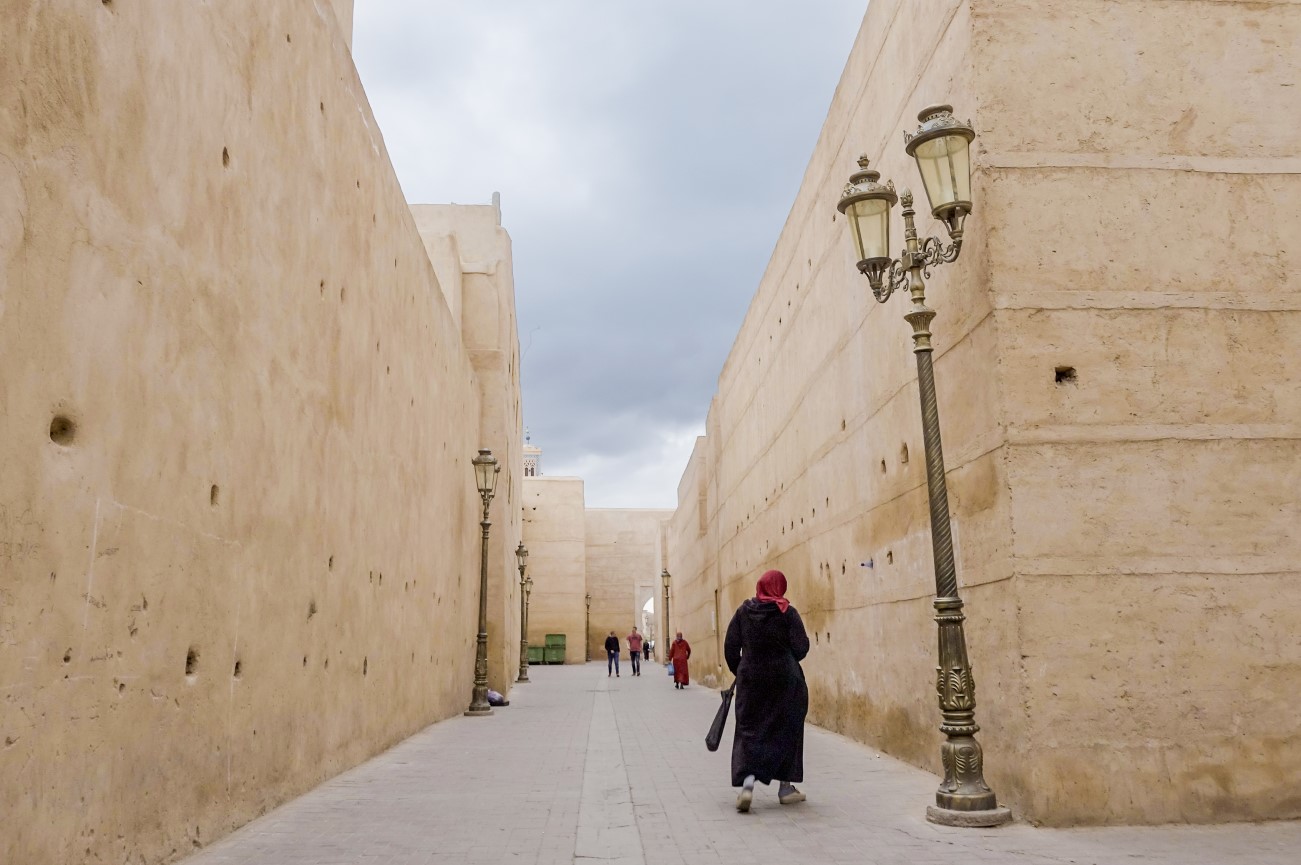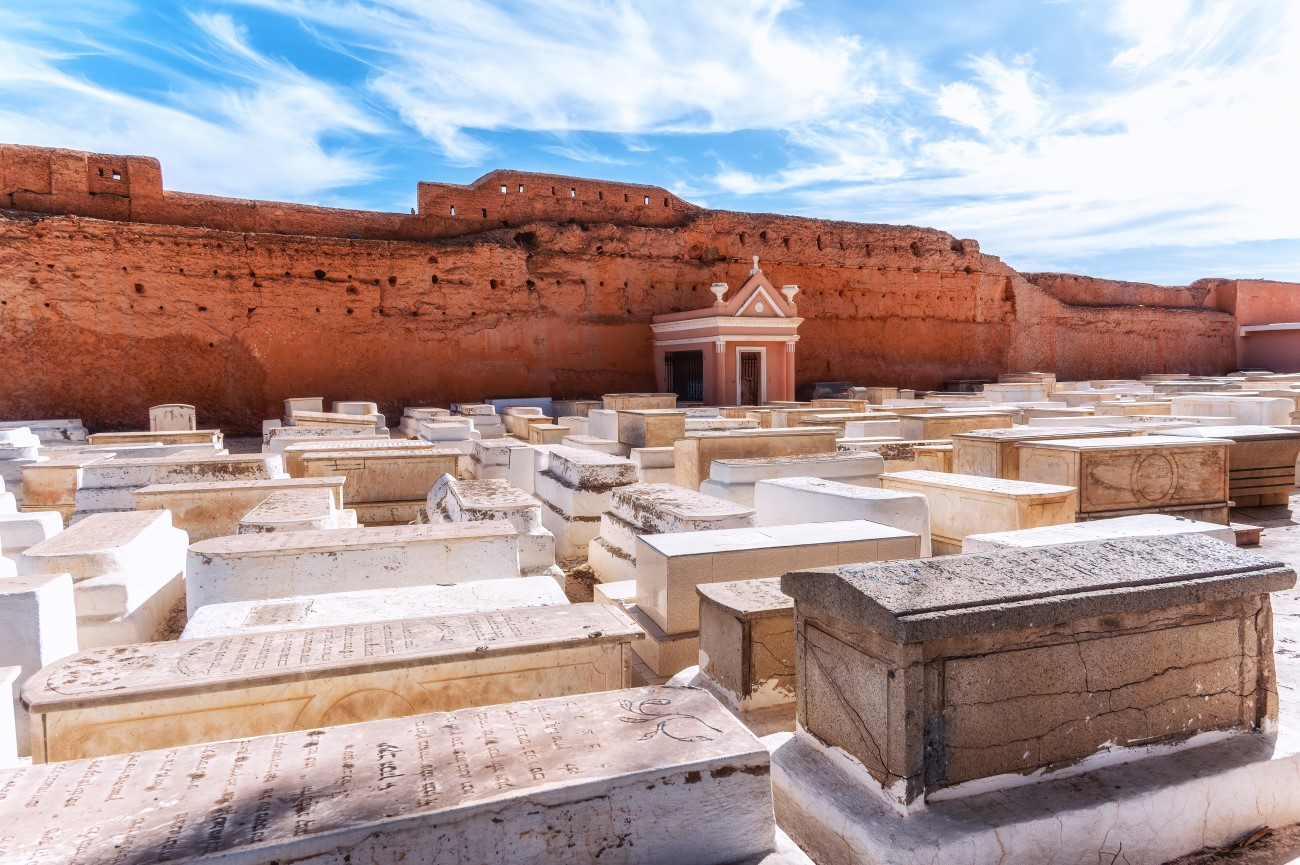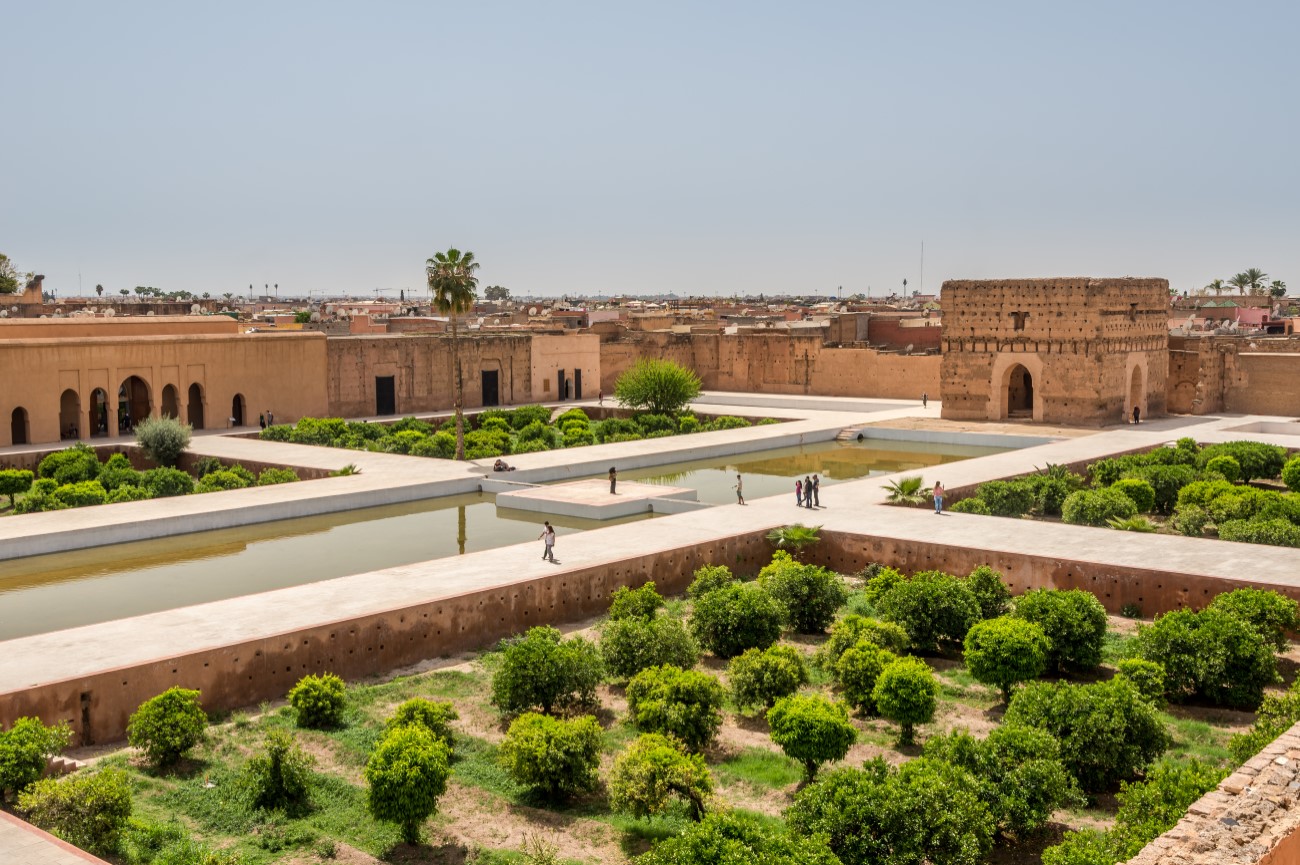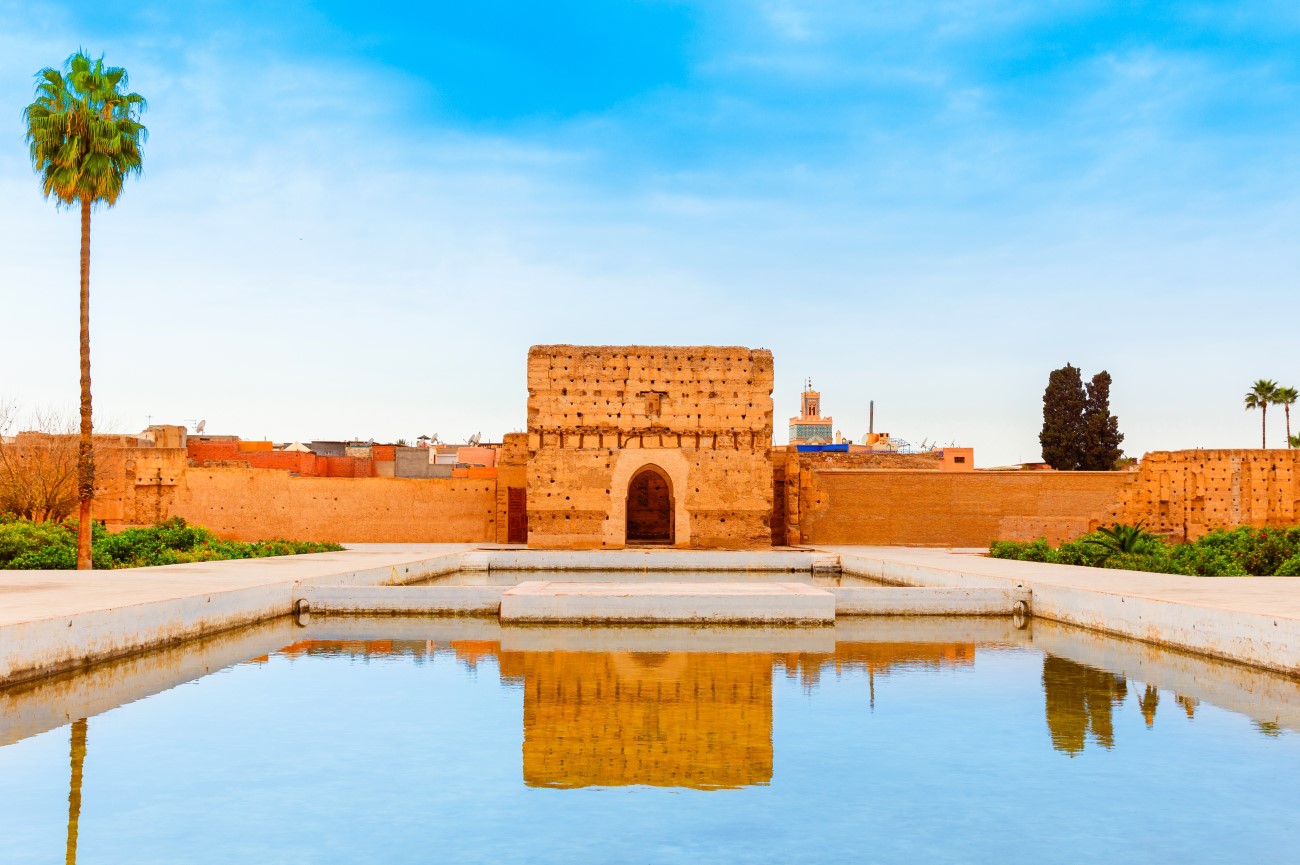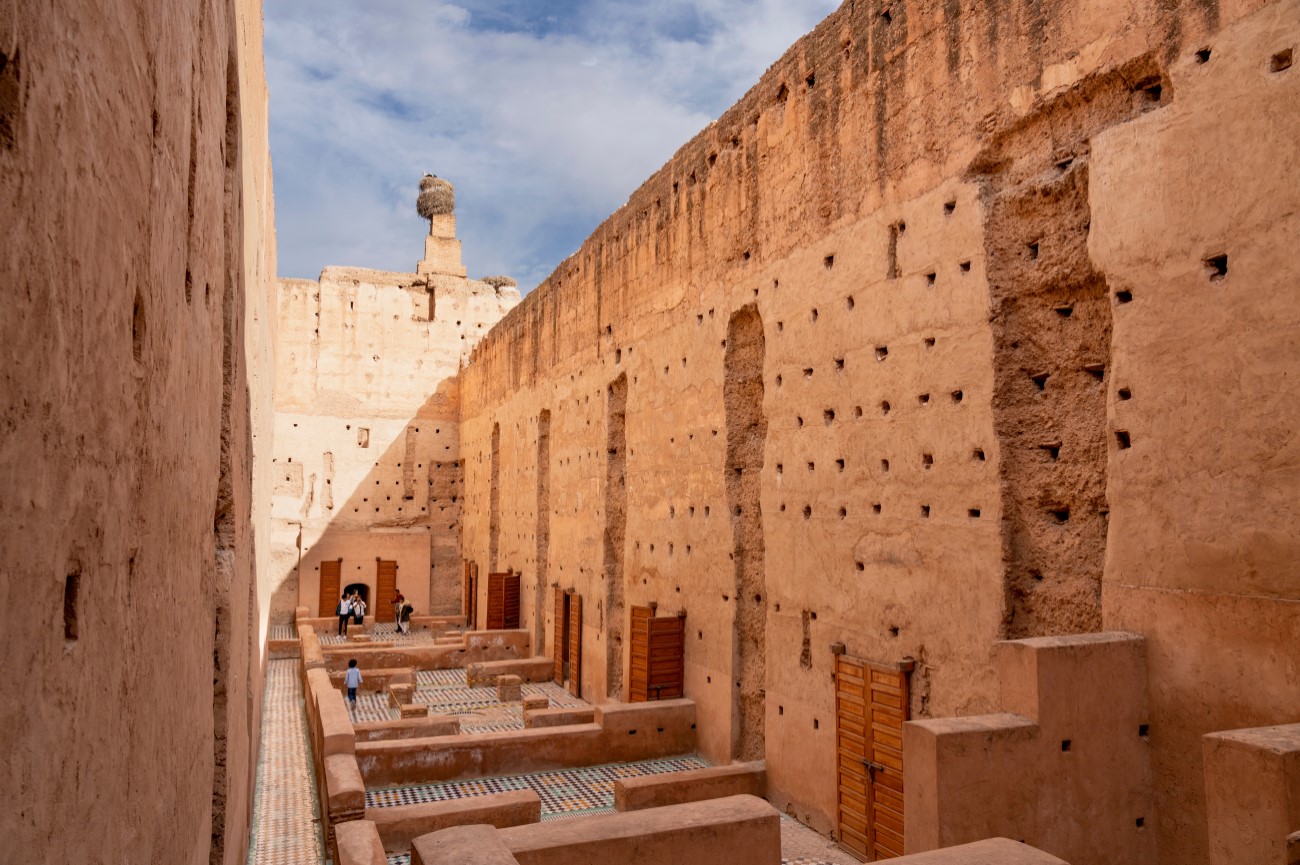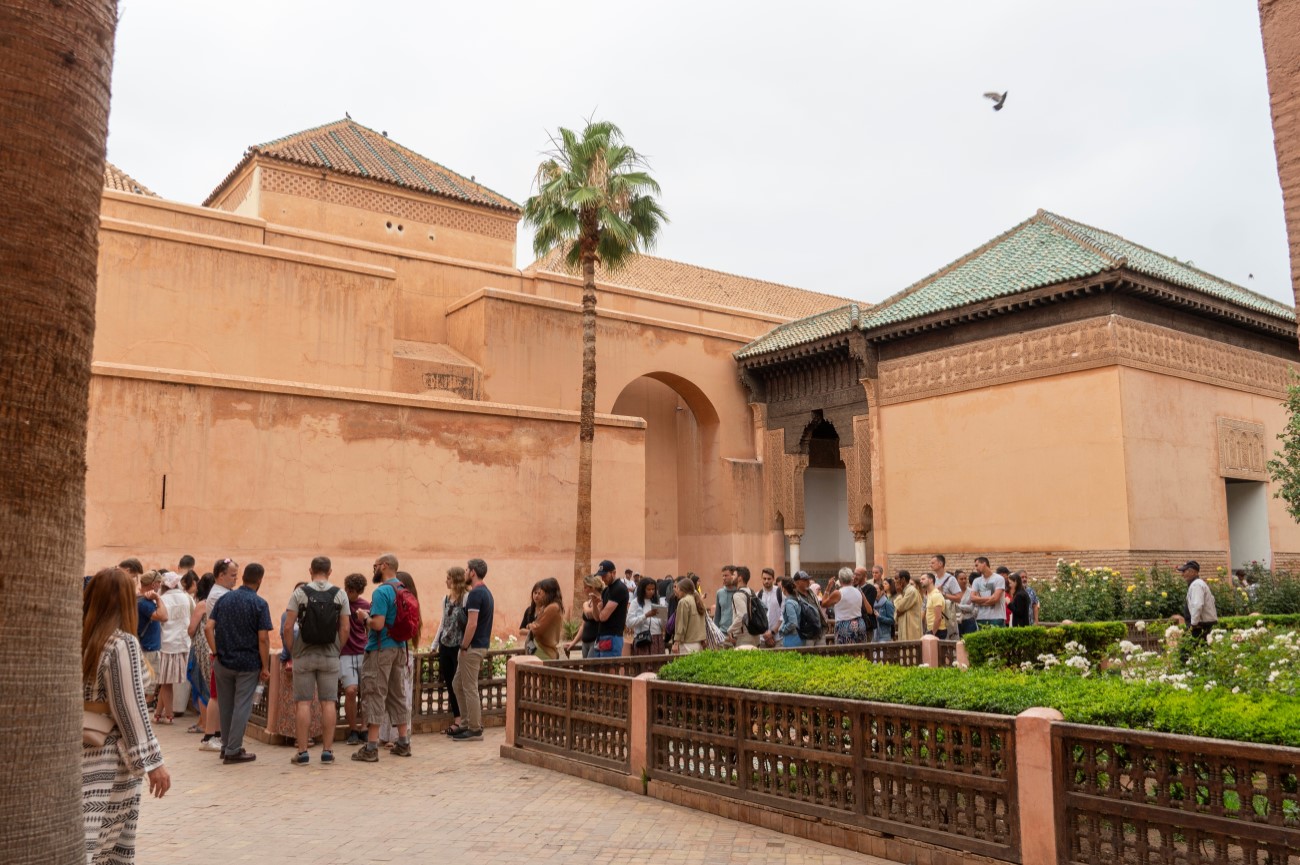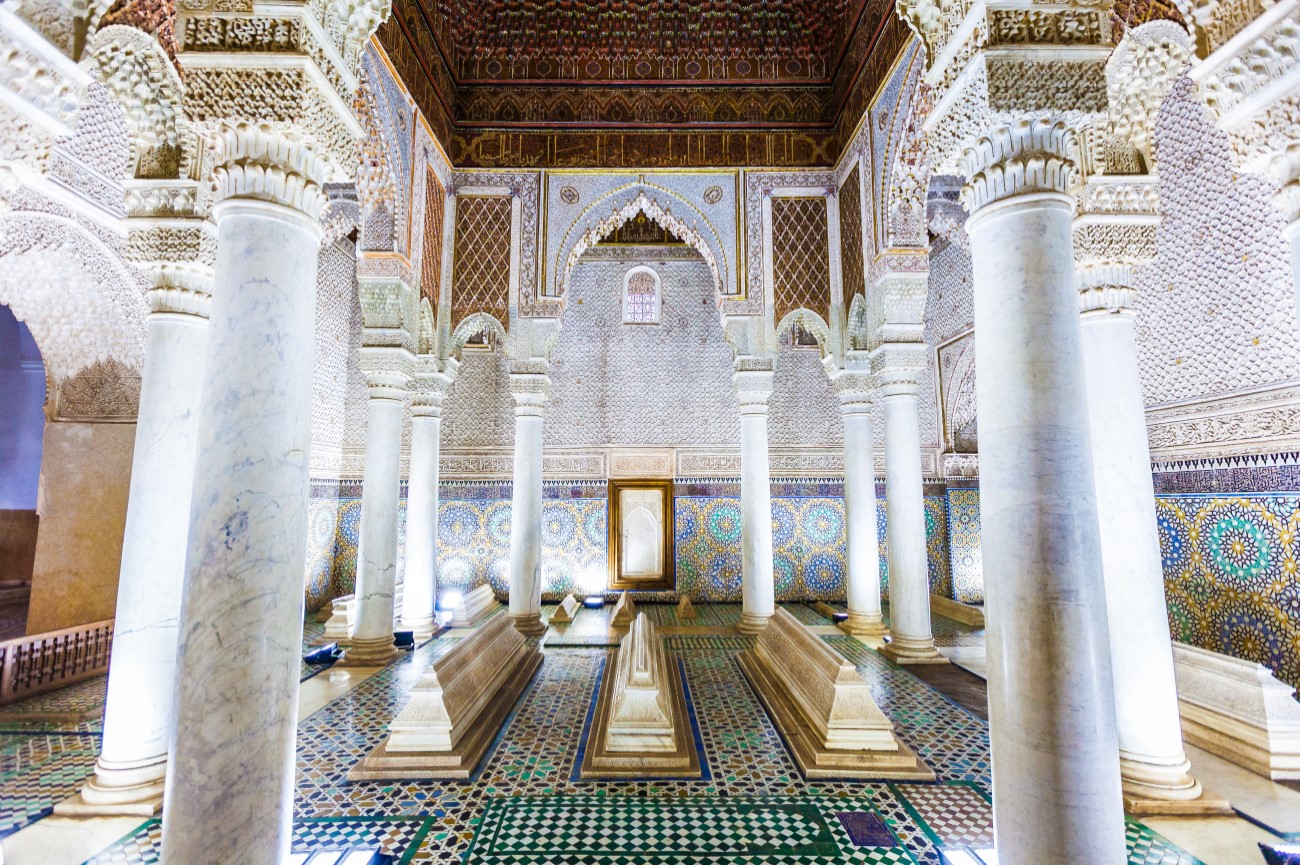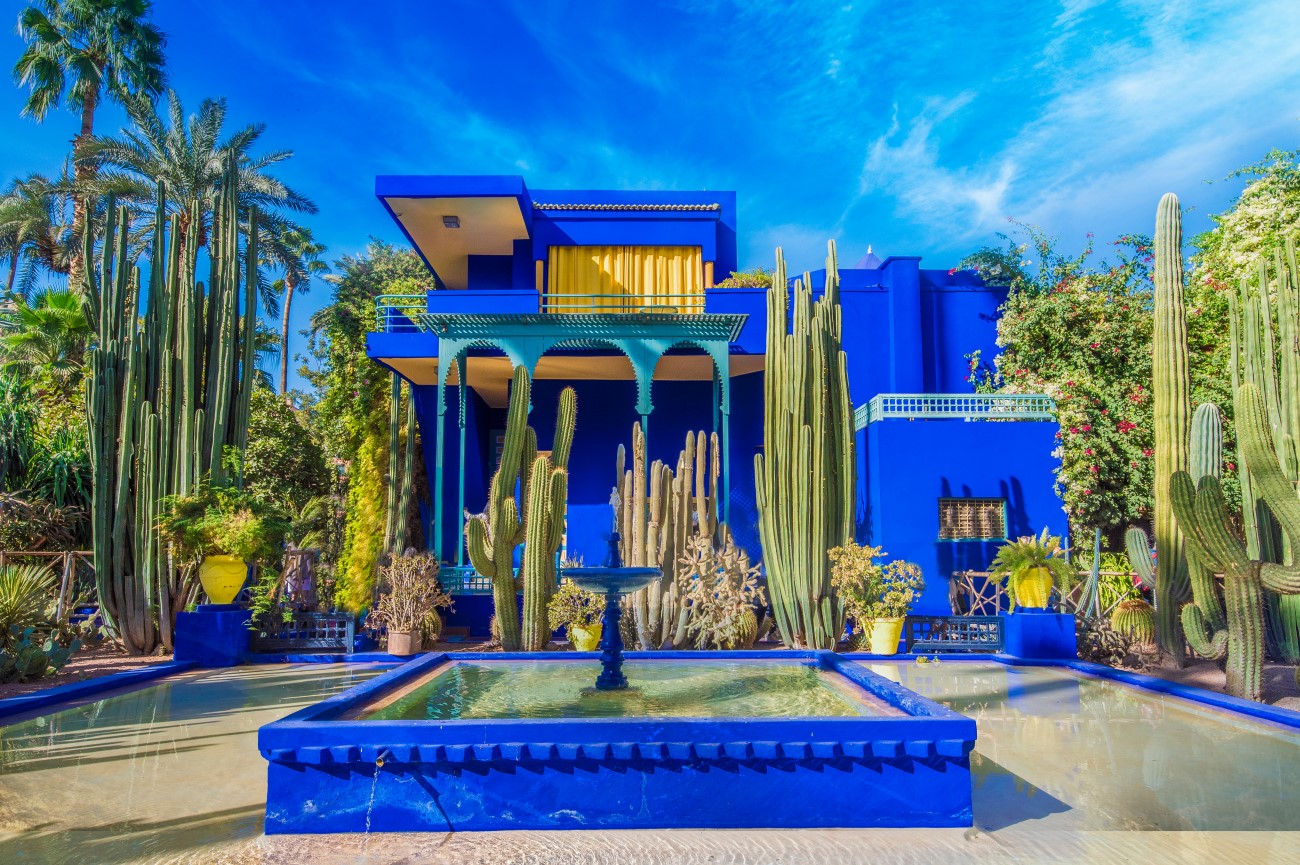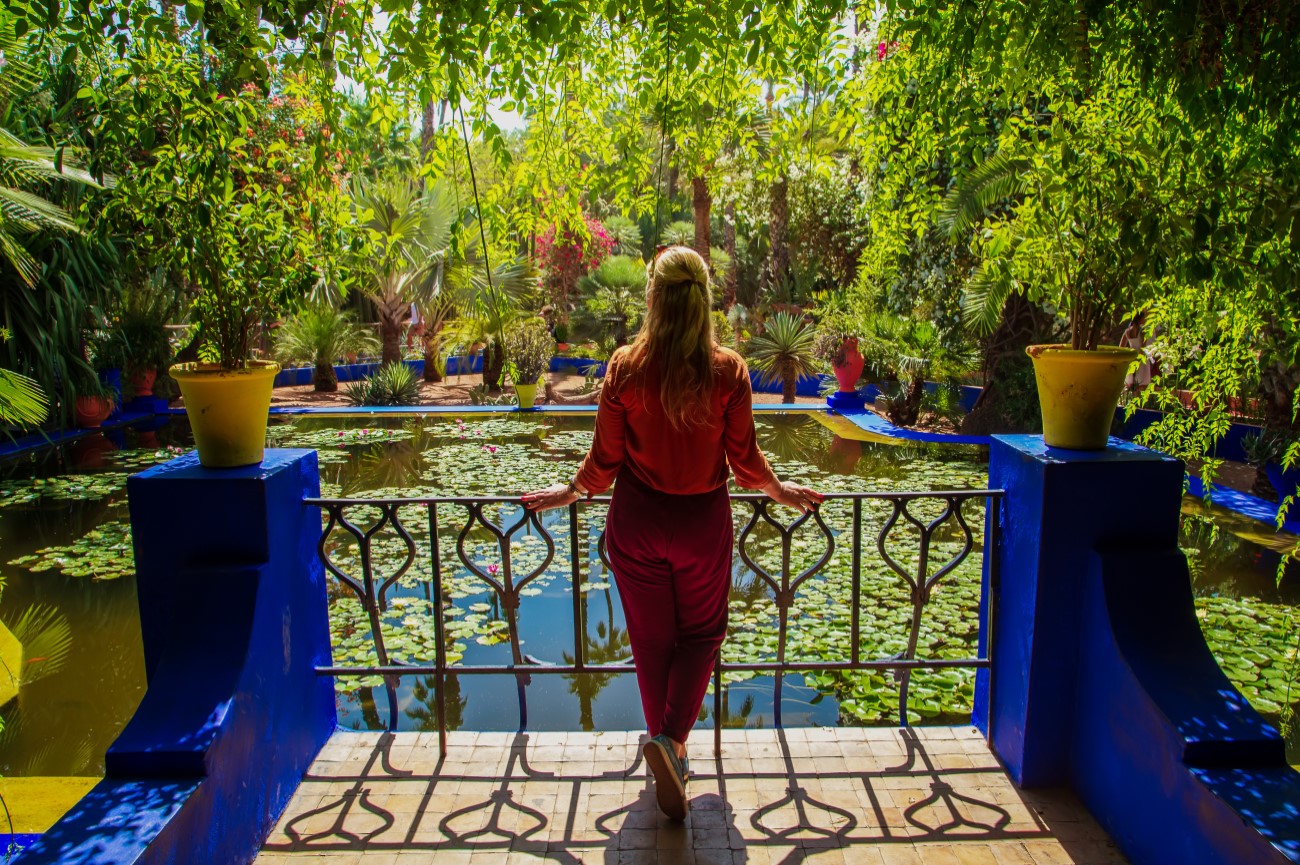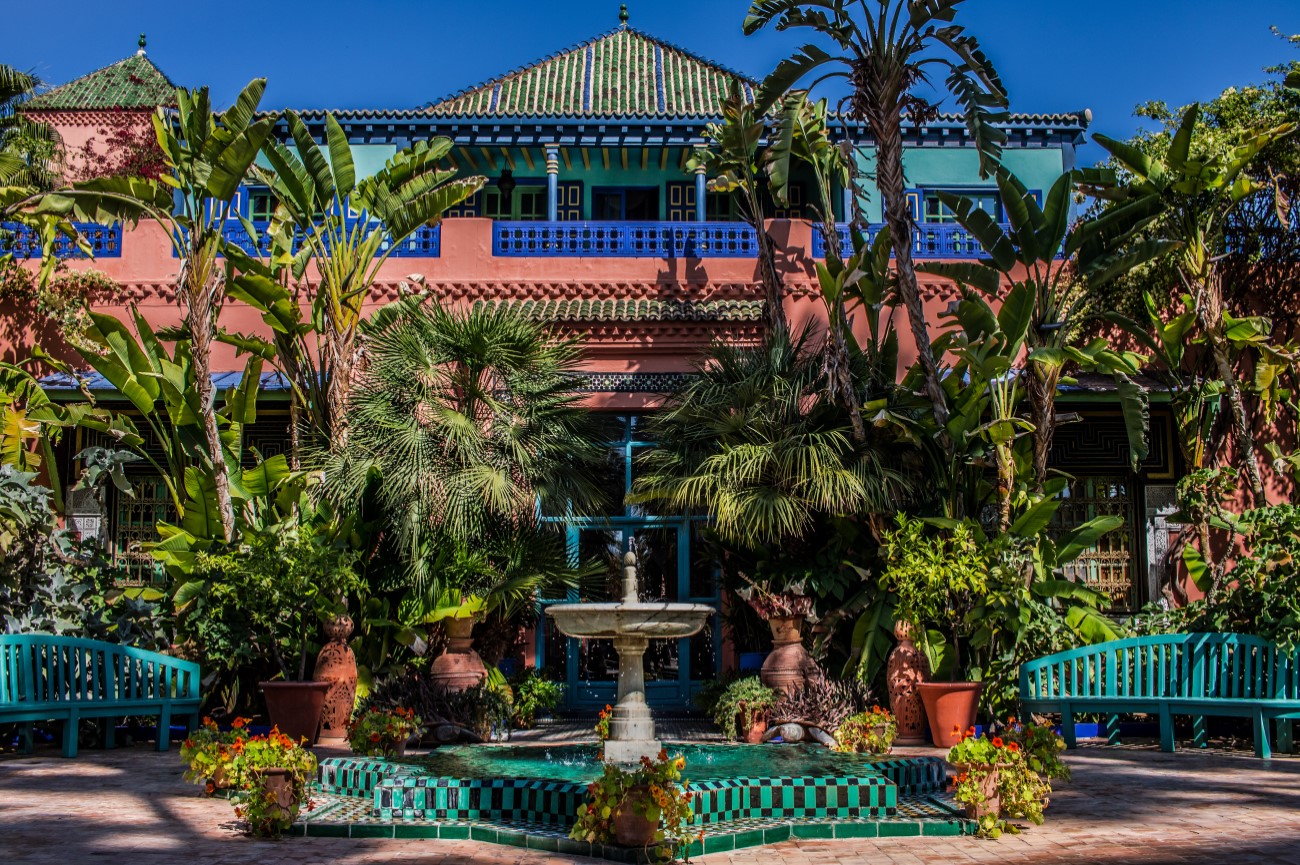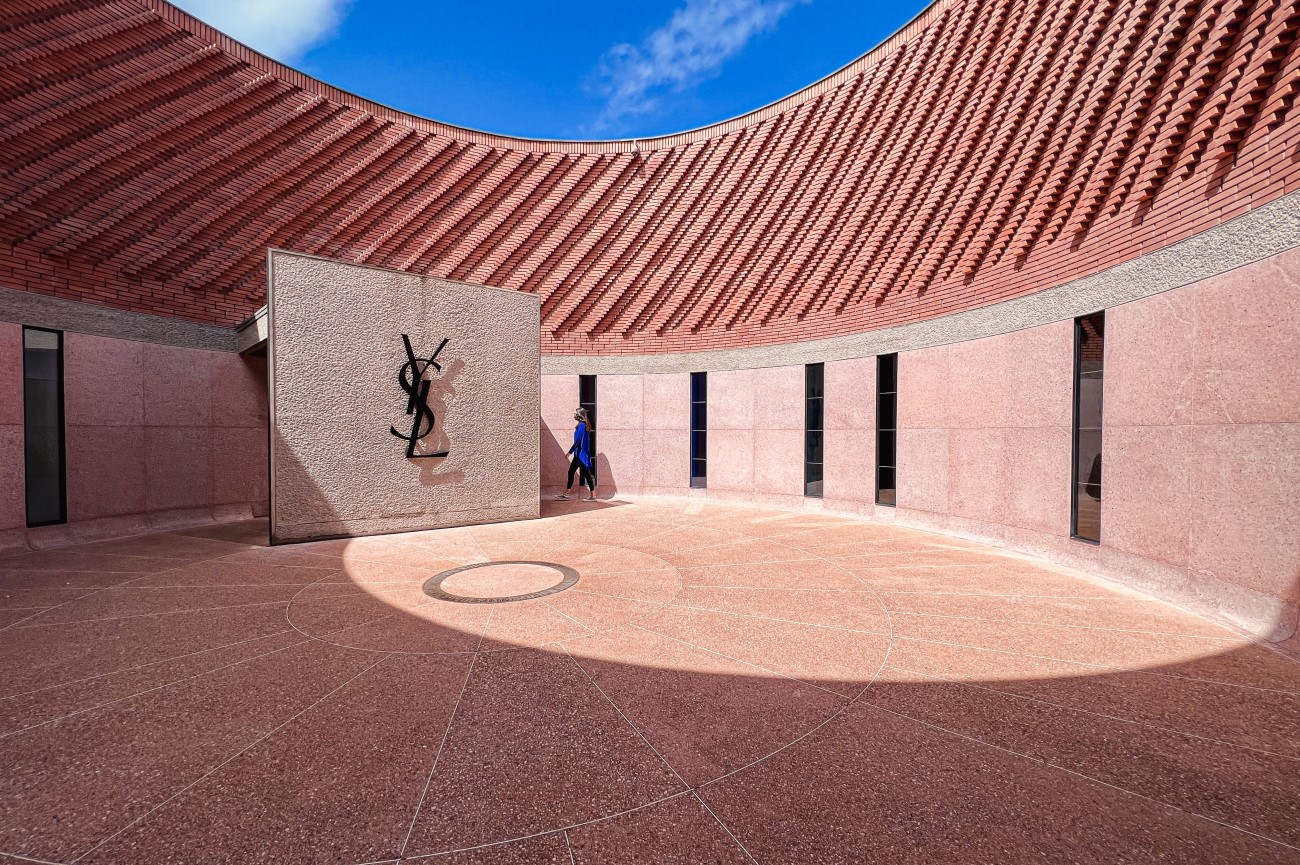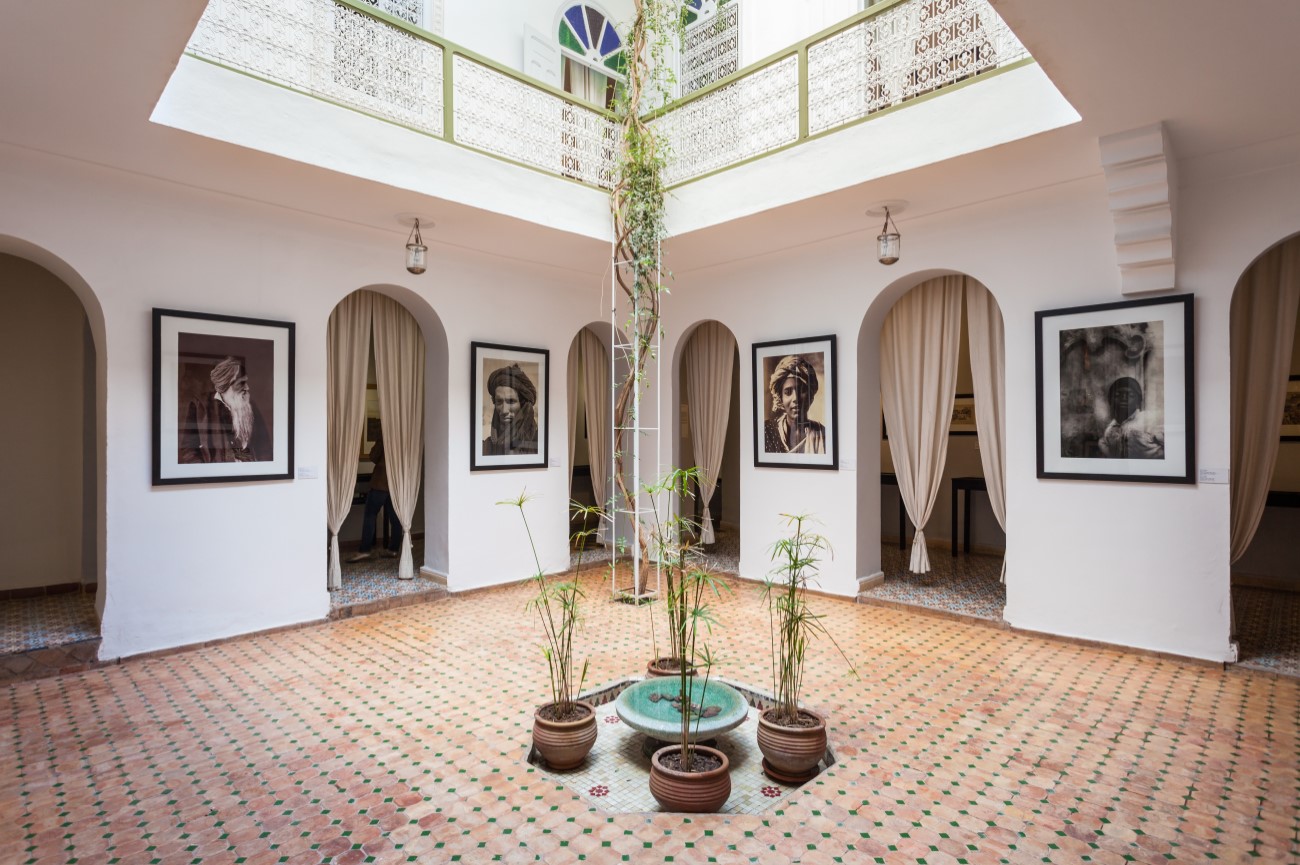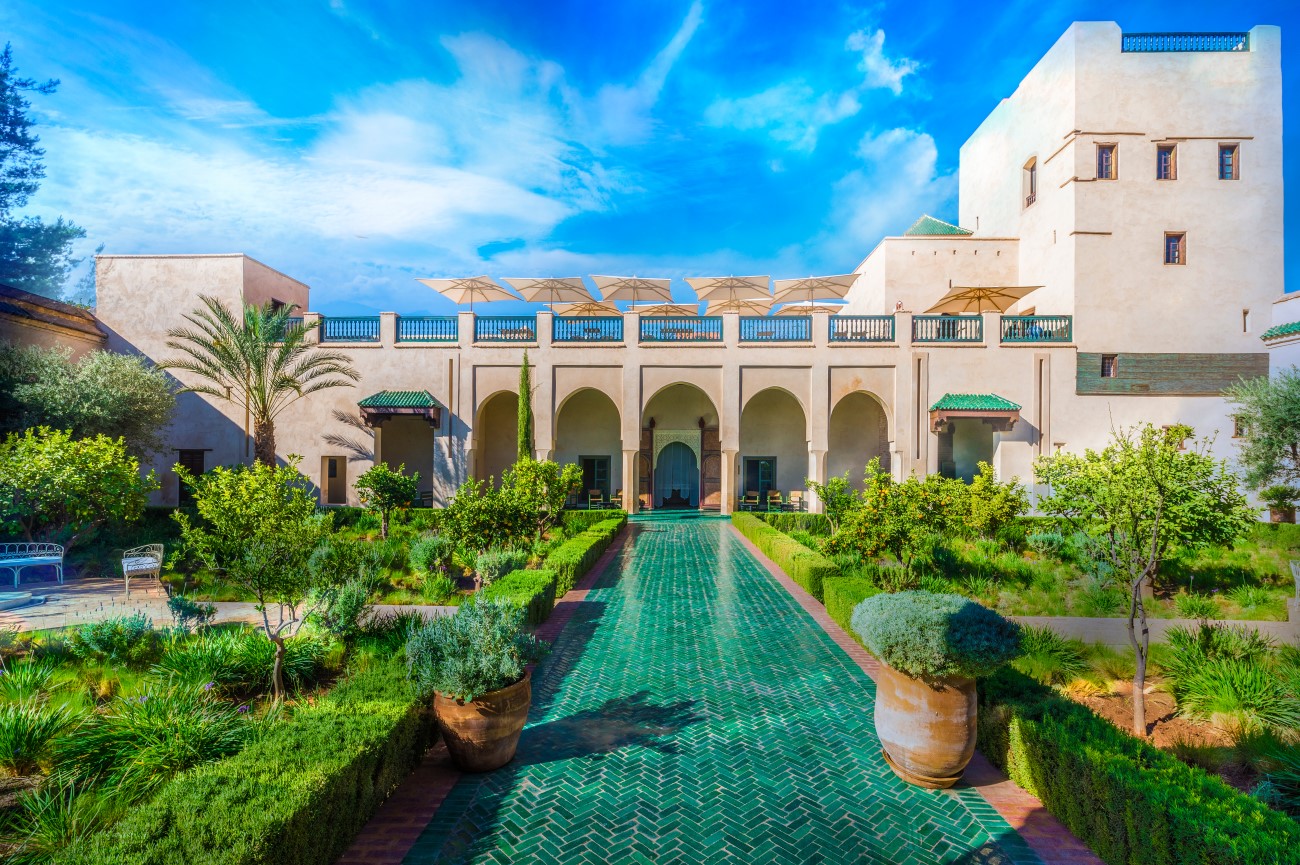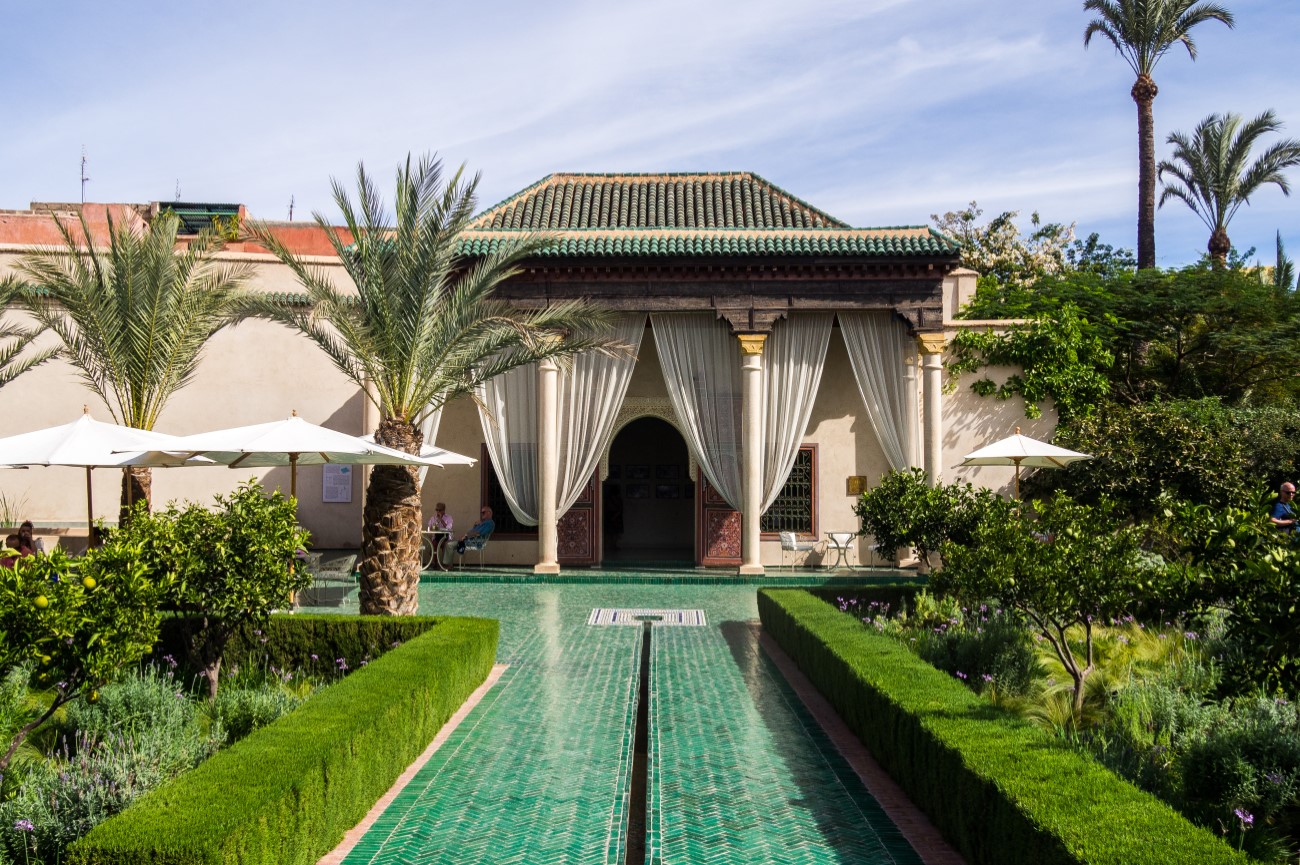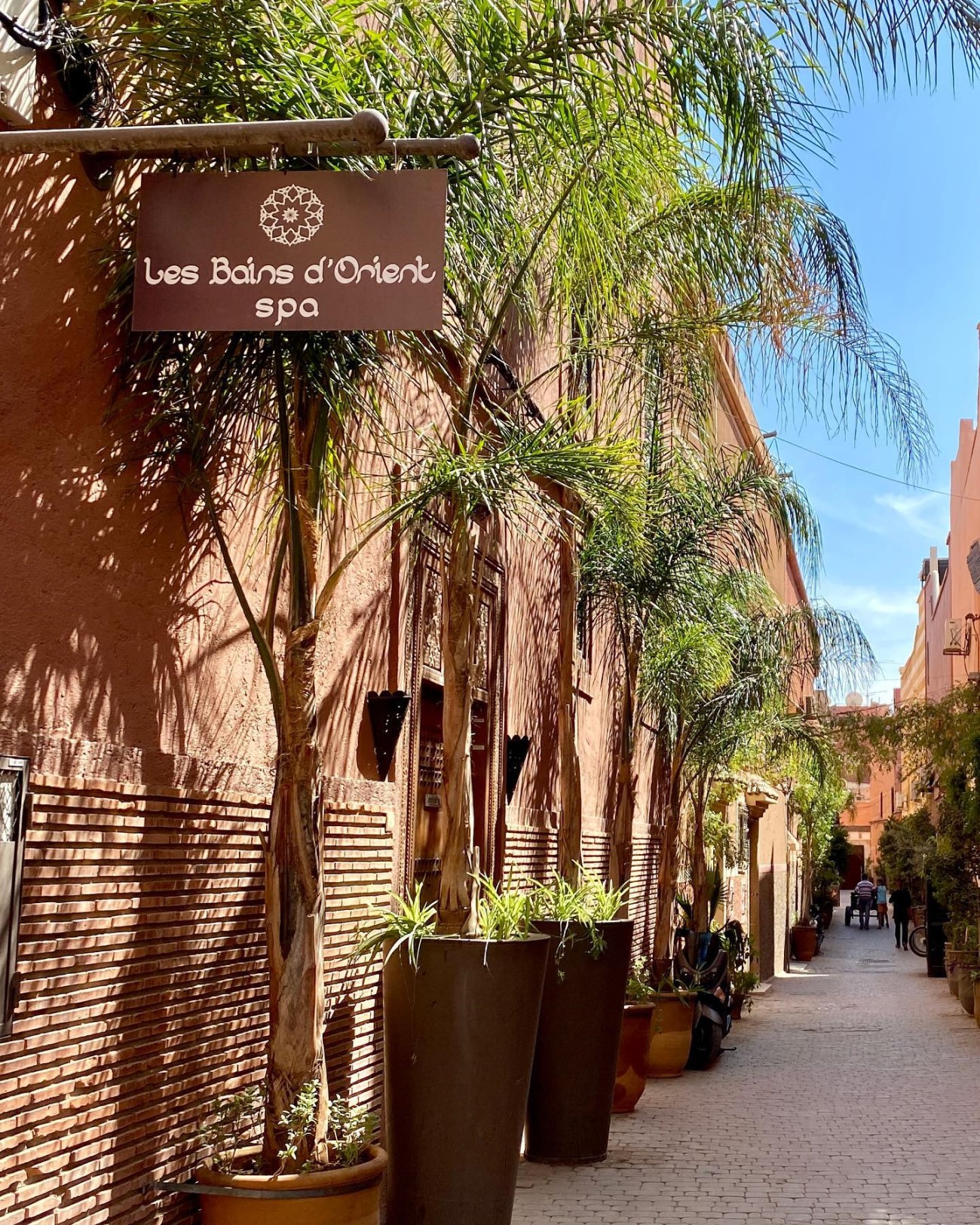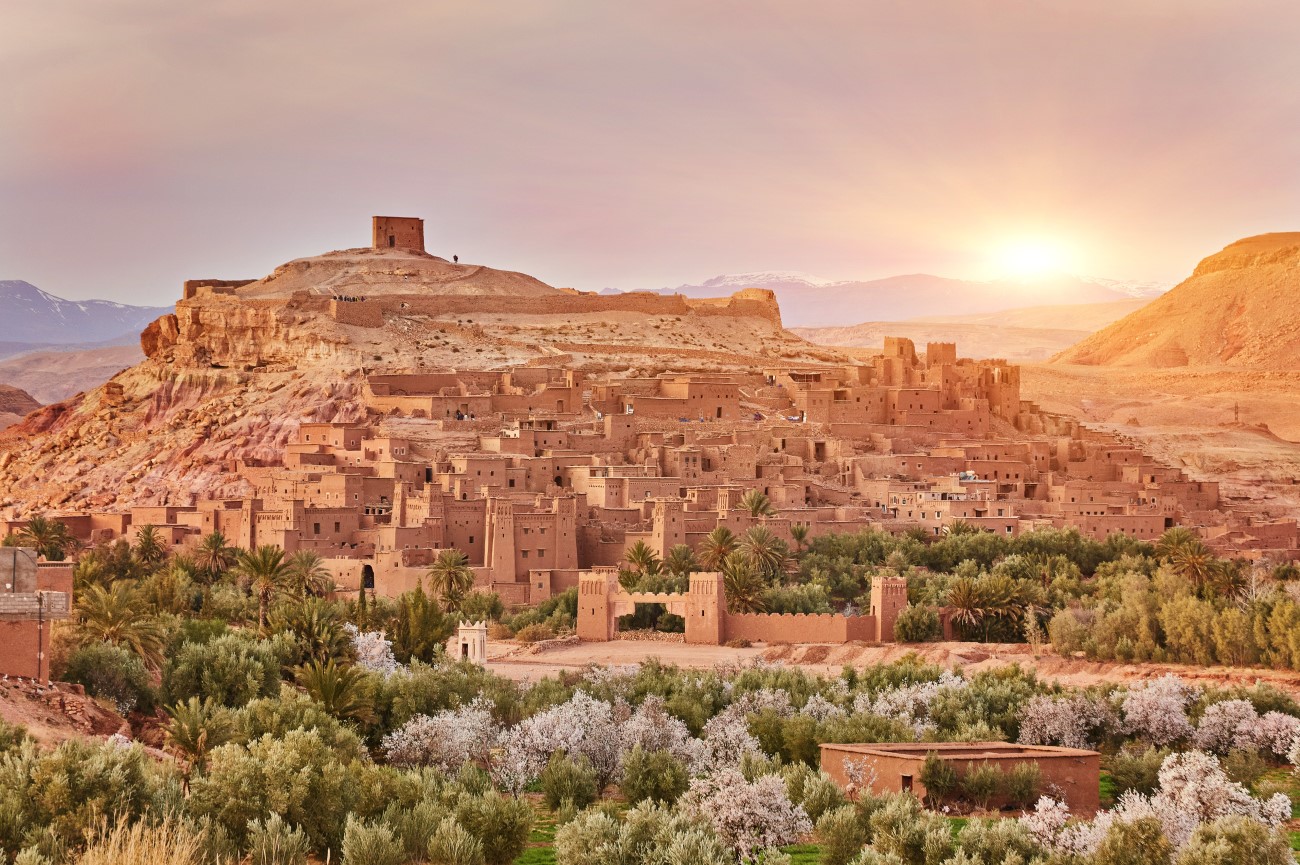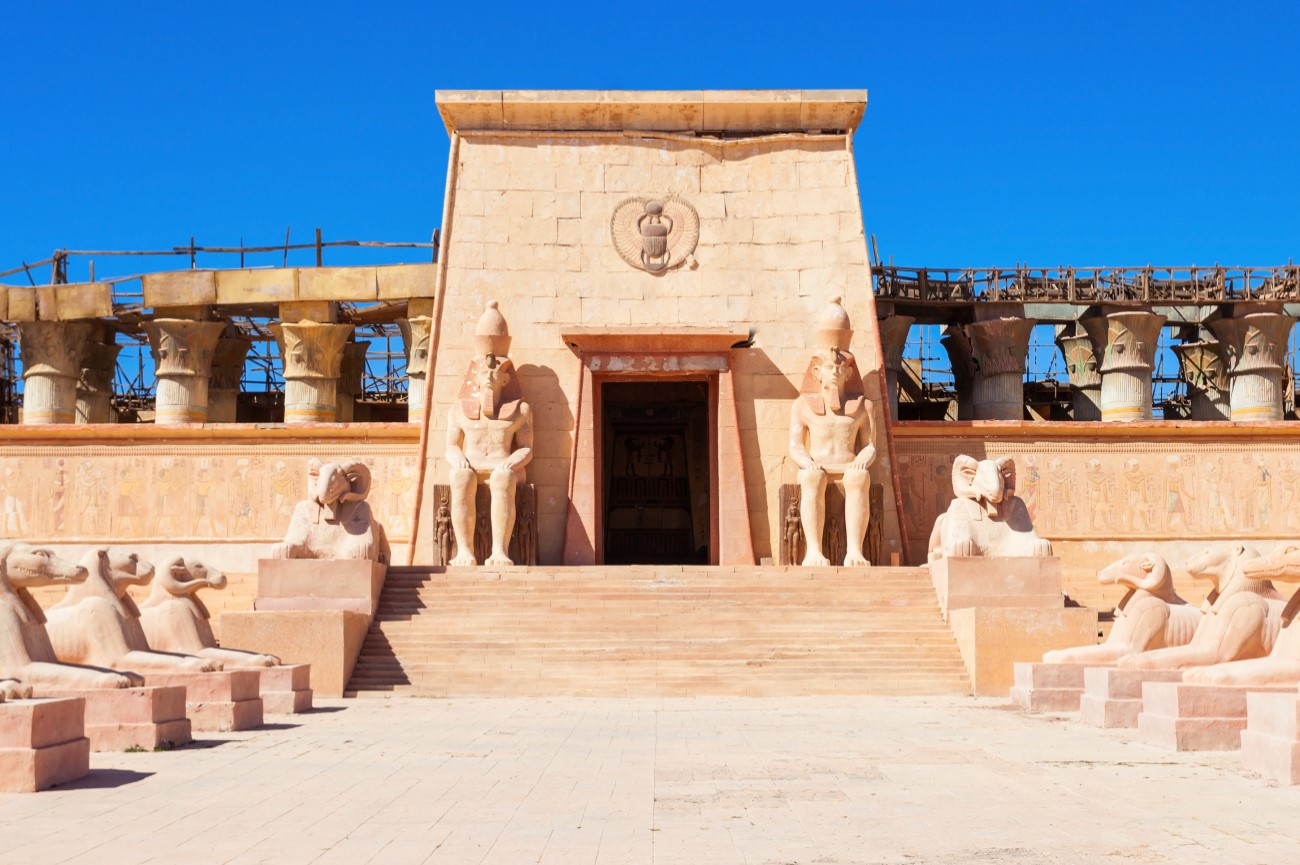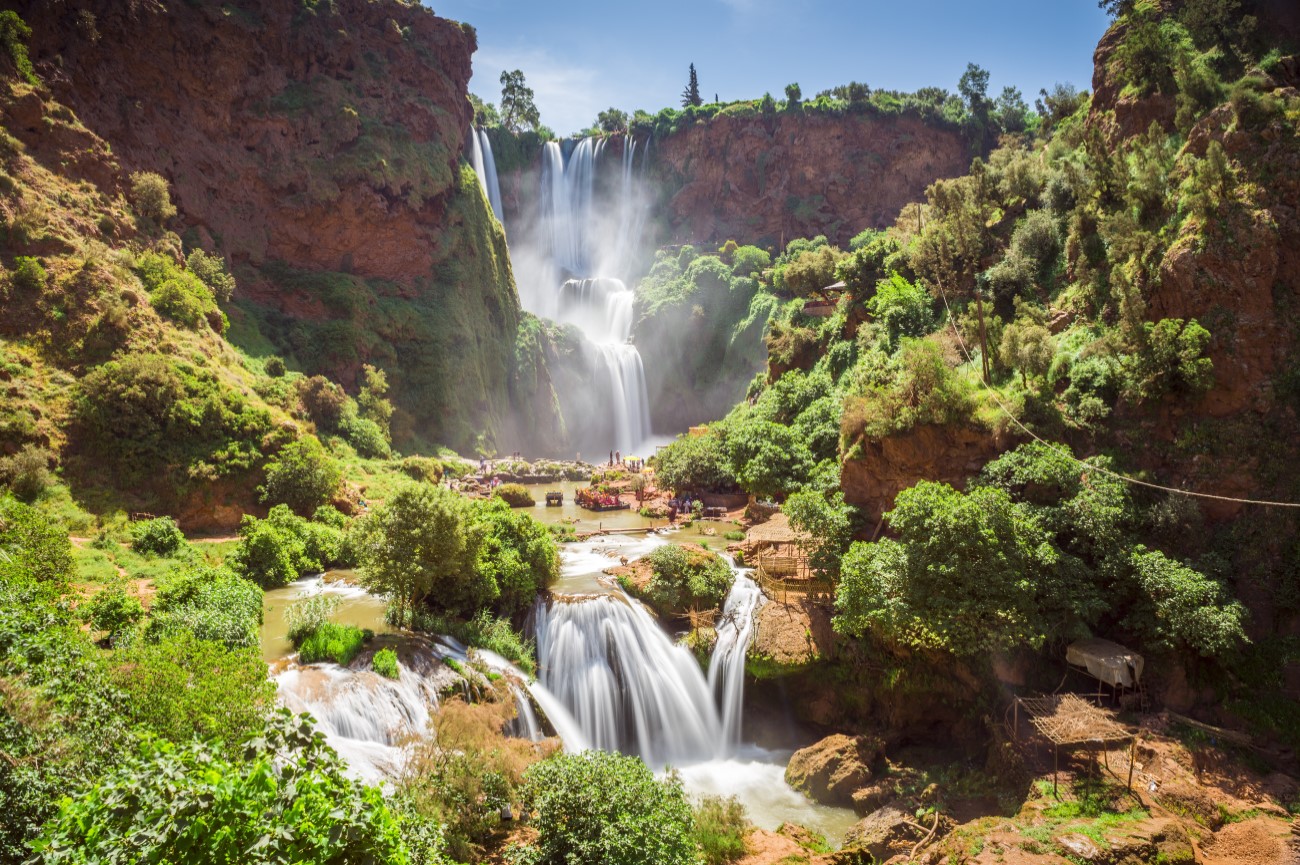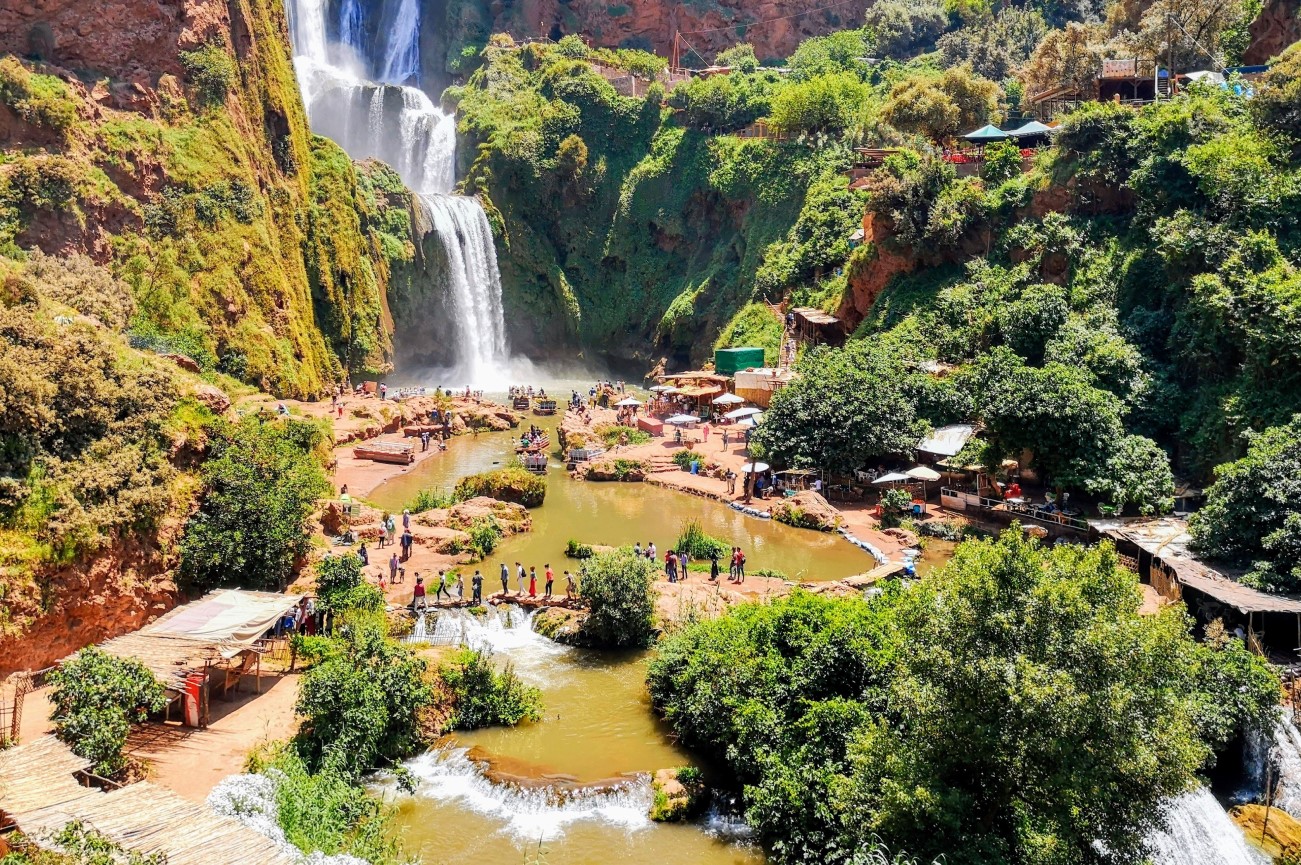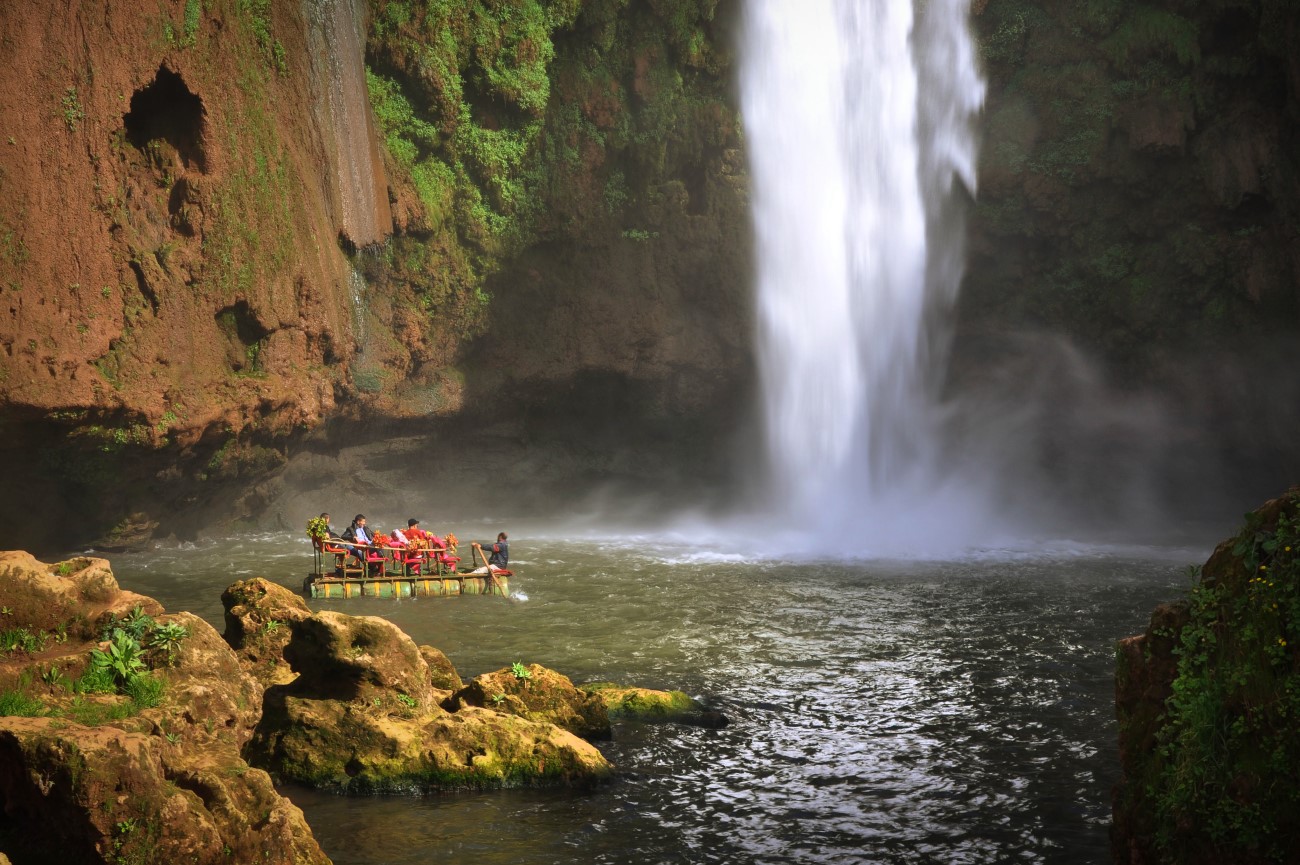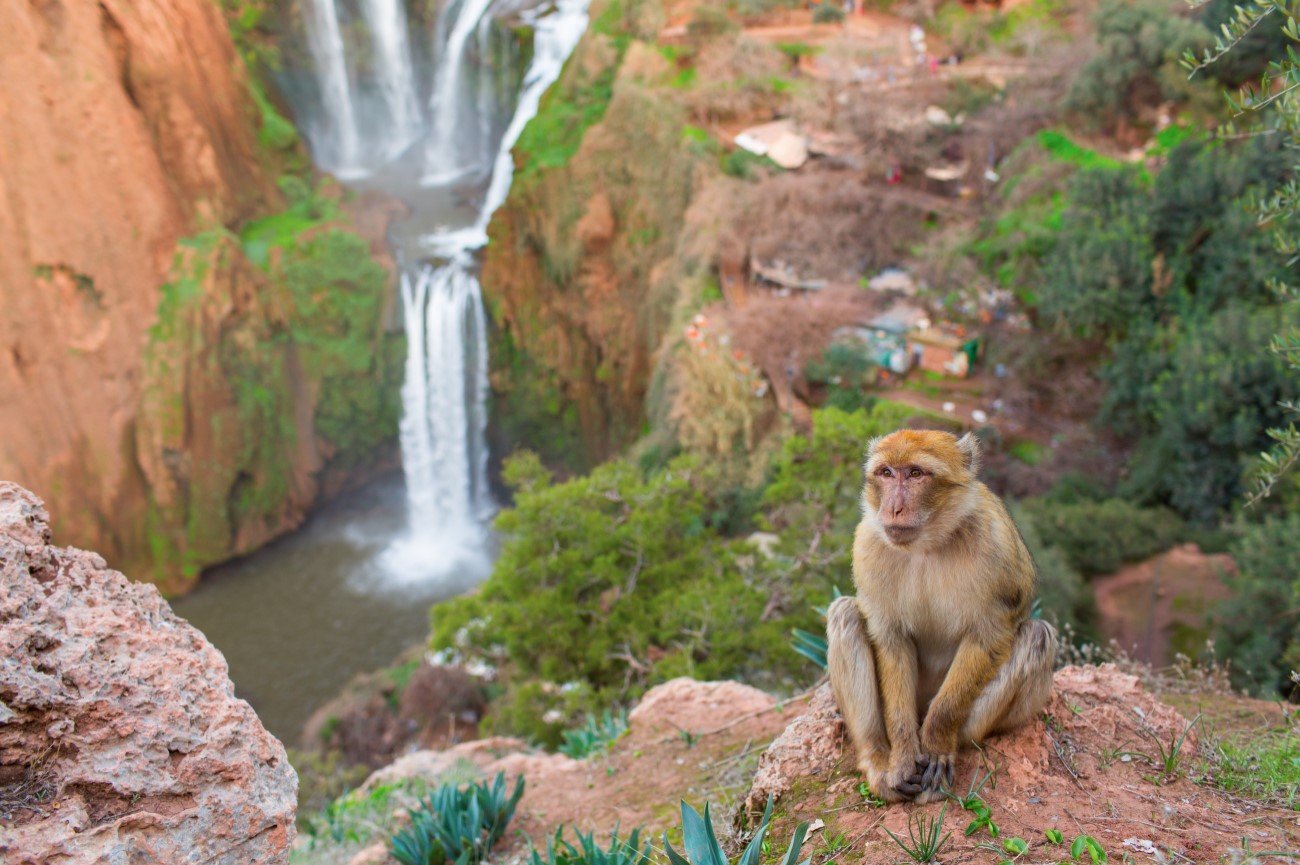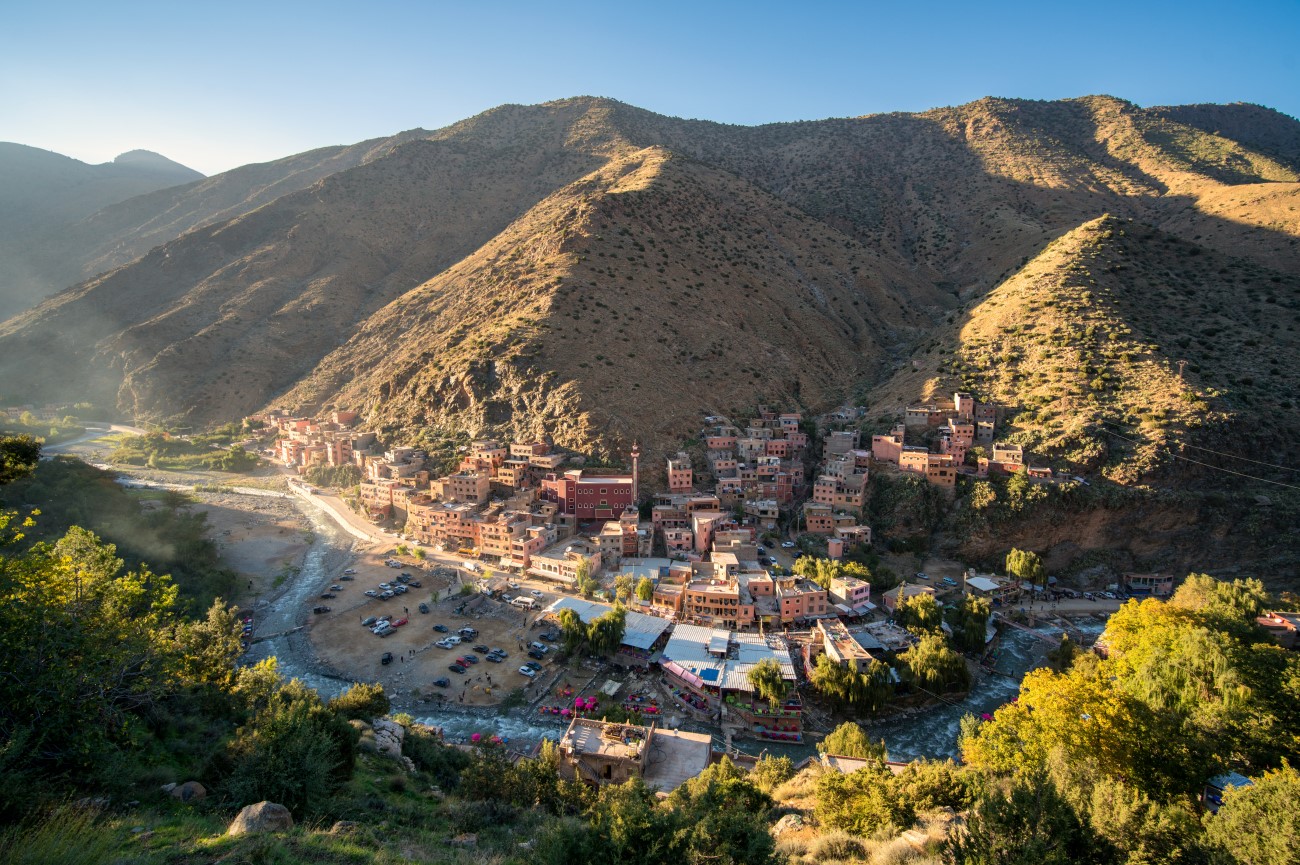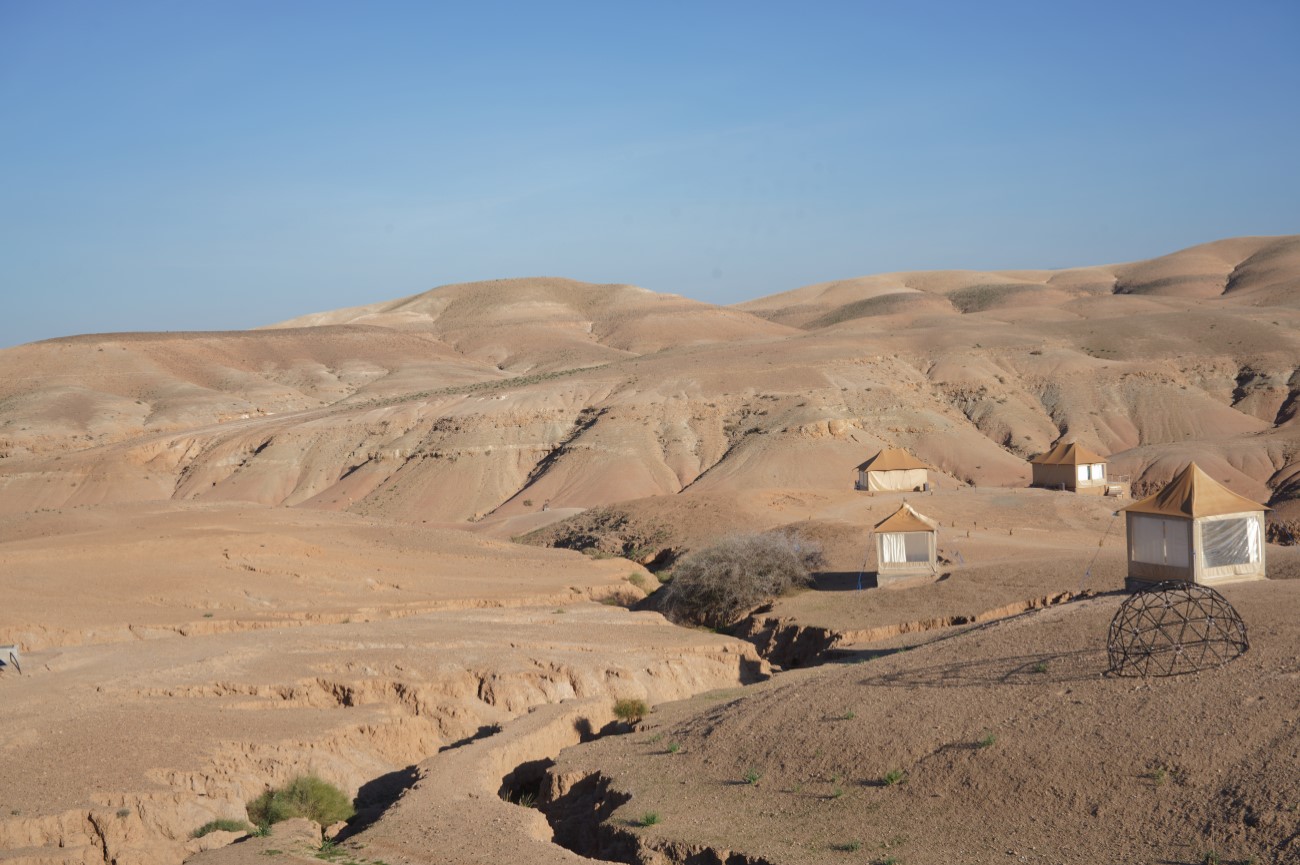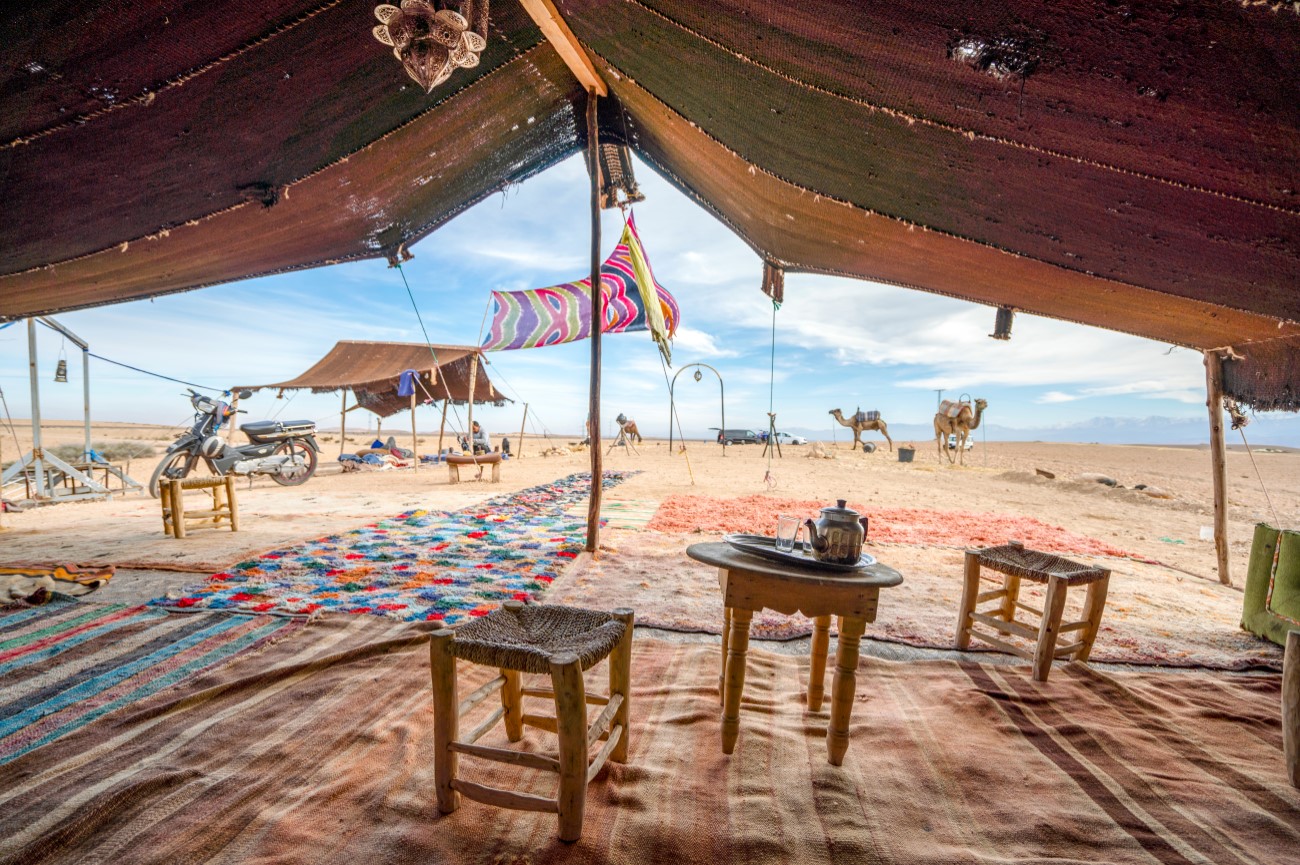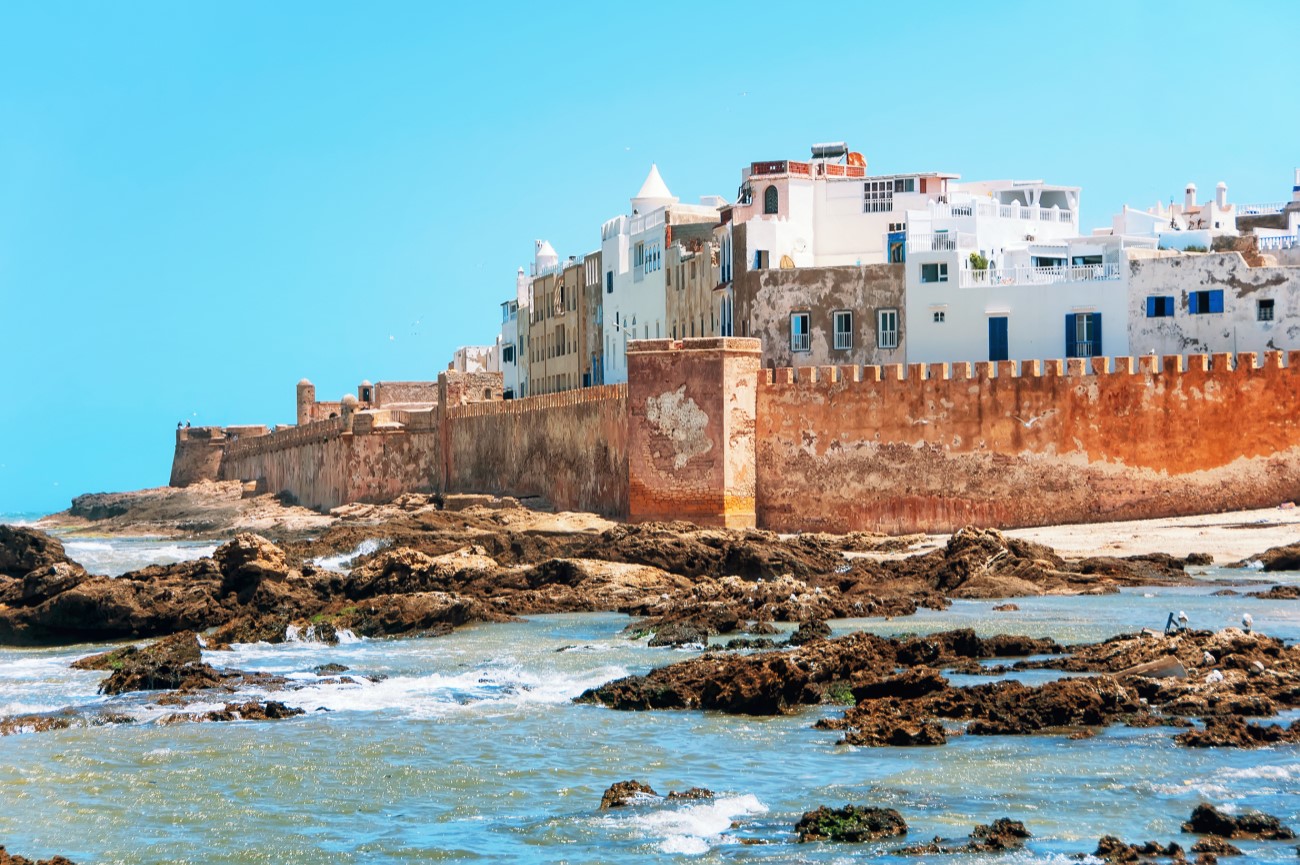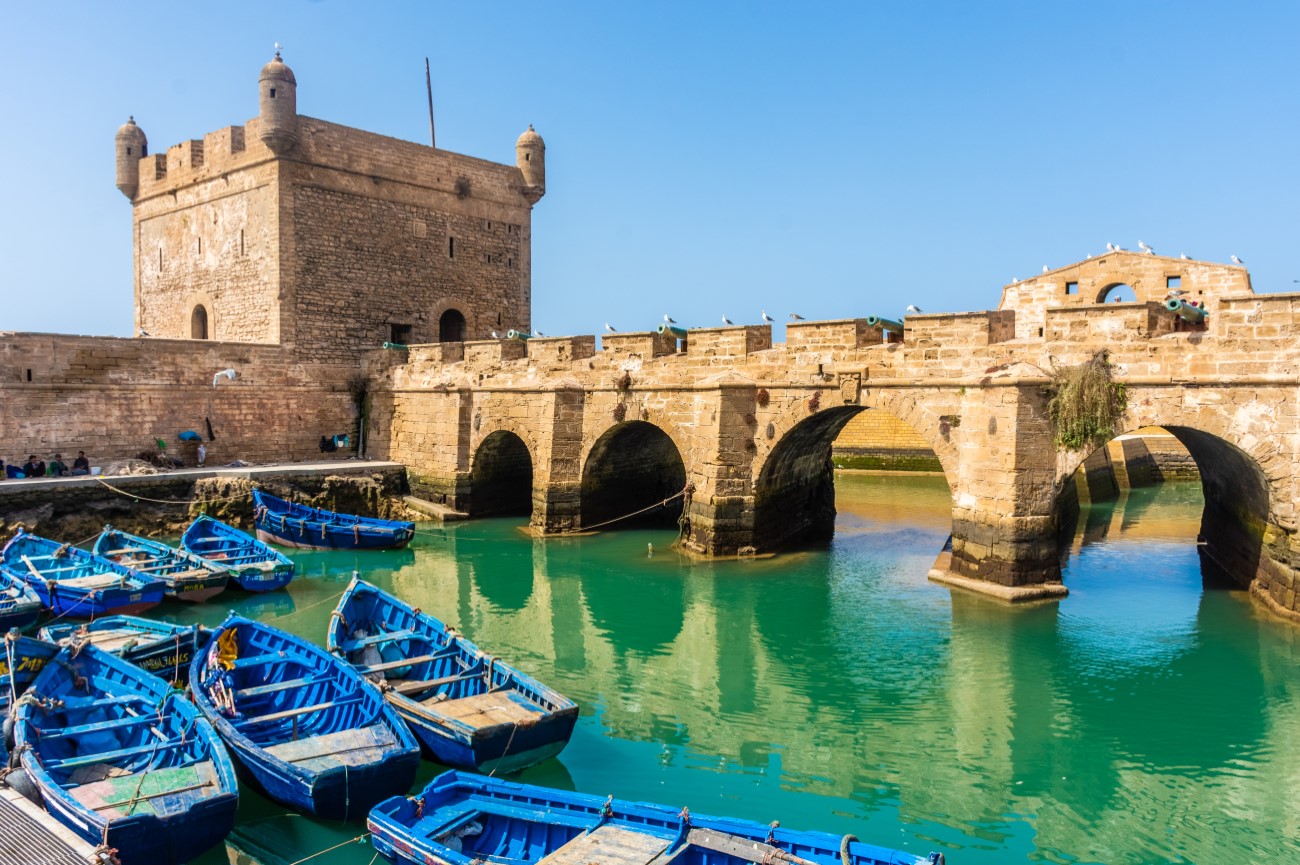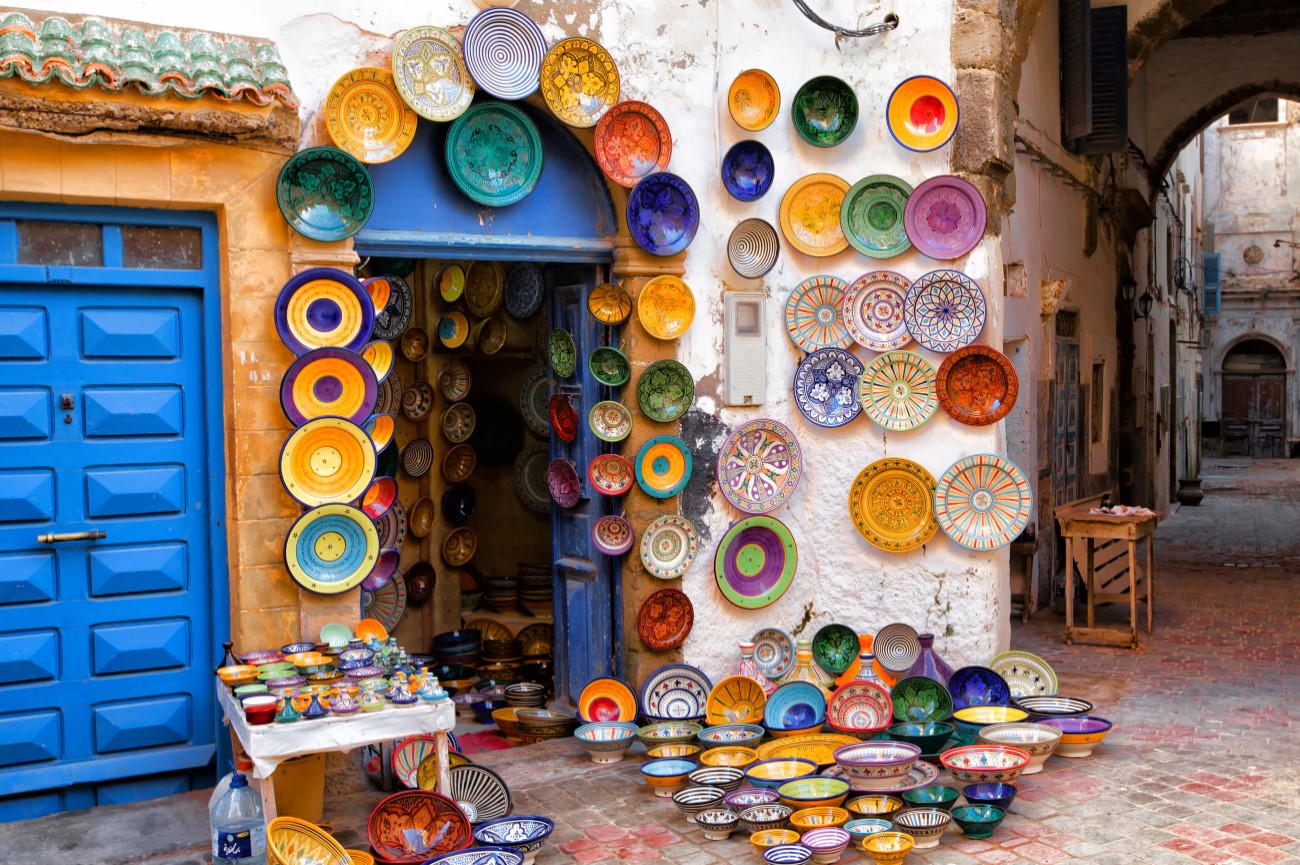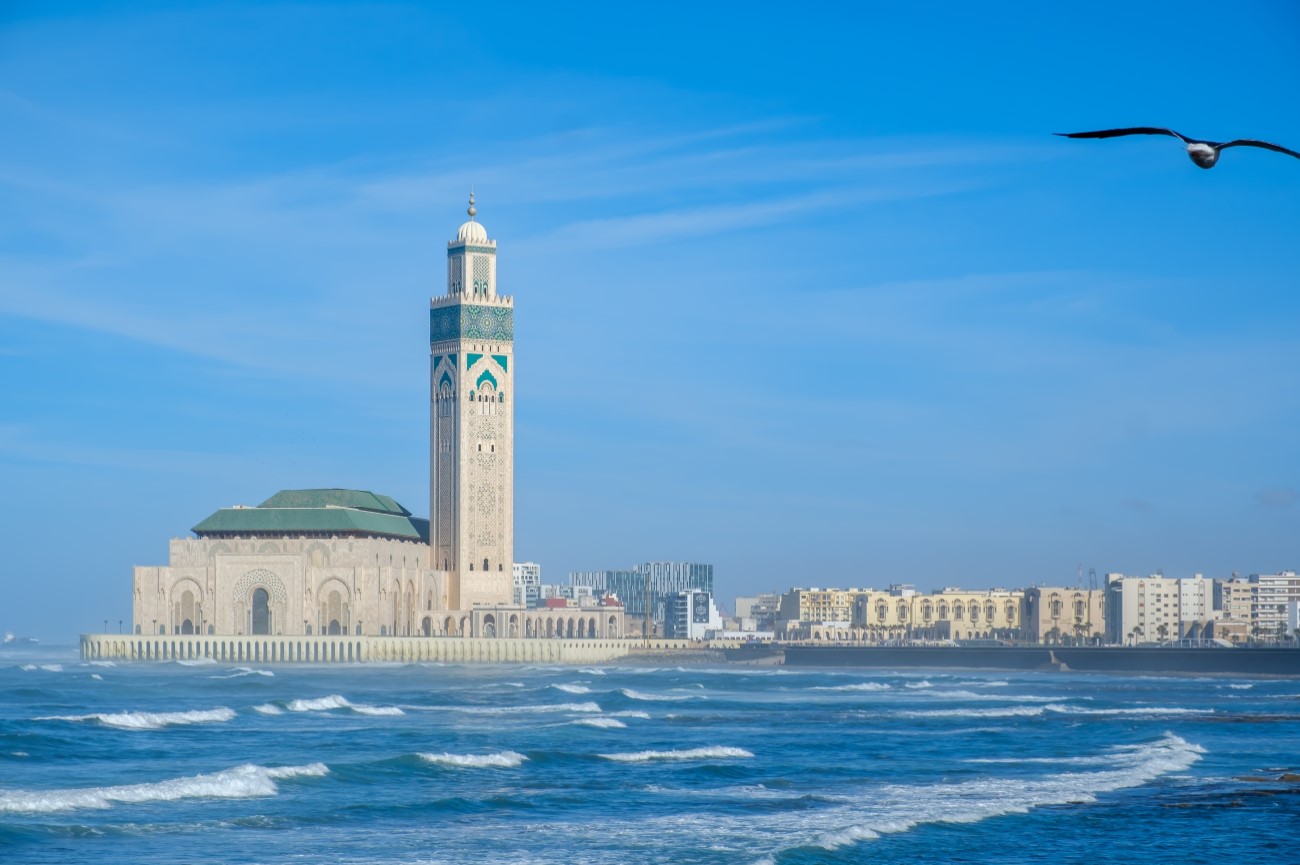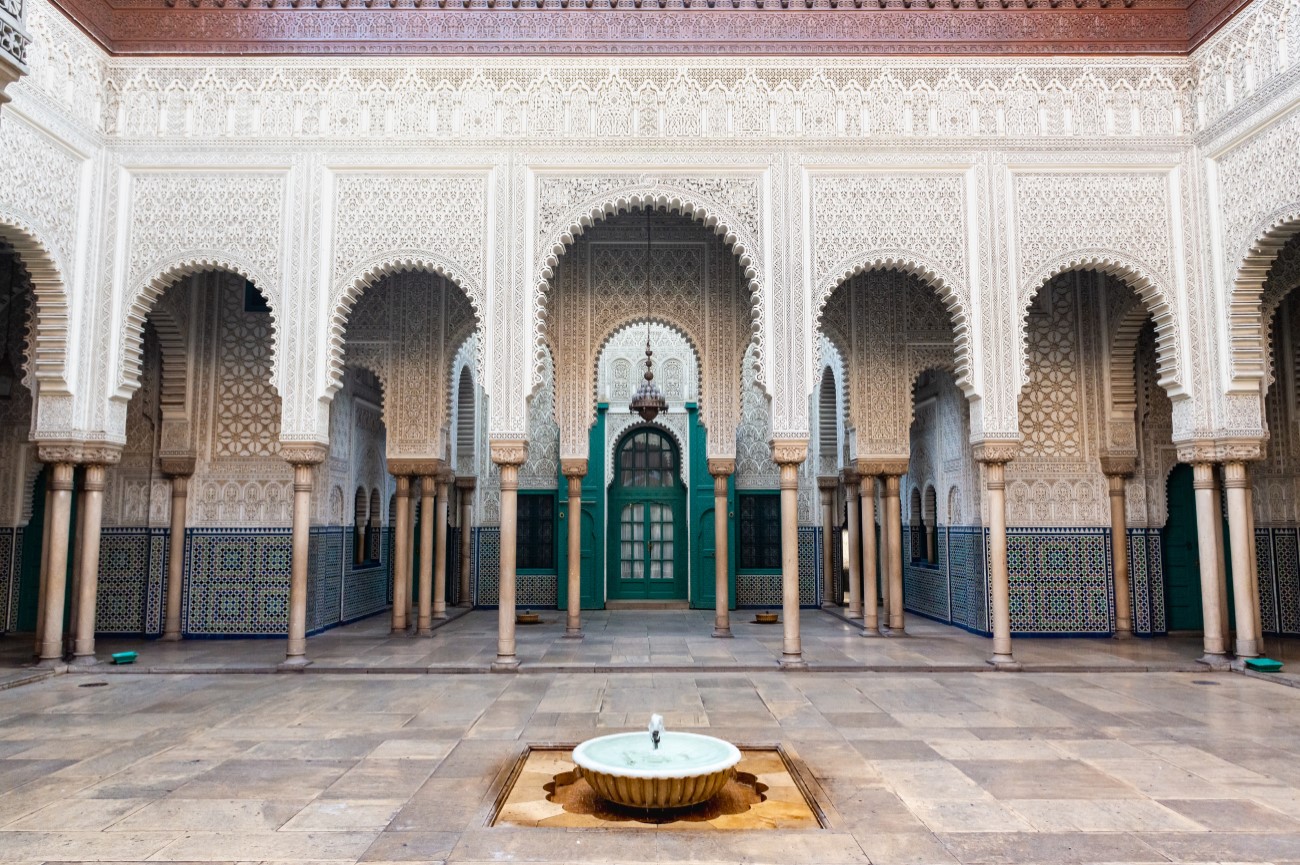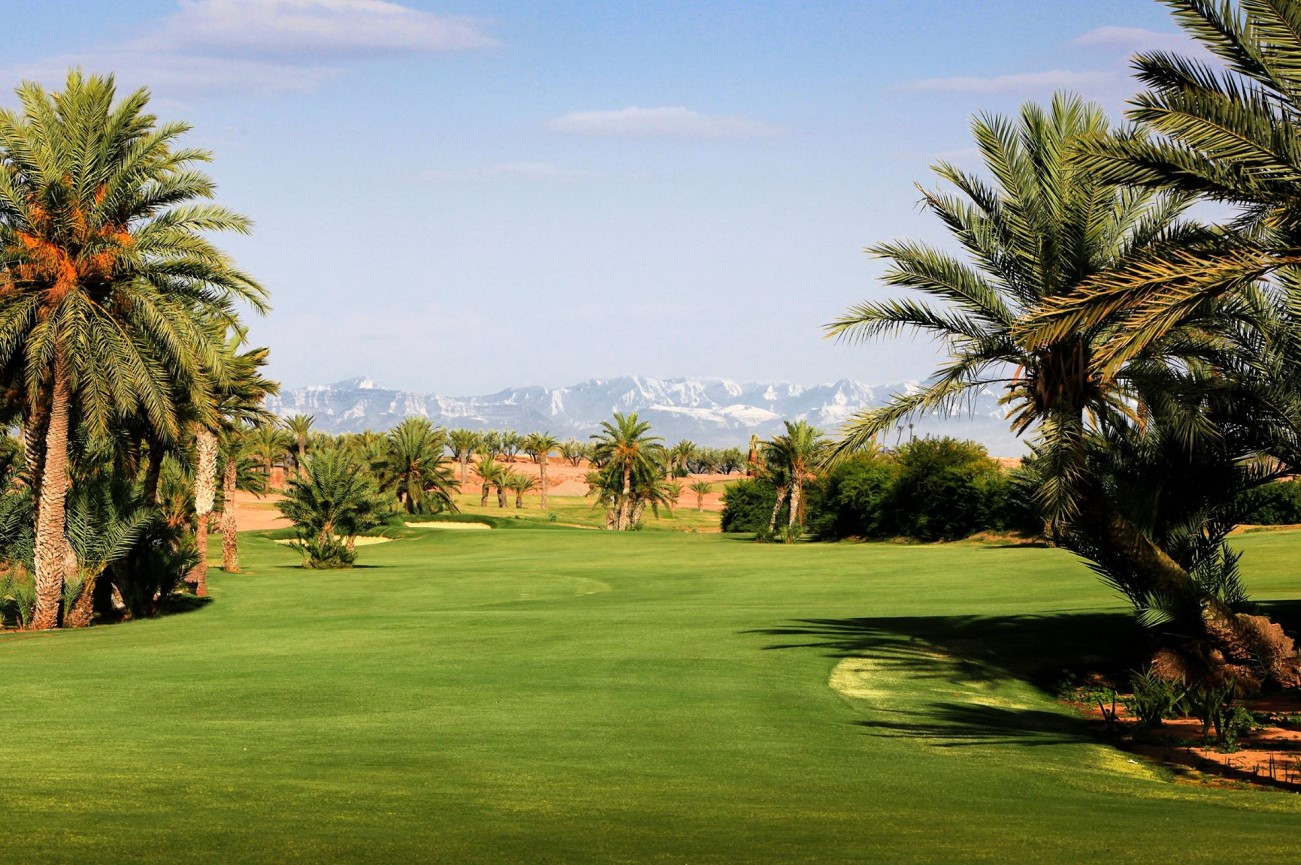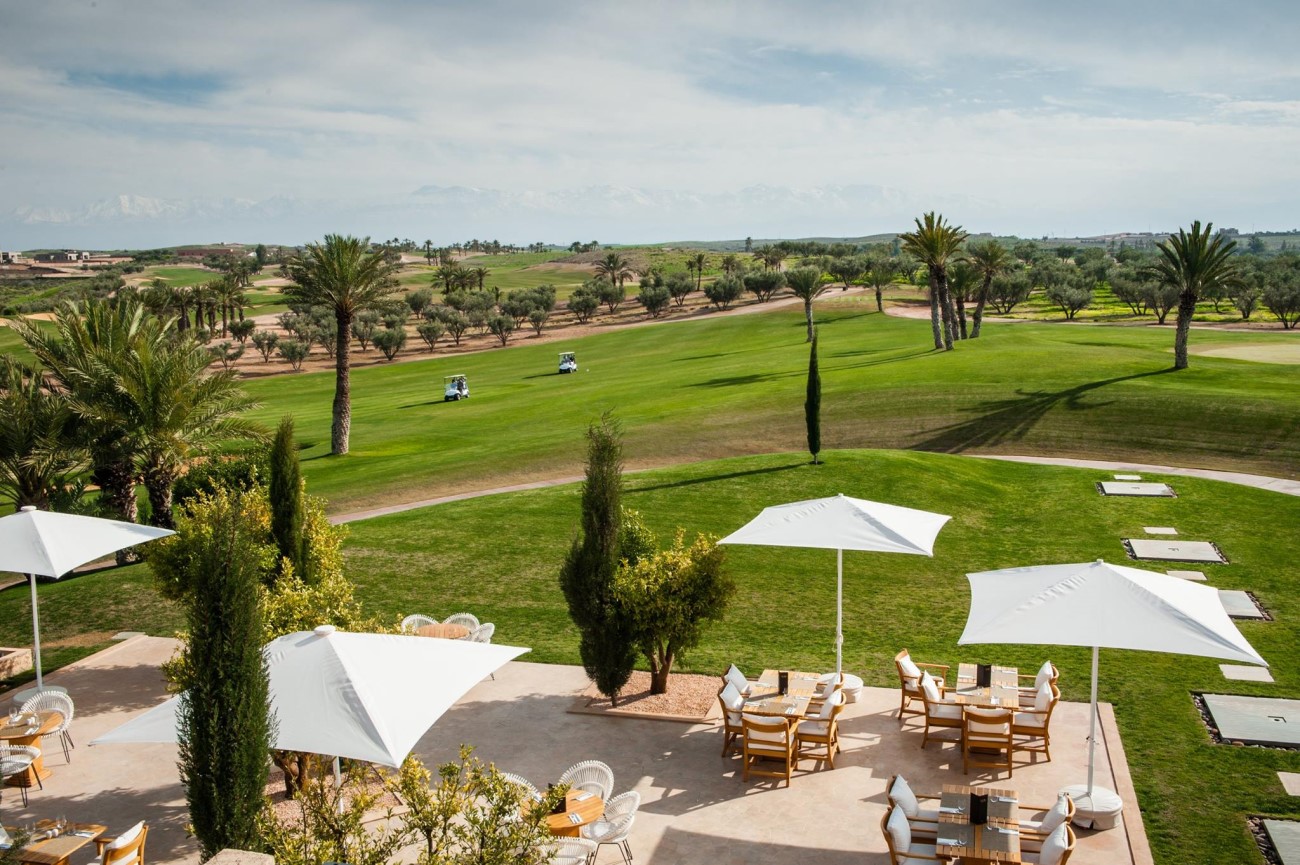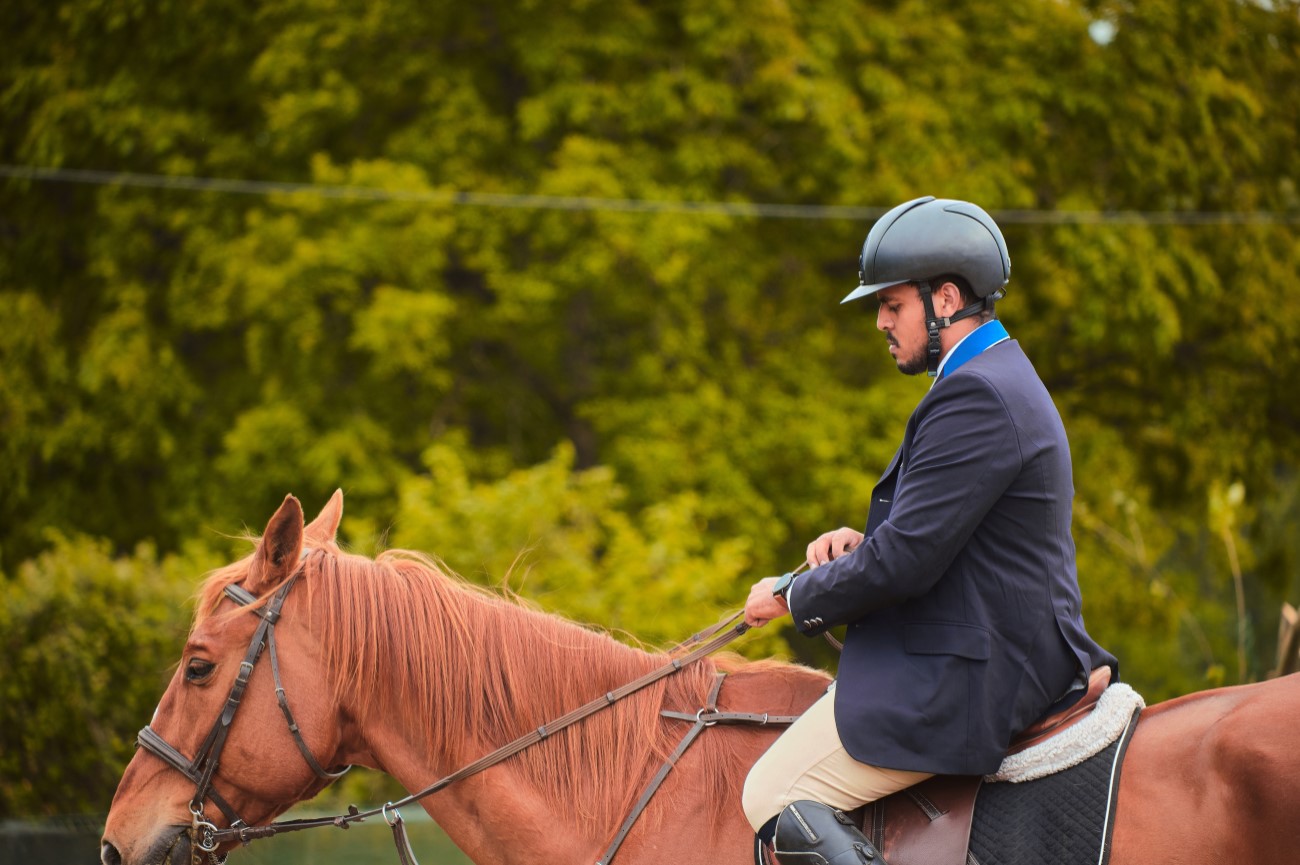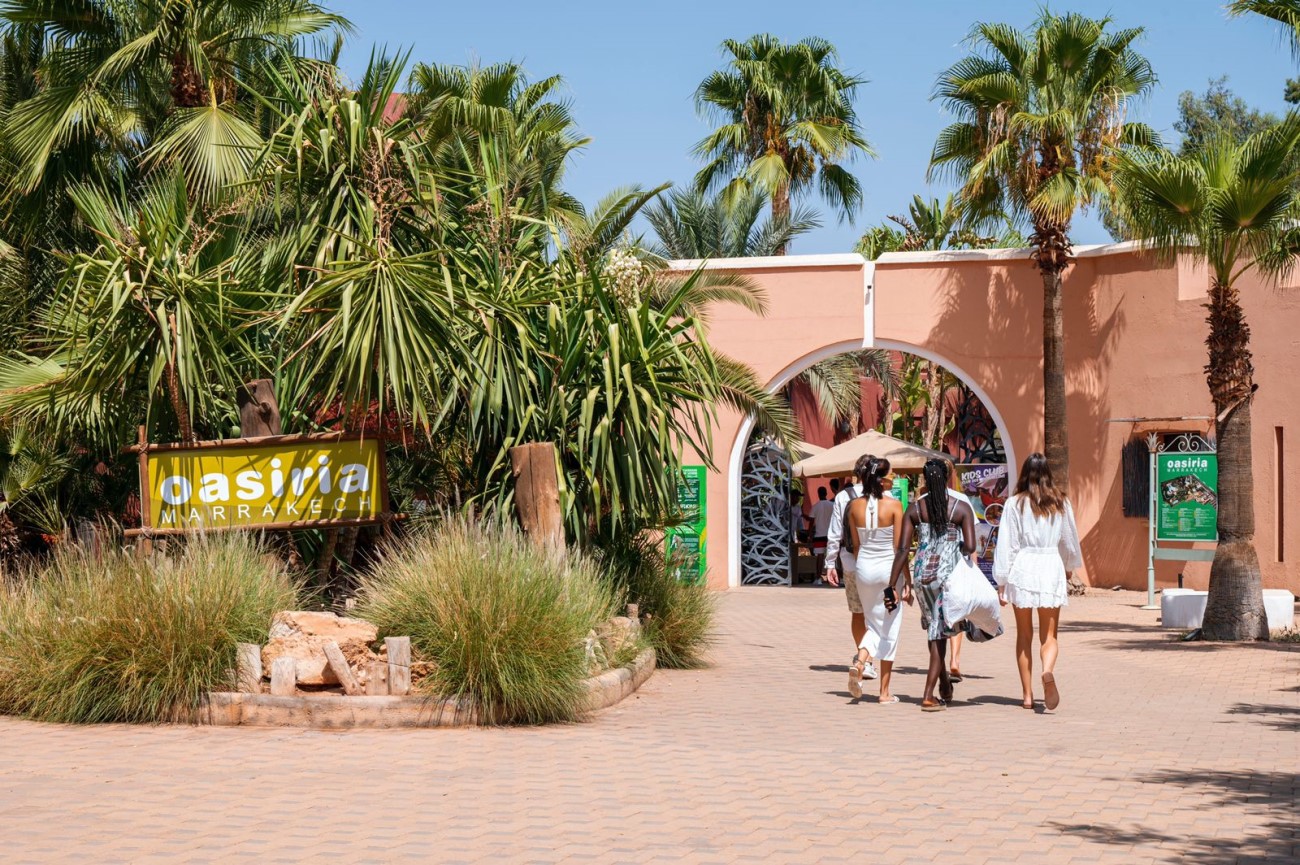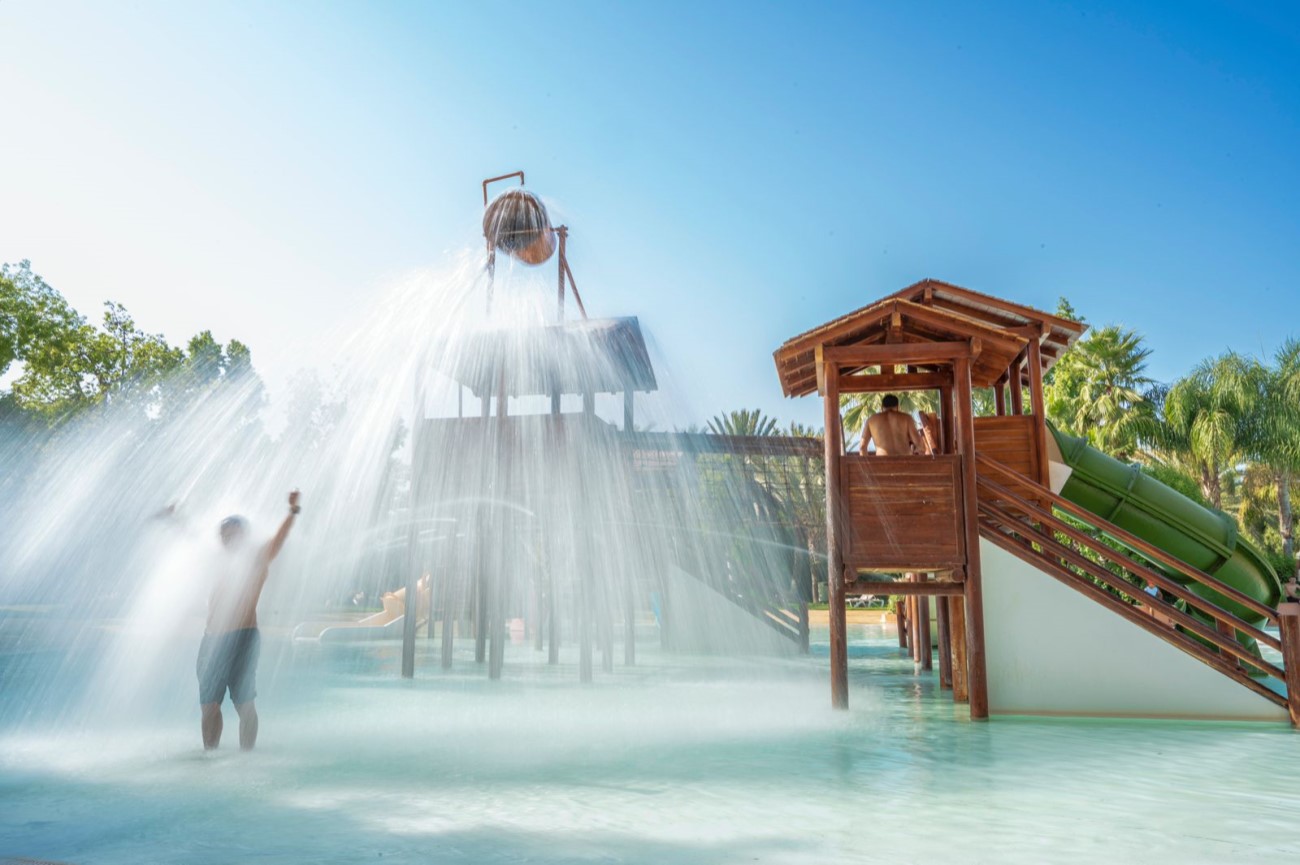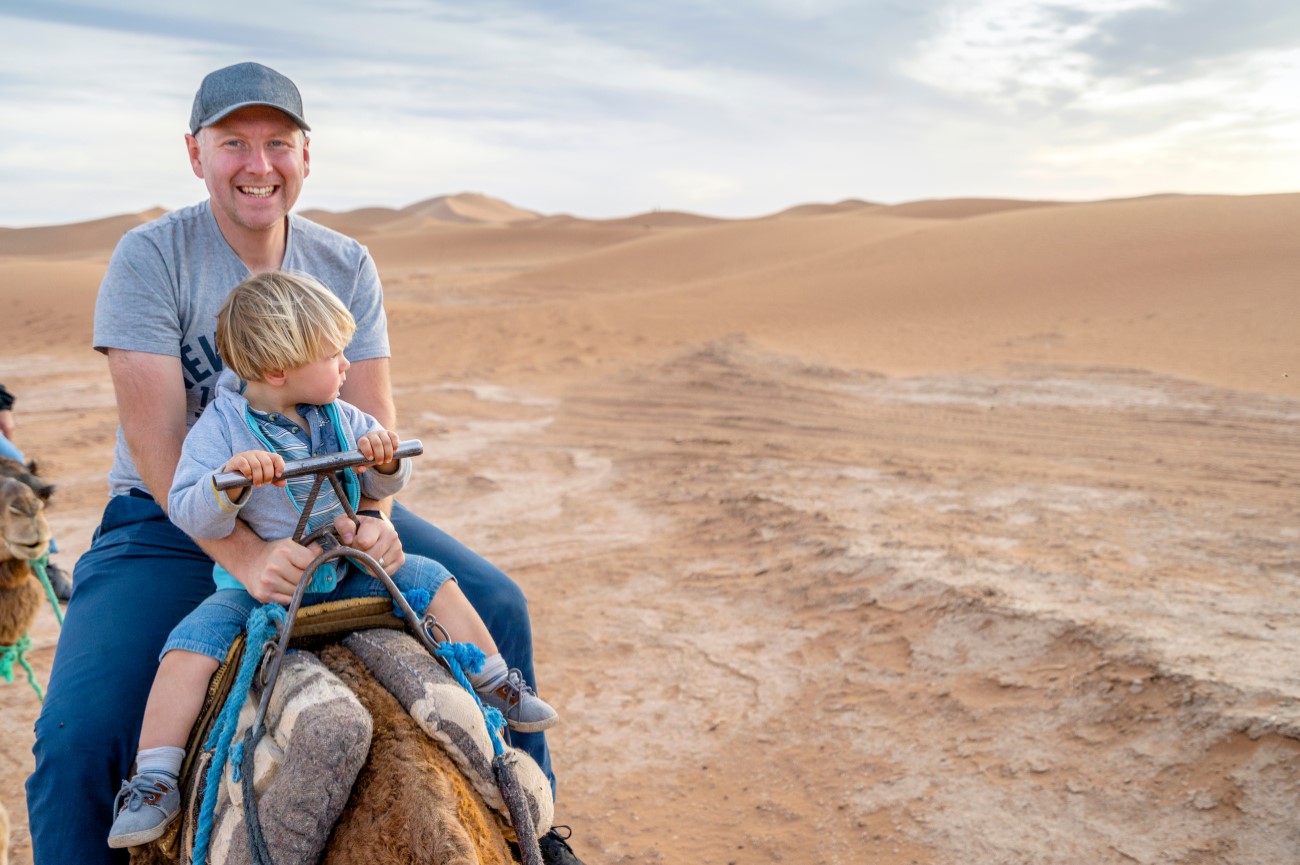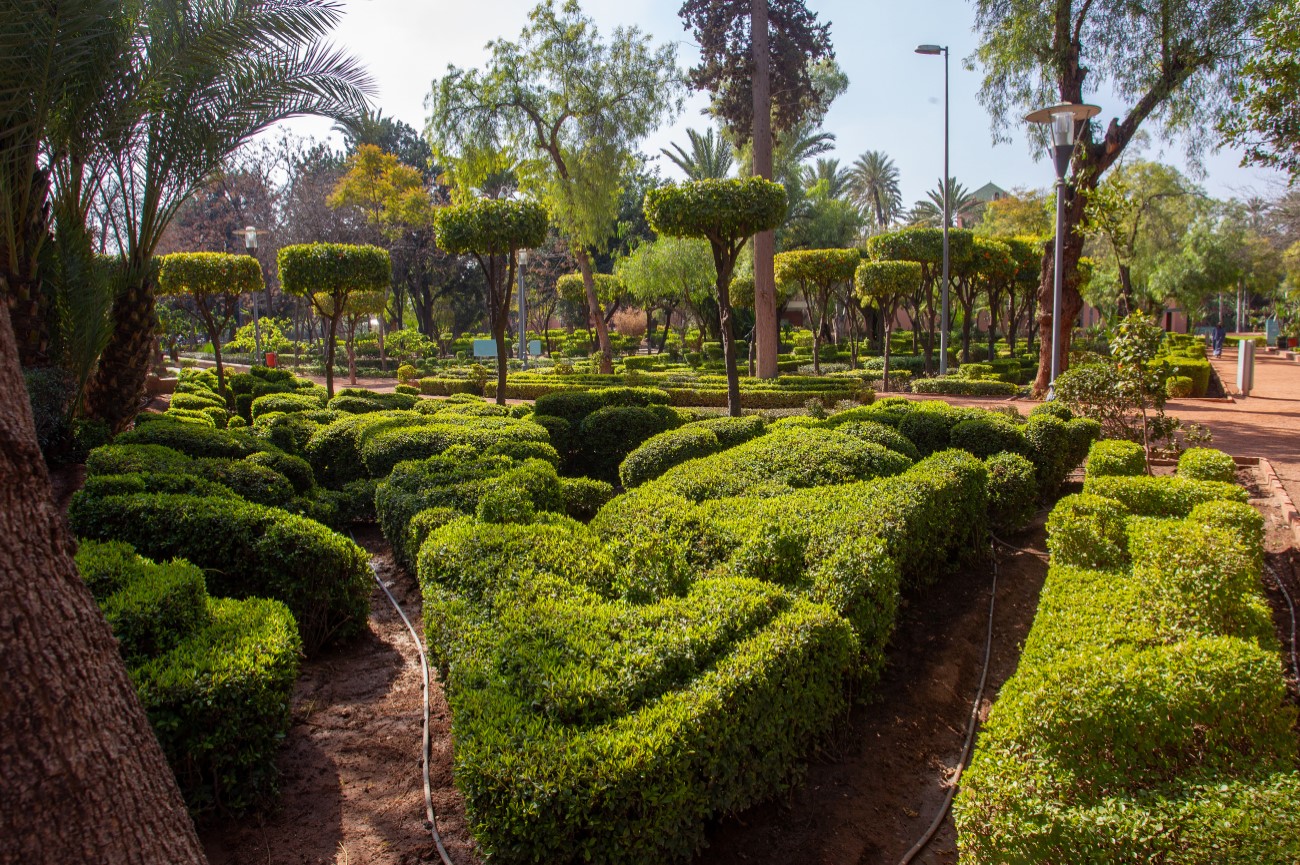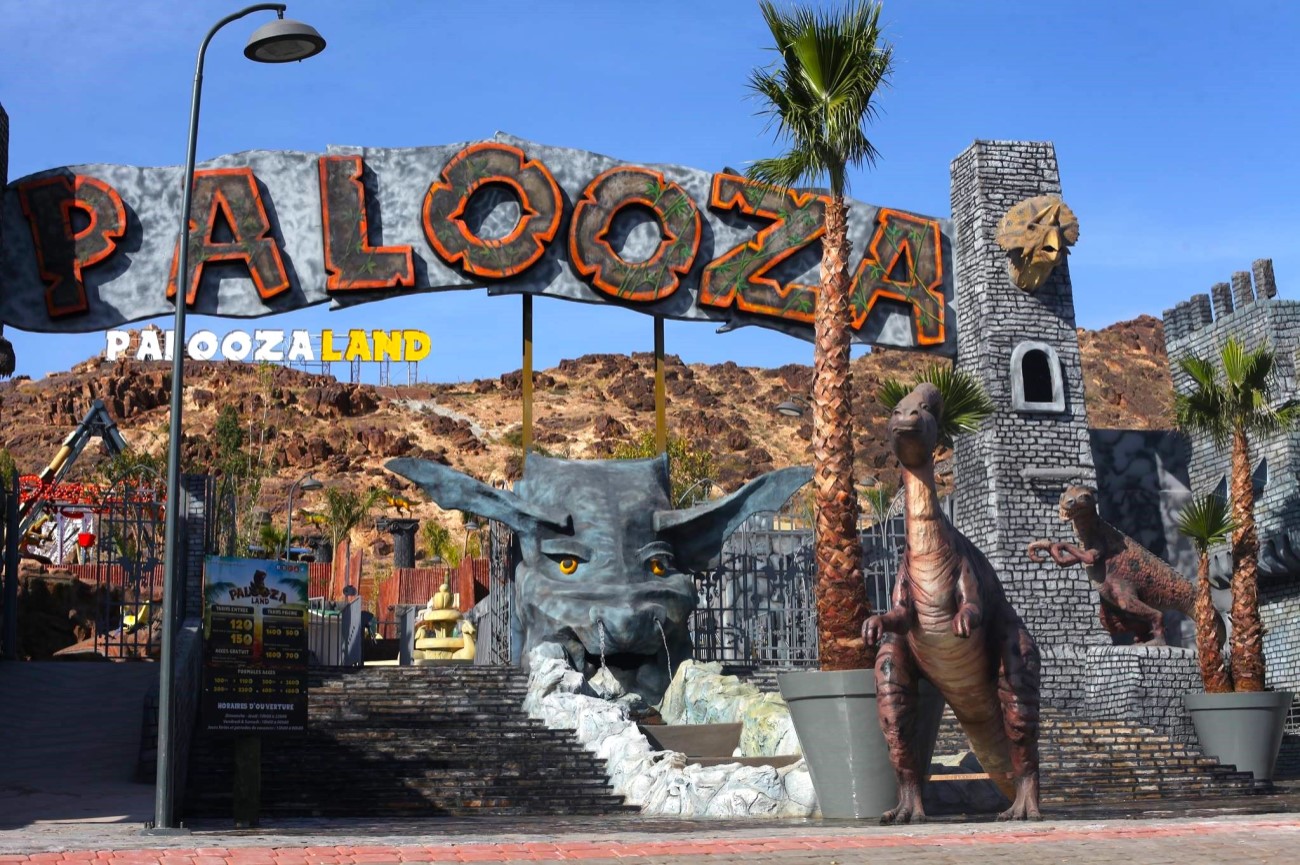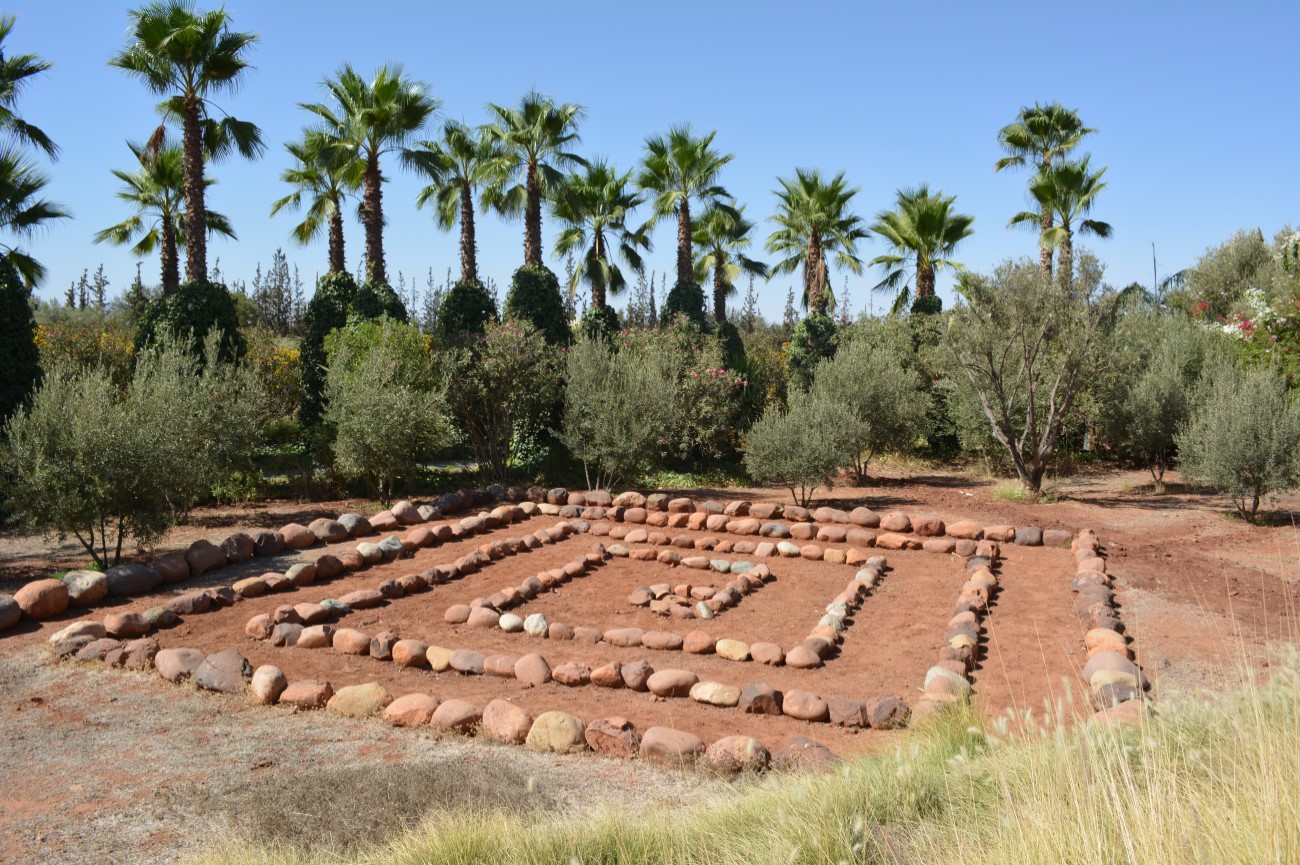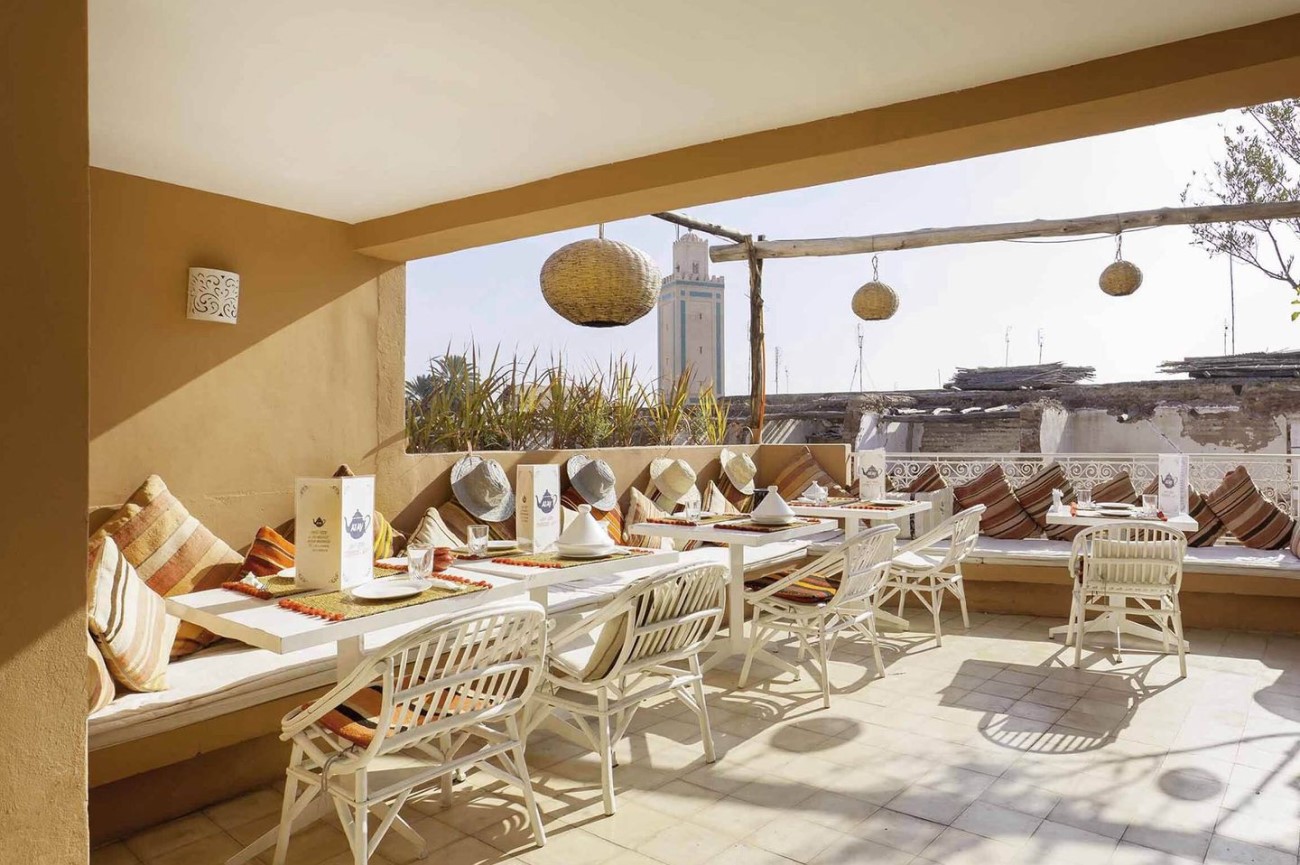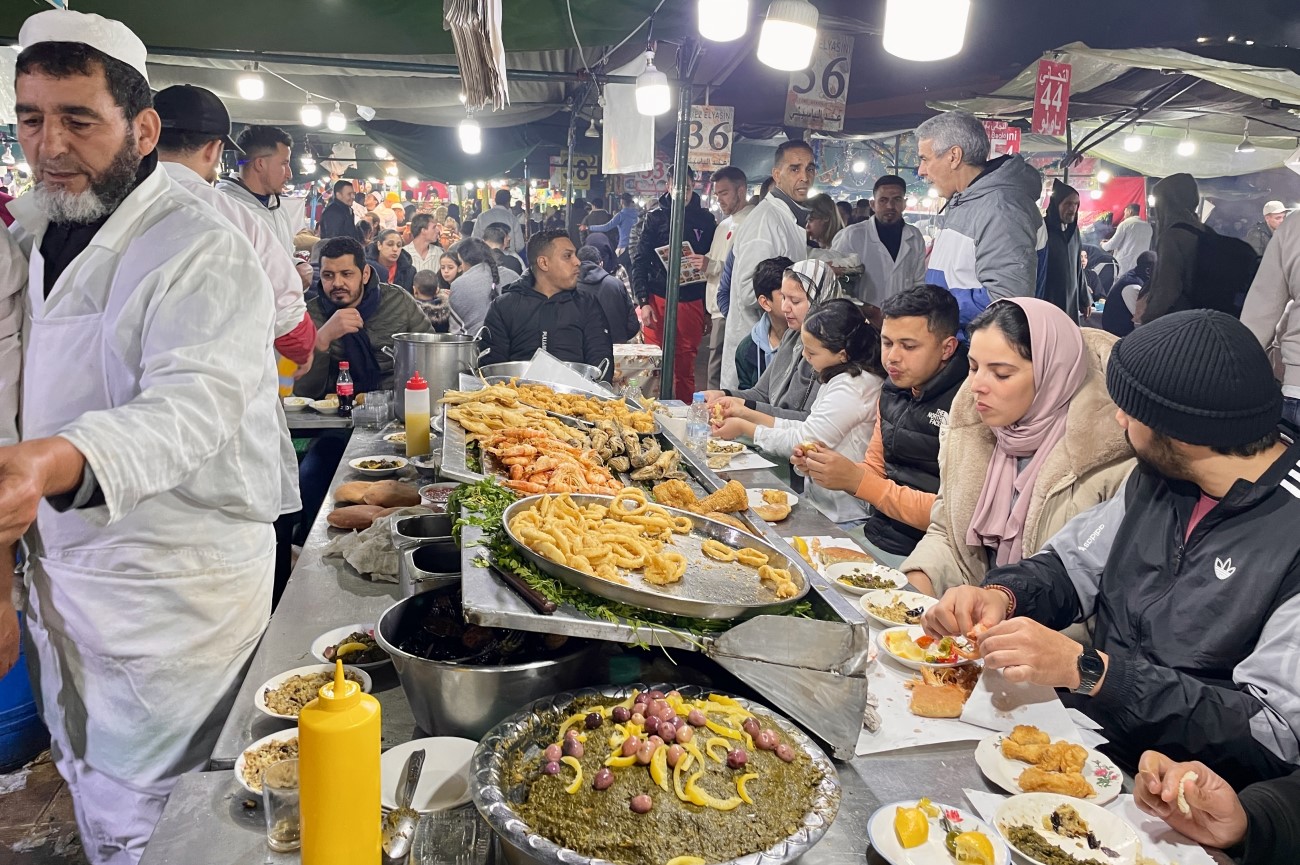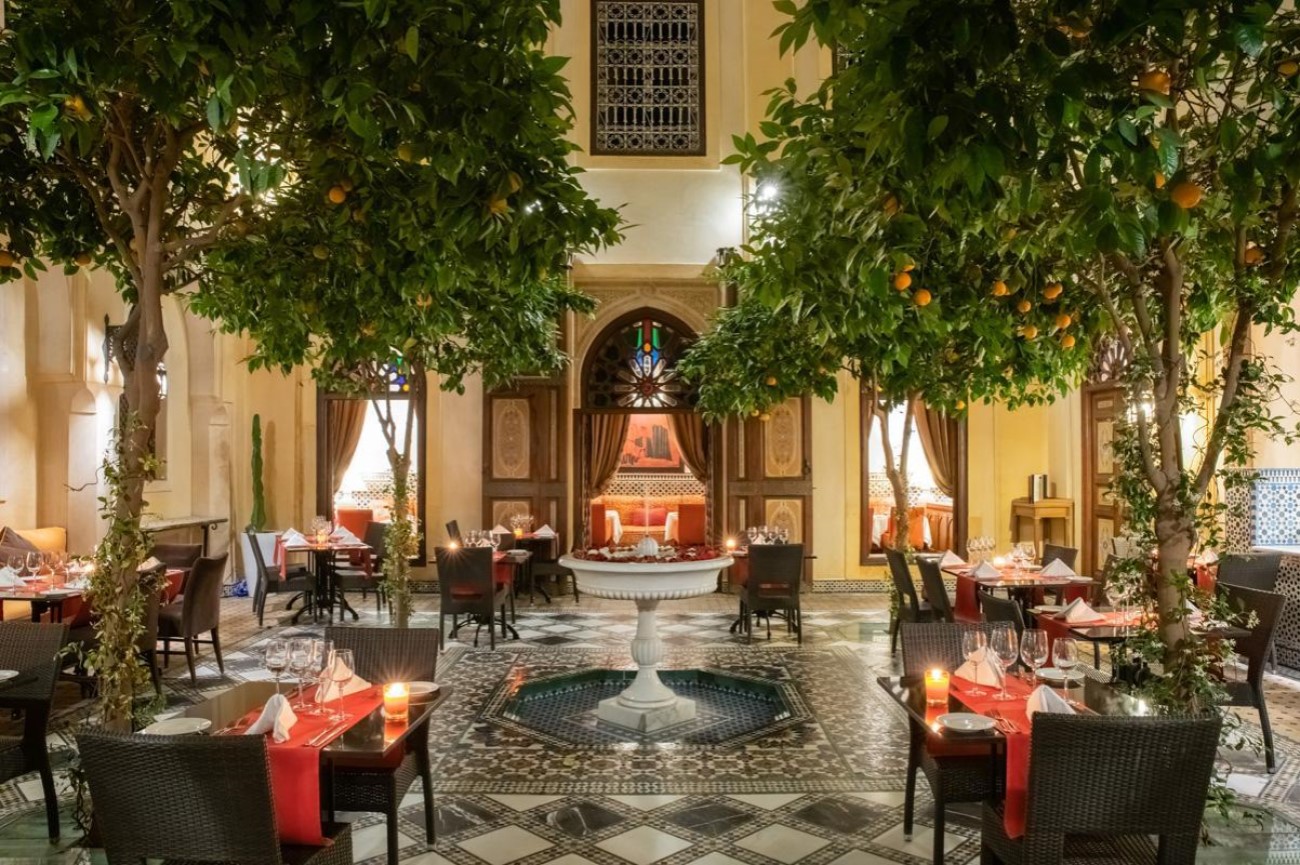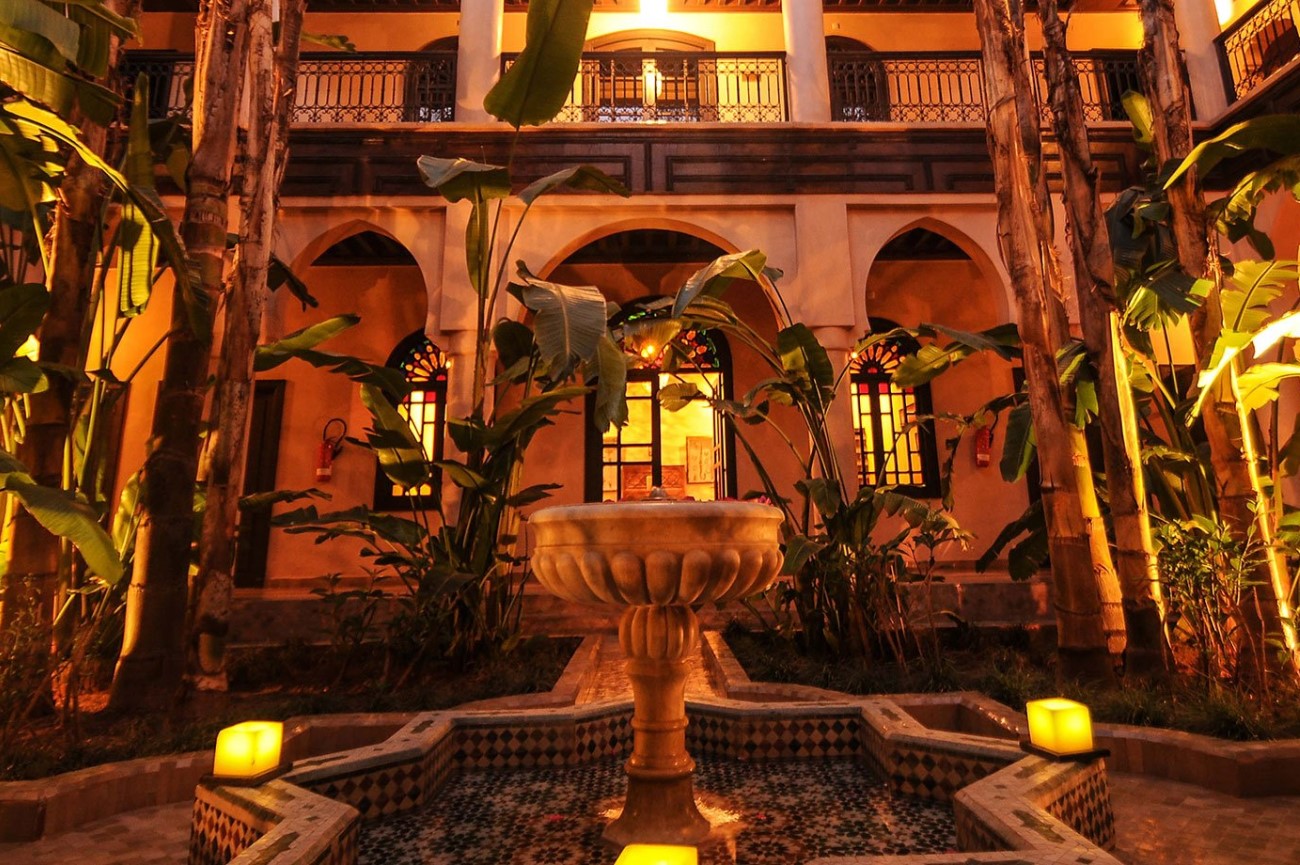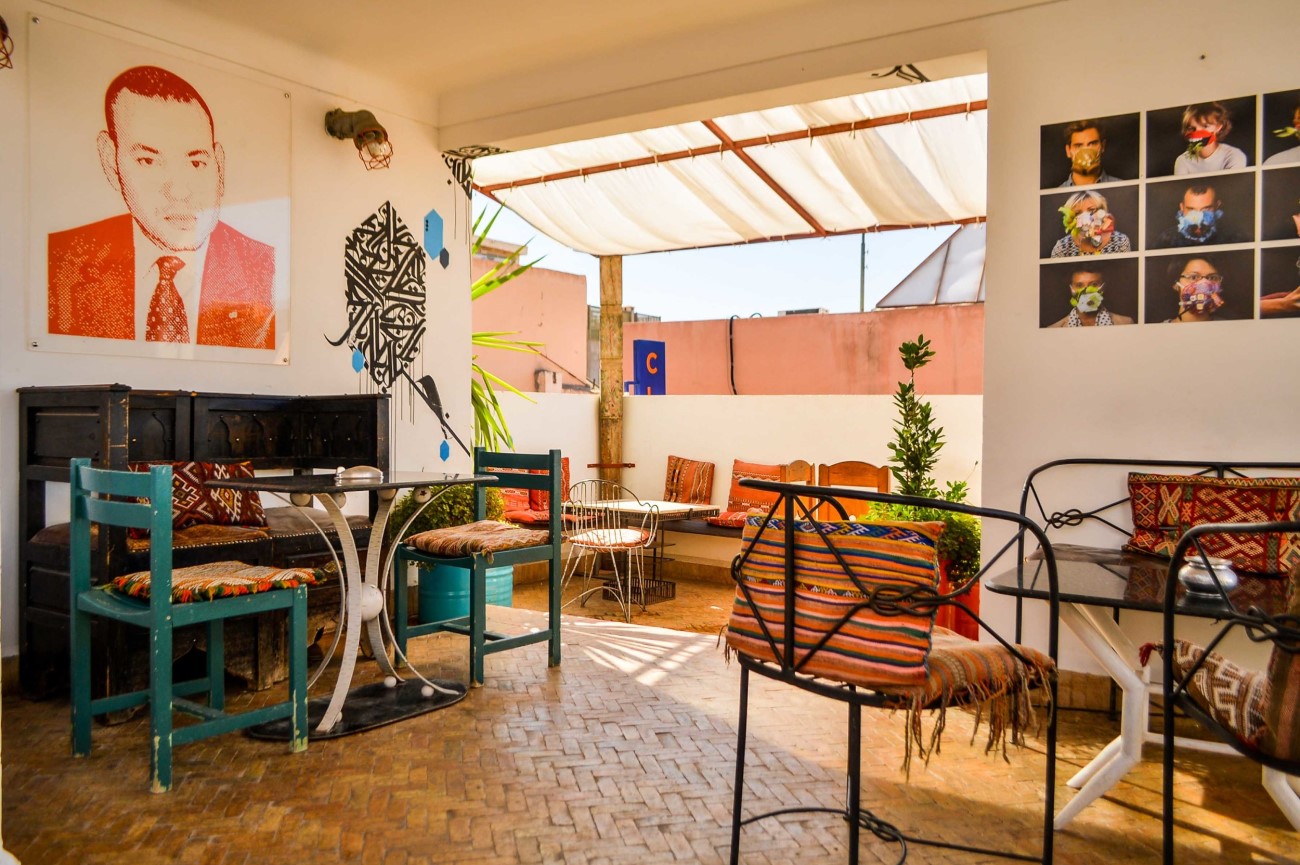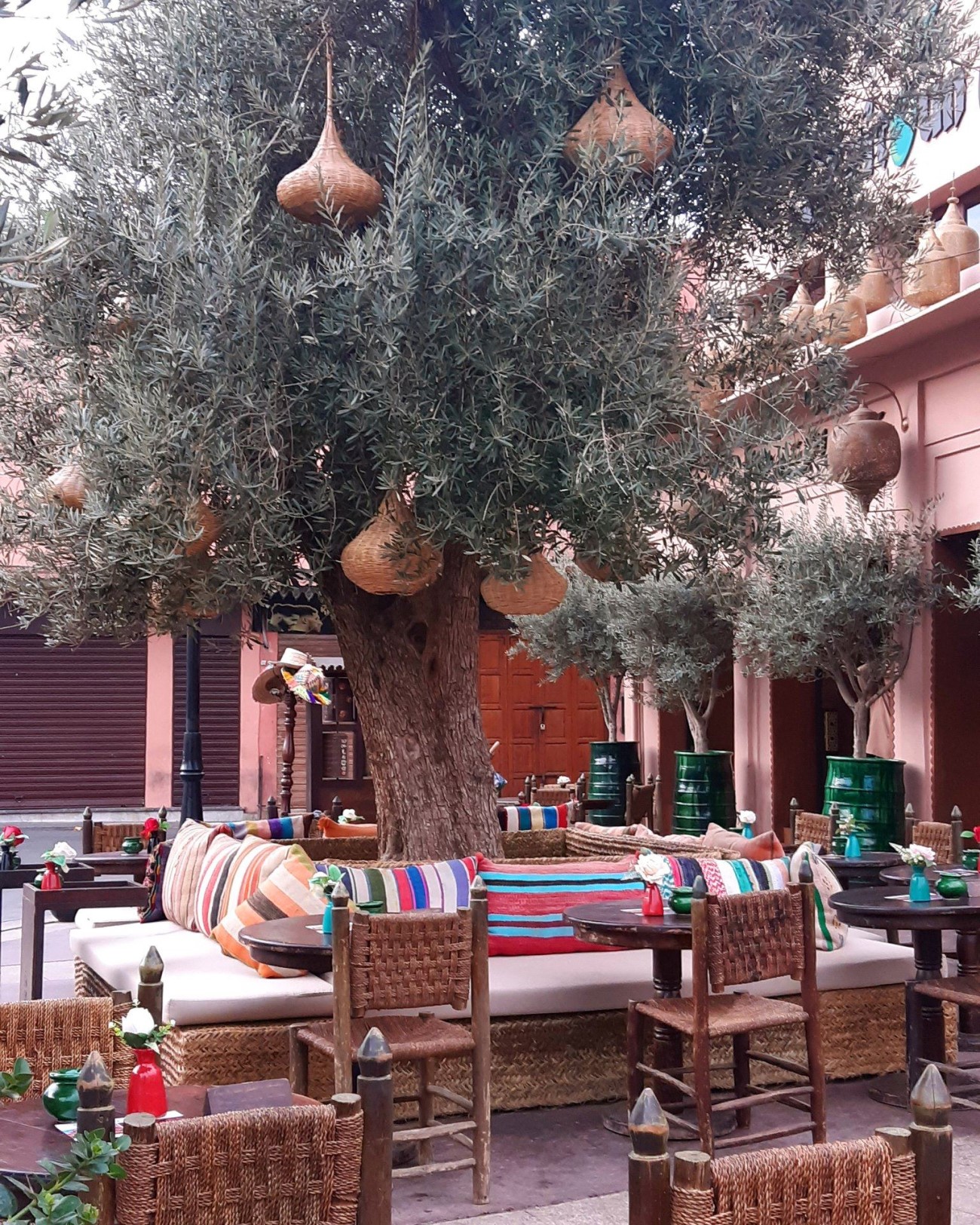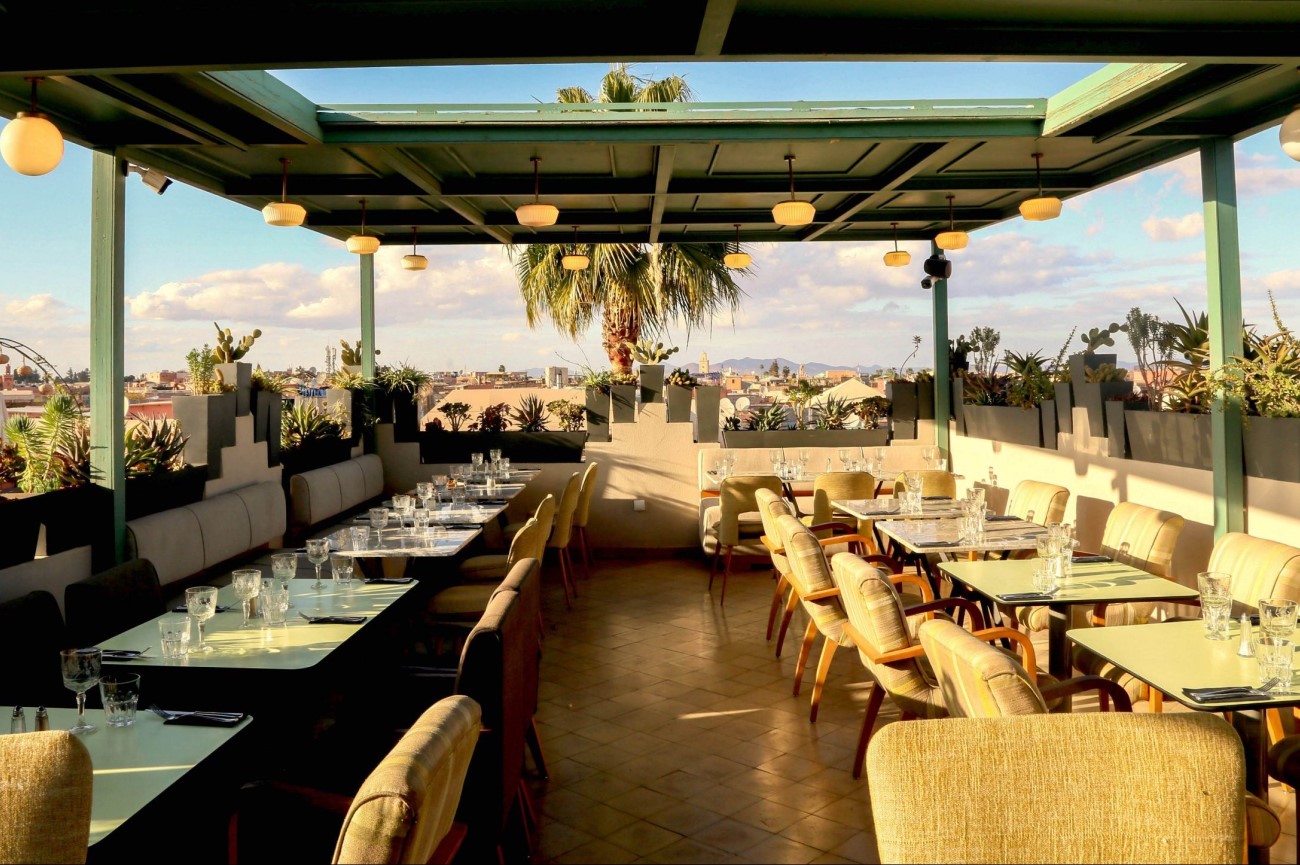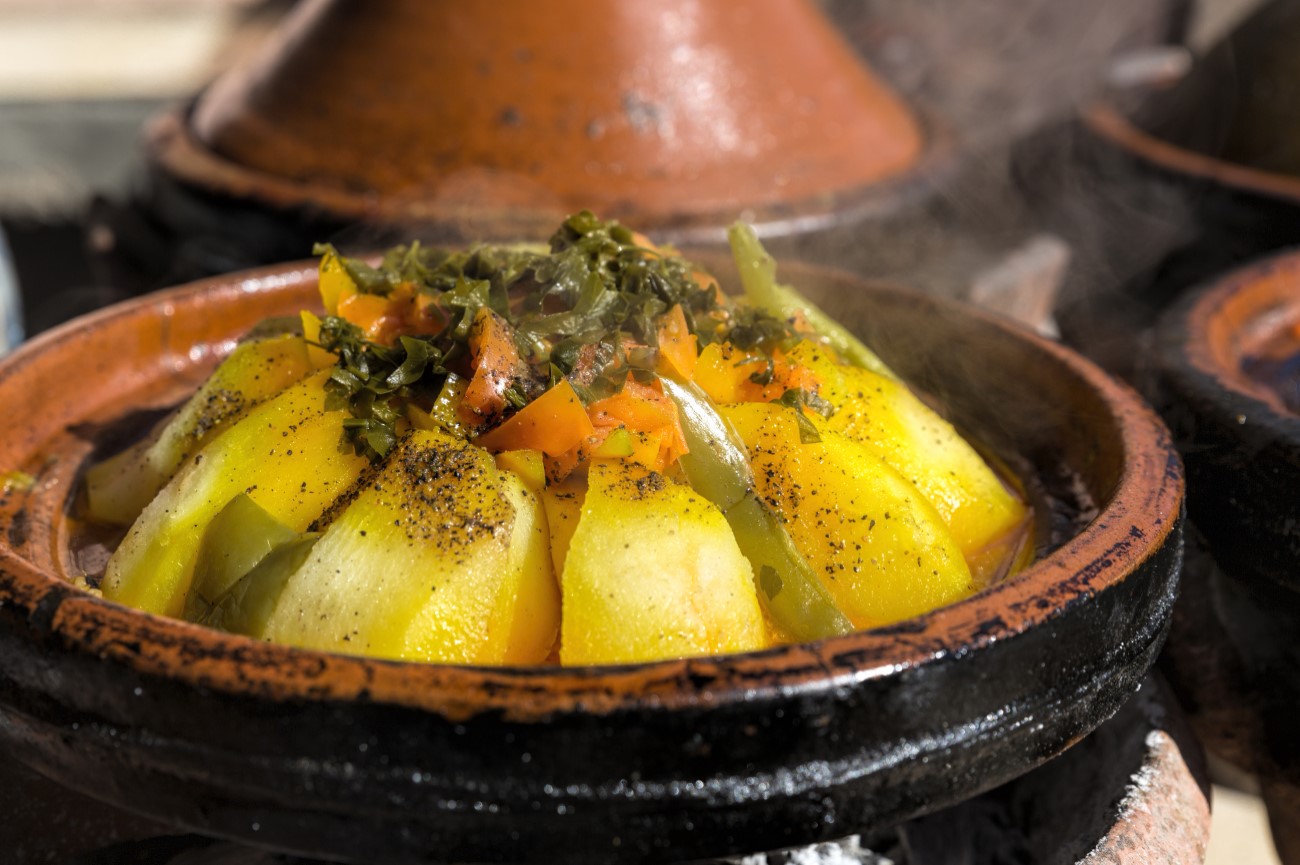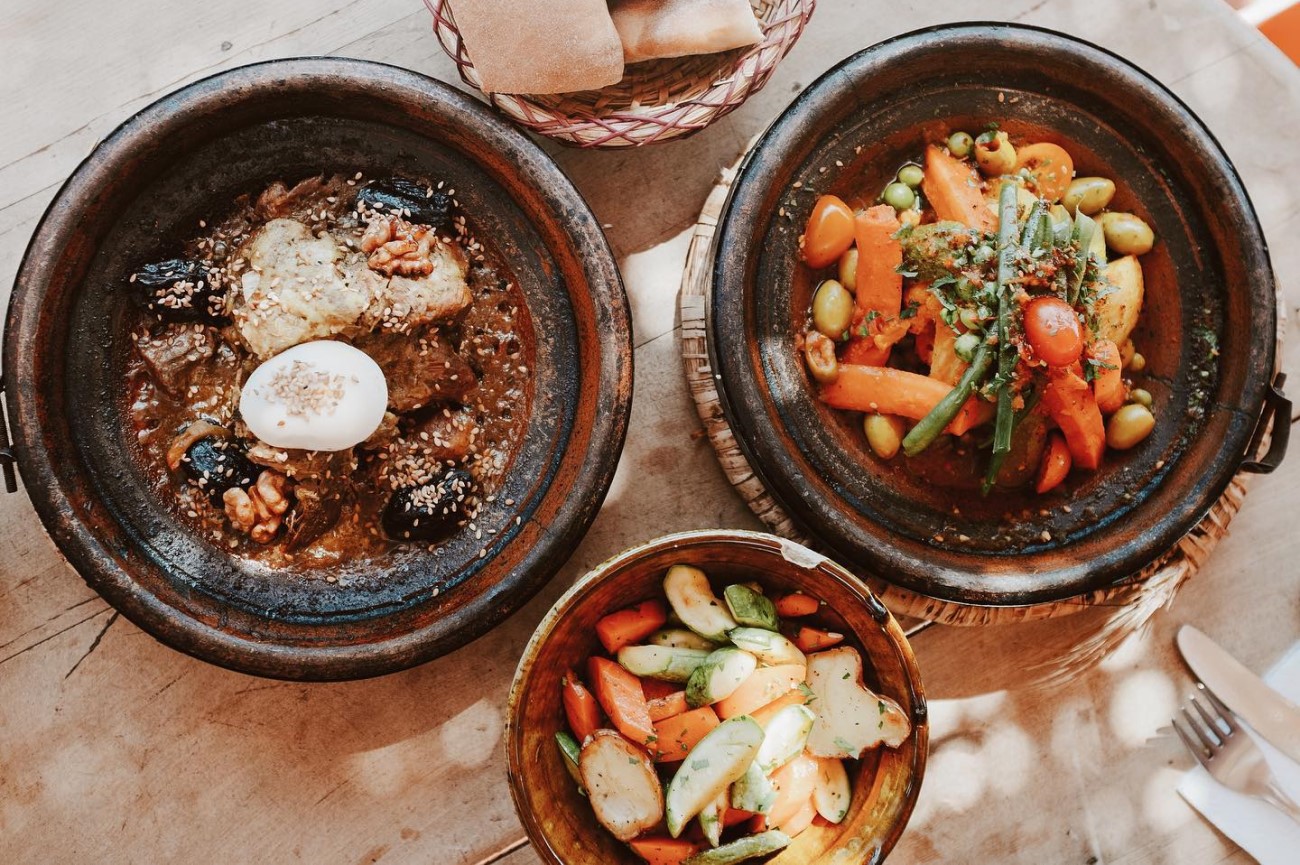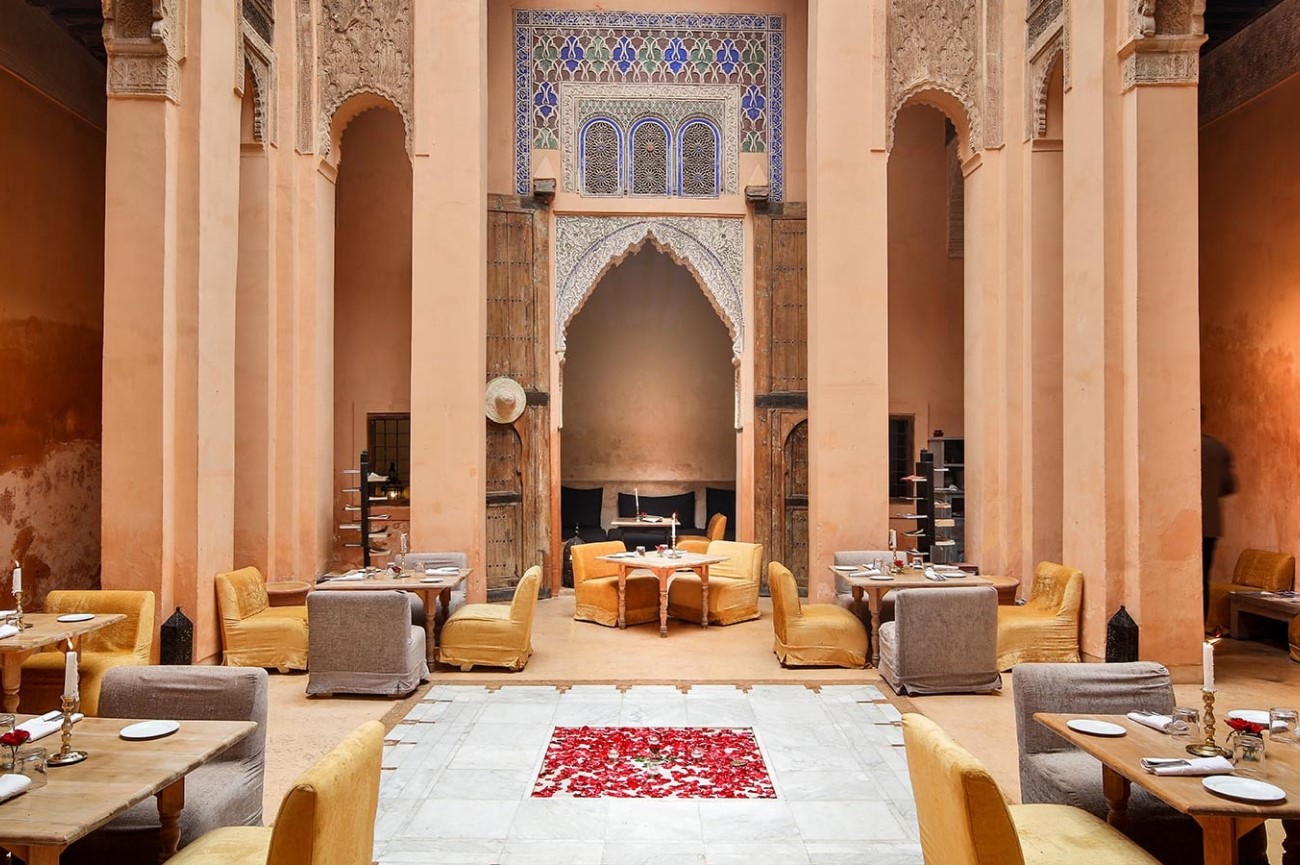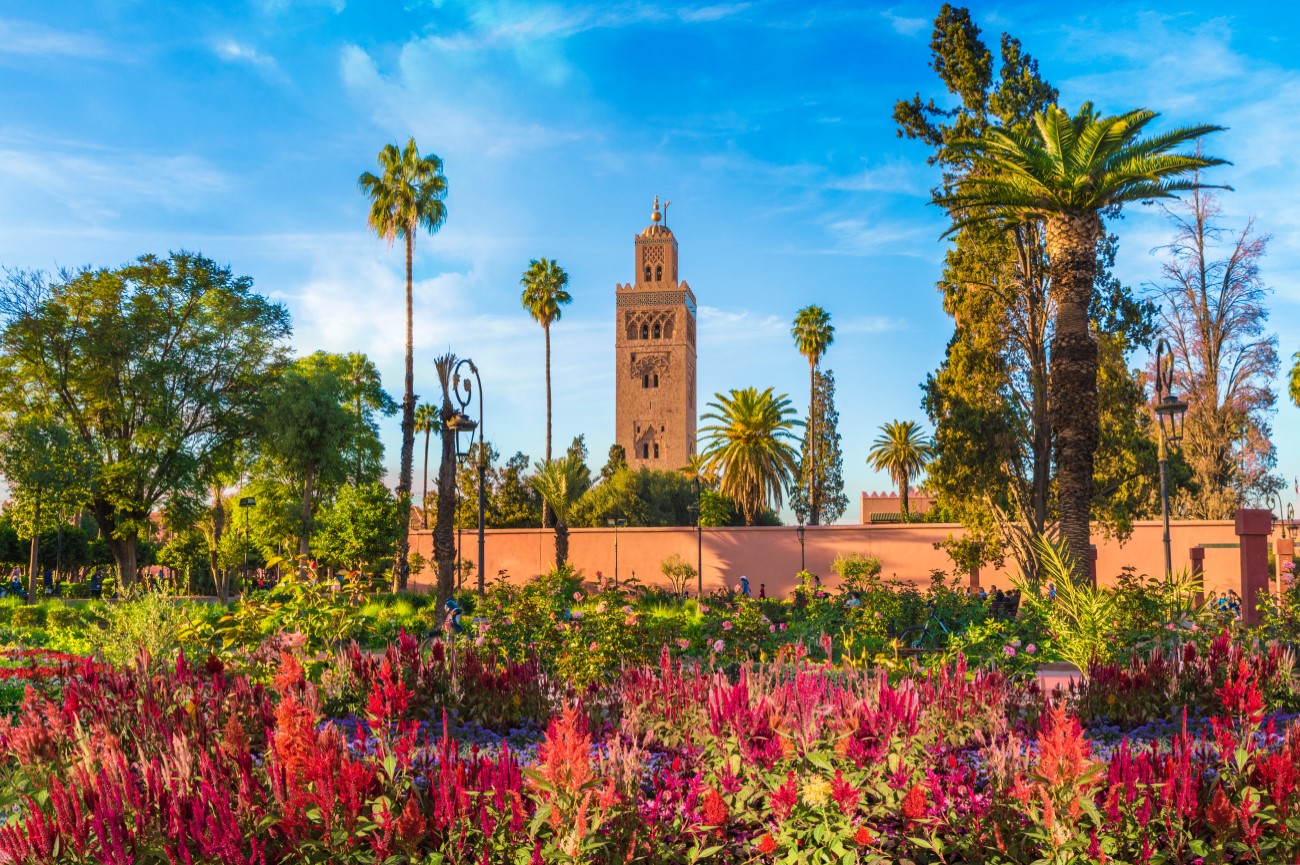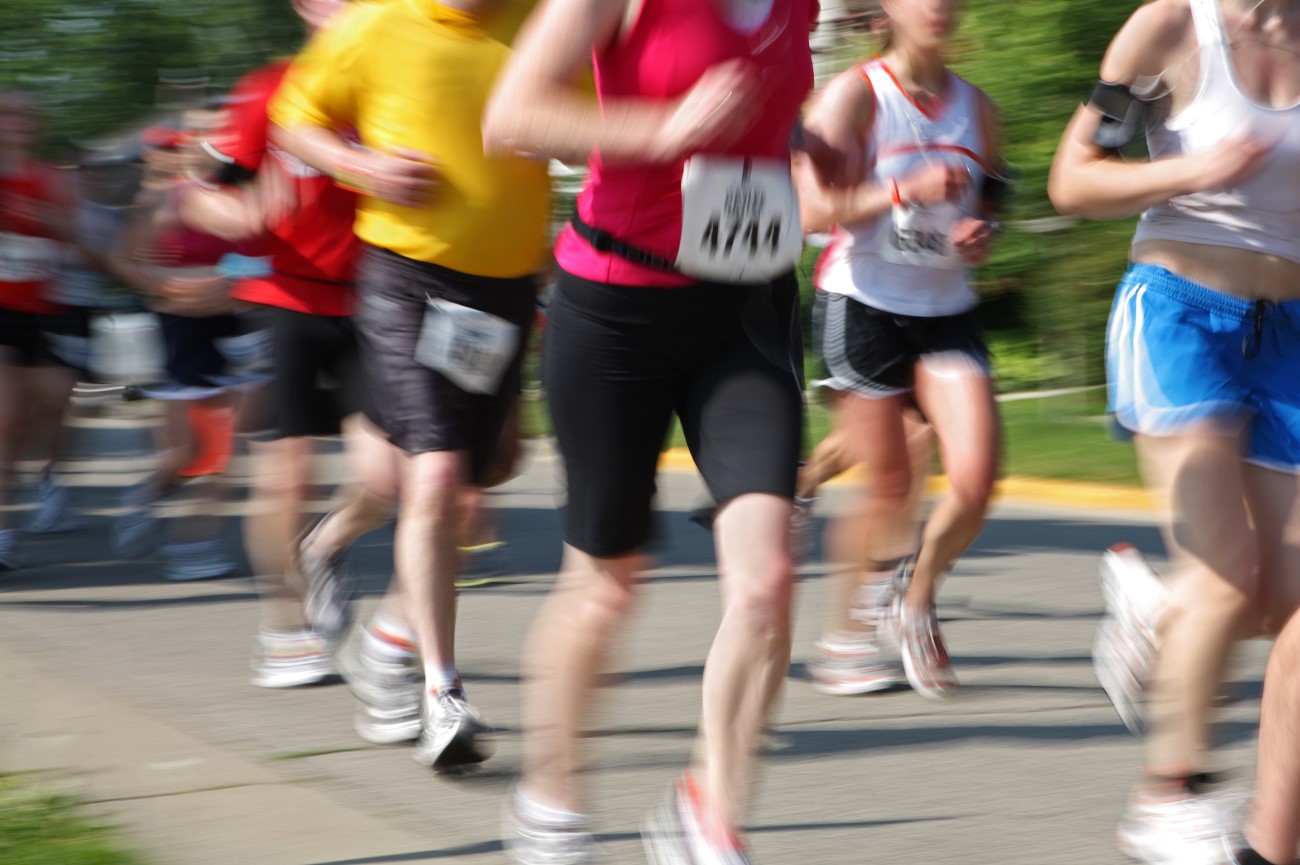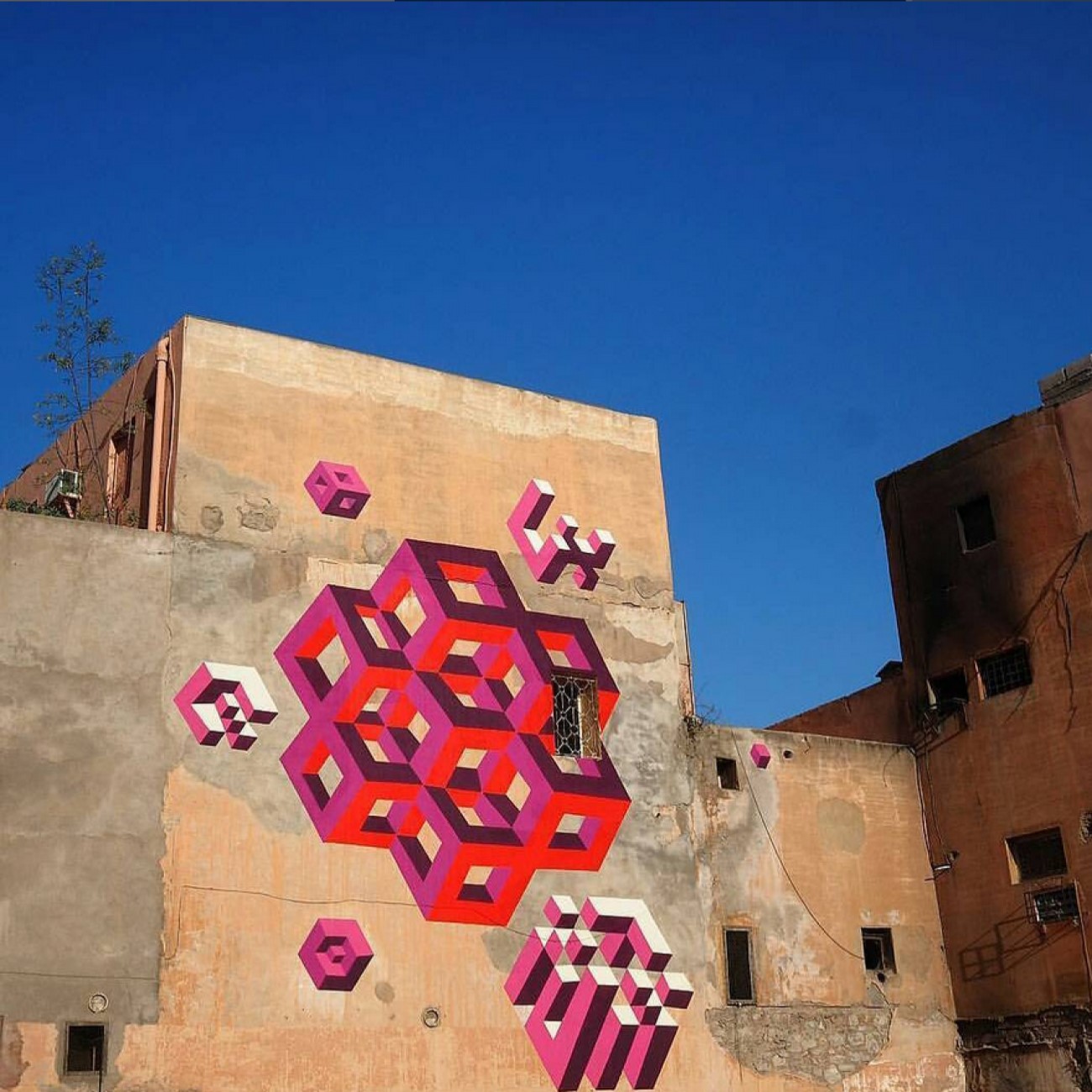Things to do in Marrakech: 3-day itinerary
There’s a reason why Marrakech is the most visited city in Morocco. It has everything you would expect of the country in one place: the bustling souks, the tiled-covered riads and the bubbling tajines. It’s a trip for the senses, as you’ll find out when you’re dodging through motorbikes in the medina’s maze of streets or smelling your way through the spice stalls.
But beyond the historic sites and culinary treats, you’ll also find quirky gardens, art museums and relaxing steam baths, which offer a retreat from the crowds. Our three day itinerary will show you the best things to do in Marrakech, including where to eat and where to stay, plus a few day trip suggestions if you fancy extending your trip.
Day 1

Morning: Koutoubia Mosque
Dominating Marrakech’s skyline, the Koutoubia Mosque is one of the first things you’ll spot when you reach the city centre. Dating back to the 12th century, the building stands out with its sandstone tower visible across the medina. This iconic structure is said to have inspired other religious landmarks like the Giralda in Seville. While the interior is reserved for Muslim prayers, you can still admire the crenellated walls and horseshoe arches from the outside. It’s also worth wandering through the palm-tree-lined gardens, which offer the perfect background for a snapshot of the mosque. Wherever you are in the city, you’ll likely hear the muezzin call echoing from the mosque five times a day, signalling the start of the prayers.
Jemaa el-Fna Square
Slowly make your way to Jemaa el-Fna, the city’s central square and the gateway to the old town, aka the Medina. Coming from the serene Koutoubia gardens, the square can be a bit overwhelming for the senses as you’ll spot snake charmers alongside orange juice sellers and henna tattoo artists all calling for your attention.
The square has been a site for street performances since at least the 11th century. Later, it became home to a giant food market, welcoming traders from the mountains. This evolving cultural exchange earned the square a Unesco heritage title in 2001. One way to escape the crowds is to head up to one of the surrounding rooftop cafés, like Atay Café.
The Souks and Medina
Part of being in Marrakech is experiencing the souks. The maze of streets that branch out from the Jemaa el-Fna Square is packed with all kinds of vendors, selling anything from carpets and leather to lanterns and spices. You’ll have to manoeuvre your way through the narrow alleys while keeping an eye for the speedy motorcycles and the donkey wagons that squeeze through the same passages. You can easily while away a couple of hours looking through the stalls here. If you look at a specific item for a while, you may get a quick quote from the vendor, but you’re more than welcome to negotiate the offer.
Afternoon: Ben Youssef Madrassa
Our next stop is the Ben Youssef Madrassa. Founded in the 14th century, Ben Youssef was once one of the largest Quranic learning centres in Northern Africa. At one point, it welcomed nearly 1,000 students. Today, it attracts almost as many visitors who are keen to capture its ornate courtyard. You’ll see people posing against its colourful mosaic walls, carved woodwork and reflecting pool. Upstairs are the former students’ rooms, which are much more simple and austere.
Marrakech tanneries
A few streets behind Ben Youssef, near the Bab Debbagh gate, are some of Marrakech’s tanneries. In the medieval era, leatherworking was one of the city’s main industries, and it’s still in practice today. It’s not for the faint-hearted, though, as the pungent smell of ammonia takes over as soon as you step near the tanneries. The Association Sidi Yacoub is one of the largest cooperatives in operation, and it welcomes visitors for free, though many will try to entice you for a guided tour. If you don’t fancy tipping your way in, you’re best off booking an official guide who will usually take you there on a Medina tour. In the morning, you can often see tanners bending the leather in their workshops.
Jemaa el-Fna Square
You’ve seen Jemaa el-Fna during the day, but it’s much more vibrant in the evenings. That’s when the night market comes in, with locals setting up a variety of food stalls full of Moroccan treats like tajines, fried fish and snail broth. Catching the sunset from one of the surrounding rooftops gives you another perspective of the city too. Post-dinner, grab a traditional spiced tea, known as khoudenjal, at one of the tea stalls on the southern edge of the square.
Day 1 - Marrakech Tour Map
Day 2

Morning: Bahia Palace
Spend your second day exploring the south side of Marrakech, starting with the Bahia Palace. This 19th-century palace is a feast for the eyes, drawing visitors with its striking tilework floor, carved-cedar ceilings and lush gardens. It was initially built by Grand Vizier Si Moussa but was expanded and embellished afterwards by his successors.
The whole place stretches for nearly 8,000 square metres, but the grand courtyard paved with Italian marble is by far the highlight. Despite its dimensions, only a couple of rooms are open to the public. Also worth checking is the Petit Riad, with its traditional houses resembling the medina. The salon here is covered with verses from the Quran. Meanwhile, the Grand Riad is surrounded by fountains and foliage, and the salon is adorned with colourful stained glass. Be sure to arrive early, if you want to avoid the large tour groups.
Jewish Quarter
Just a few steps from the Bahia Palace is the Mellah, the city’s old Jewish quarter. It’s worth wandering through the streets here and spotting the differences between the area and the medina. You’ll notice more balconies, as well as narrow streets and, of course, a local synagogue. Most of the Jewish residents were ejected here in 1558 by the Saadian Sultan Abdullah al Ghalib. Within the district is a sizeable Jewish cemetery, which is open to visitors.
Afternoon: El Badi Palace
Continue west, and you’ll soon stumble upon the El Badi Palace. Only a few sections remain of this 16th-century building, which was ransacked shortly after it was erected. Today, it offers a quiet respite from the crowds and a nesting site for storks. Spend some time exploring the courtyard gardens and catching the exhibits that cover Marrakesh’s history.
Saadian Tombs
From El Badi, you can easily reach the Saadian Tombs, which sit behind the Kasbah Mosque. This is the resting site of Sultan Ahmad al-Mansur, aka the Golden One, who ruled Morocco during the 16th and 17th centuries. The tombs were built to reflect the sultan’s power and wealth, hence the ornate tiles, Italian marble and plasterwork. The highlight is the Chamber of the Twelve Columns, where the sultan himself and his sons are buried. The surrounding chambers also house other prominent figures of the court.
Day 2 - Marrakech Tour Map
Day 3

Morning: Jardin Majorelle
Start your day in the New City, where you’ll find the Jardin Majorelle. This incredible oasis was initially envisioned by the French painter Jacques Majorelle but was restored by fashion designer Yves Saint-Laurent when he purchased it in the 1980s. The tall cacti and palm trees stand out against the vivid-blue art deco studio, one of the garden’s most iconic buildings. There are hundreds of plant species here hailing from all over the globe. Aim to get here before 10 a.m. to avoid the crowds, as this is one of the city’s most visited attractions. Purchasing tickets online can also help you get in faster. Beyond the gardens, you’ll also find a café, a bookshop and the Musée Berbère, which focuses on Morocco’s indigenous culture. From Friday to Monday, you can also access the adjoining Villa Oasis gardens, which opened to the public in 2018.
Musée Yves Saint-Laurent
Next door to the gardens is the Musée Yves Saint-Laurent. You can get combined tickets for the two and spend your morning touring the grounds. The museum is housed in a modernist building made of Moroccan marble and stone and covered with terracotta bricks that resemble woven fabric. Inside is a collection of sketches and haute-couture outfits by Yves Saint-Laurent. The whole exhibit aims to show how his time in Morocco inspired his work. It was his partner Pierre Bergé who planned this repository.
Afternoon: Maison de la Photographie
In the afternoon, make your way back to the Medina to visit the Maison de la Photographie. This gallery holds an incredible collection of vintage Moroccan photography. The pictures date from the 19th and 20th centuries and were gathered by Marrakshi Hamid Mergani and Parisian Patrick Menac’h, who shared a common passion for photography. There are thousands of pictures in their repository, but only a few are on display in this three-floor building, giving you a glimpse of Morocco’s past. Some of them are available as prints for sale. After checking the exhibit, head up to the rooftop café for tea and a pastry.
Le Jardin Secret
Head a few minutes west towards Le Jardin Secret. Set around a century-old riad, this peaceful garden feels miles away from the bustling Medina. The plants are watered through an ancient underground irrigation system known as khettara. This type of system was introduced by the Almoravids in the 11th century to distribute water across the city’s mosques, fountains and hammams. There are two gardens here, one with Islamic trees such as figs and pomegranate and a more exotic one with plants from around the world.
Hammam
What better way to wrap up your trip to Marrakech than by relaxing in a local hammam? These steaming baths are scattered across the city, with a mix of private and public options. Les Bains d’Orient in the heart of the Medina is among the most popular, offering a variety of rituals and massages. At the end, you can treat yourself to a tea on their rooftop terrace.
Day 3 - Marrakech Tour Map
Day trips from Marrakech
- Atlas Mountains: Take a day trip to the Atlas Mountains to see traditional Berber villages and enjoy the surrounding countryside. Many tours include stops at the Unesco-listed Ait-Ben-Haddou, a fortified village featured in films and series like Game of Thrones. You may also get a chance to see the Atlas Film Studios, one of the world’s largest film studios, located in Ouarzazate. To really make the most of it, it’s worth spending the night in the area.
- Ouzoud Falls: Also within the Atlas Mountains are the Ouzoud Falls. At 110 metres, it is one of the highest waterfalls in Africa. It takes about 3 hours to drive here from Marrakech. The best spot to capture the waterfall is from the El-Abid Canyon, where the water drips to. You can enjoy a swim in the river or take a boat ride along the area. If you’re lucky, you may spot a few wild monkeys.
- Ourika Valley: About one hour south of the city is the picturesque Ourika Valley. Visitors love to come here for a cup of tea and a meal overlooking the river.
- Agafay Desert: If you want to visit the desert but don’t fancy travelling all the way to the Sahara, the Agafy may be a good alternative. A 40-minute drive from Marrakech, this stark desert offers similar activities, including camel rides, quad biking and overnight camping.
- Essaouira: If you want a glimpse of the sea, head to Essaouira, a coastal town 120 miles west of Marrakech. Circled by medieval-style walls, the town stands out with its whitewashed houses. More than sunbathing, Essaouira is popular for windsurfing and kitesurfing thanks to its regular wind. If you’re looking to surf, you’re best off heading further south to Point Imsouane or Taghazout.
- Casablanca: About 3 hours north of Marrakech is Casablanca, one of the biggest cities in Morocco. Set along the Atlantic and packed with modern buildings, it offers a change of scenery from the old medina. This is mostly a commercial city, but there are a few historical attractions like the Hassan II mosque or the Mahkama of Pacha, a parliamentary building with plenty of Moorish details.
Best golf courses in Marrakech
There are about 12 golf courses in and around Marrakech, each with its own unique features. The most popular ones are the Assoufid Golf Club, the Royal Golf de Marrakech, the Golf d’Amelkis and the Al Maaden Golf Resort. Of those, the closest ones to the centre are the Royal Golf and the Amelkis, both a 15-minute drive away. The Royal is also among the oldest golf courses in Morocco, founded in 1923. A bit further is the Assoufid, one of Morocco’s best golf courses set along the desert. Many of these offer views of the Atlas Mountains, making it a unique playing experience.
Racecourses in Marrakech
All the racecourses in Morocco have sandy soils, and Marrakech’s is no exception. Inaugurated in 2017, the Marrakech racecourse (Hippodrome de Marrakech) is a circular track that stretches for nearly 1400 metres. It hosts several international competitions, with races held from February to June and September to December, though there’s a focus on the Arabian sector. If you’re coming from the centre of Marrakech, it’s a 30-minute drive west.
Things to do with kids in Marrakech
Morocco as a whole is very family-oriented, and kids are welcome in most places in Marrakech. Though the city can be a bit chaotic at times, there’s also room for relaxation. Allow plenty of time to explore the city’s iconic monuments and choose a hotel with kid-friendly facilities. A pool may be nice in the summer, but you can also get a day pass to a hotel or visit the nearby water park Oasiria.
Although there aren’t many playgrounds, there are plenty of gardens where you can unwind. Cyber Park and the Jardin Harti are a few free options. If you're looking for a camel ride, head to Palmeraie, a few miles north. Alternatively, you can book a desert tour.
If you have smaller children, check out amusement parks like Paloozaland and Ludiparc, both of which are located a bit further out. Also on the outskirts is the Anima (André Heller Garden), a huge botanical garden filled with colourful sculptures that are worth exploring with the whole family.
Another fun activity is to sample the city's culinary treats by joining a food tour or a cooking class. Some hotels may organise this for you, but you can also reach out to services directly, like the Amal Women’s Center.
Where to eat in Marrakech
- Atay Café: Overlooking the Koutoubia Mosque, this rooftop café offers delicious Moroccan treats, such as tajine and pastilla, a pie stuffed with spiced chicken. They also have other snacks, like burgers and salads.
- Jemaa el-Fna: Marrakech’s central square comes alive in the evenings when a food market takes over the streets. You’ll find endless stalls selling traditional dishes such as snail broth, slow-roasted lamb and couscous. Have a look around and sit wherever you like.
- Pepe Nero: Set around an inner courtyard lined with mosaic floors, Pepe Nero specialises in Italian and Moroccan cuisine. The prawn risotto is a favourite, and there’s a good wine selection too.
- Al Fassia: Close to the New City, this restaurant serves a variety of Moroccan dishes. Highlights include the pigeon pastilla and the lamb shoulder.
- Cafe Clock: More than a café, Clock is a cultural venue hosting live gigs and storytelling sessions. Come here for burgers (try the camel one if you dare), milkshakes and an overall friendly atmosphere. It’s located a few miles south of the Saadian Tombs.
- Marrakech Henna Art Café: Close to Jemaa el-Fna, this laid-back café focuses on Moroccan and fusion cuisine, including vegetarian and vegan alternatives. You can stop here for a meal or an afternoon snack on your way to the square. They also have certified henna artists who can tattoo you on the spot.
- Un déjeuner de Marrakech: Just above the shopping street of Zitoun el Jdid is this picturesque rooftop restaurant. The menu focuses on Moroccan cuisine with a contemporary twist. Try the pea hummus and the meat couscous.
- Snack Grand Atlas: For tajines and delicious seafood (grilled or fried), head to the Snack Grand Atlas, a few steps from Jemaa el-Fna.
- Café des Épices: Open from breakfast to dinner, the Café des Épices is a great spot for people-watching, as it sits right above the souks. Come here for a mint tea or try one of their many tajines.
- Dar Cherifa: Housed inside a traditional riad, this Morrocan restaurant is as much a treat for the eyes as it is for your belly. Specialities include pastillas and tajines, including one with camel meatballs.
Where to stay in Marrakech
- Mandarin Oriental Marrakech (5 stars): Spread across 20 hectares, the Mandarin Oriental Marrakech offers a luxurious retreat for your holidays. It’s located about a ten-minute drive from the Medina, so you can escape the city bustle. The hotel features a mix of suites and private villas with up to four bedrooms, many of which come with their own swimming pool. Guests also have access to multiple restaurants, bars and a luxury spa.

- Mamounia Hotel (5 stars): Open since 1923, the Mamounia has had its share of famous guests, from Winston Churchill to Alfred Hitchcock. The accommodation ranges from suites to exclusive riads that welcome up to six guests. In addition to this, the hotel features 5 restaurants, 4 bars, tea rooms and a spa with a hammam.

- Riad BE Marrakech (4 stars): This cosy riad is only a few minutes away from Le Jardin Secret. The colourful interior adorned with Morrocan tiles immediately gets your attention, and it spreads all the way to the bedrooms. The hotel also organises plenty of activities, from yoga lessons to souk tours and cooking classes.

- Riad Karmela (4 stars): This B&B offers a mix of rooms and apartments for larger groups. Common areas include charming patios, a restaurant and a terrace, where breakfast is served in the summer. The staff can also arrange excursions from Marrakech to places like Ait-Ben-Haddou or Essaouira.

- Riad Tizwa Marrakech (3 stars): The Riad Tizwa has been named one of the top 10 riads in Marrakech by The Guardian. Most of the rooms offer views of the inner patio, and some feature a private terrace. The friendly staff is always at hand to give you recommendations throughout your stay.

- Boho 27 Marrakech (1 star): If you’re looking for a budget alternative, the Boho 27 is a great option. Guests can choose between private rooms and dorms. There’s also a rooftop terrace where you can retreat after a busy day of sightseeing.

Best time to visit Marrakech
The best time to visit Marrakech is around spring or autumn, for sunny days and mild temperatures. Visit between March and May to experience the city’s gardens in bloom and make the most of the rooftops. The evenings are slightly cooler in autumn, so be sure to bring an extra layer if you’re planning on being out late. Note that Ramadan is is set by the Islamic lunar calendar (Hijri calendar), so some places may have limited opening hours until sunset. Summers can be scorching, with temperatures often going beyond 40ºC. If you plan to come around this time, save your sightseeing for the mornings or evenings to avoid the heat. Winter, on the other hand, can be pretty chilly, with some areas like the Atlas Mountains receiving snow.
Marrakech Festivals
- Marrakech Marathon: Around January, Marrakech hosts its annual marathon. Runners from all over the world head here to race through the city’s winding streets, past orange trees, lush gardens and historic buildings. The event also includes a half-marathon and a short trail for kids.
- Marrakech International Film Festival: Since its foundation in 2001, the Marrakech International Film Festival has attracted plenty of filmmakers and actors. Usually held on the last week of November, it includes plenty of screenings and masterclasses. These take place across the city’s cinemas, but also at the Jemaa El-Fna Square, where a giant screen is set up.
- Marrakech Biennial: Every couple of years, Marrakech welcomes local and international artists to display their work across the city. The festival usually stretches between February and May and is accompanied by exhibits and lectures. Most of the program focuses on the intersection between Europe and Africa, where Morocco stands.



